Since publishing the my B&W ISO Showdown last year, a new Leica Monochrom contender has entered the ring. And it's not an M. The Q2 Monochrom is the first non-M camera to get the purely black and white treatment under the hood. When I first tested it out with some real-world shooting, I was absolutely smitten with the Q2 Monochrom's combination of image quality, low light prowess and ease of handling. But a lot of people still wanted to know how the Q2 Monochrom stacked up to its color sibling, the Leica Q2 when converting to B&W. As did I.
But we had another camera to put to the test as well. The M10-R was also introduced following my ISO roundup last year. In that article, I pitted the M10 Monochrom against the M10-P, which while certainly illuminating, required some additional methodology adaptations. See, the M10 Monochrom was, at the time, the first and only 41 megapixel Leica M camera. The M10-P was, and still is, 24 megapixel. Differing resolutions inherently complicate any per-pixel comparisons. And now we can definitively clear the air, as the M10-R and M10 Monochrom share the same underlying 41 megapixel sensor architecture, with one being fitted with a color filter array and the other omitting the CFA, tuned for pure monochrome performance.
Another benefit of the resolutions of all the cameras being so close this time around is that we also have a chance to test the Q2M against the M10M, for those wondering which modern Monochrom would make a better addition to their Leica kit. Alright, on with the test.
Some Caveats
Before we dive in too deep, let’s get the caveats out of the way first. Tests like this are, by definition, pixel-peeping. And I know that many don't consider that a positive thing. Personally, I favor a more holistic approach, but do value the clarity of a well-designed, controlled test.
When evaluating a new camera for a full review, I form my opinions by venturing out and using it for real work. Actual results under various lighting conditions, with a wide variety of subject matter serve as the foundation to my review. I don’t actually start writing a single word until I’ve had ample time to both shoot and process the resulting images, in order to get a clearer picture of the character and capabilities of the camera. If you want to see that type of review, check out the one I did on the Q2 Monocrhom, or on the M10 Monochrom:
But even that’s not the whole story. See, there is far more to judging the strength of a photographic tool than image quality alone. How it feels in hand, the sound of the shutter, the clarity of the viewfinder, the ease and accuracy of focus, interaction with the UI, overall responsiveness, etc. Only after considering the total experience of using a camera, can I truly develop a cogent assessment of it as a photographic tool. I’m a photographer first and foremost. My reviews are always taken from that perspective.
And while I place heavy emphasis on real-world shooting, there is undeniable value in understanding the critical performance envelope of a camera under ideal test conditions. Knowing, empirically, how the camera will perform when you push it to its limits, allows you as a photographer to work within those parameters comfortably and confidently. More insight and understanding into our tools is never a bad thing. So, let's not hate on the pixel-peeping this time around, ok?
Okay, more caveats.
Testing is difficult. Testing is imperfect. And no single methodology will be ideal. But, I’ll explain my approach and reasoning behind the decisions. Starting off, let's take a look at our contenders for this showdown:
| Camera | Resolution | ISO Range | Sensor Type |
| Leica Q2 Monochrom | 47 MP | 100 – 100000 | Monochrom |
| Leica Q2 | 47 MP | 50 – 50000 | Color |
| Leica M10 Monocrhom | 41 MP | 160 – 100000 | Monocrhom |
| Leica M10-R | 41 MP | 100 – 50000 | Color |
The good news is that resolutions are close, as are the ISO ranges. These are much smaller disparities than we've had to contend with in the past. Sure, there are some variations but we can easily deal with them.
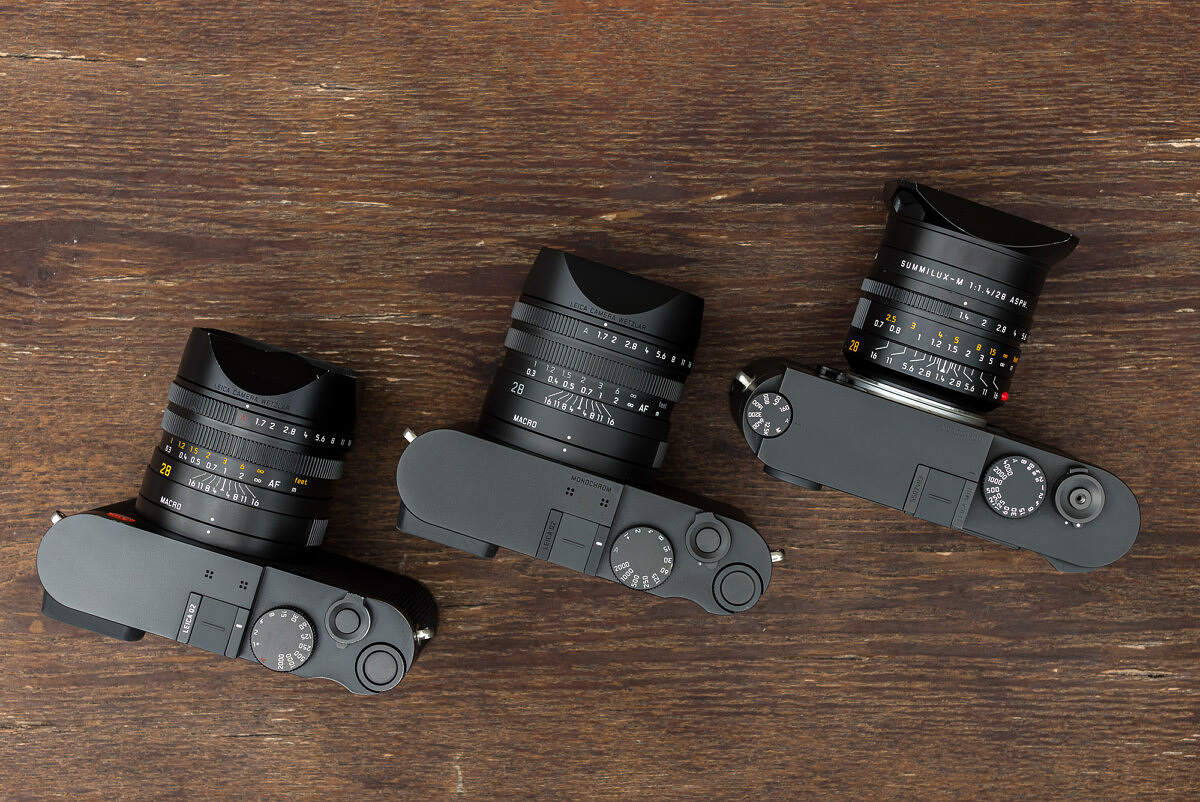
Designing the Test
To maintain the most level playing field possible, I needed to adjust some of my testing approaches. Usually, I test every camera using the same exact lens – the exceptional APO-Summicron-M 50mm f/2 ASPH. Using the same tripod position and same lens with the same focal point eliminates unwanted variation and lets us compare sensor versus sensor, effectively removing the lens from the equation. This time around, things would be slightly more complicated.
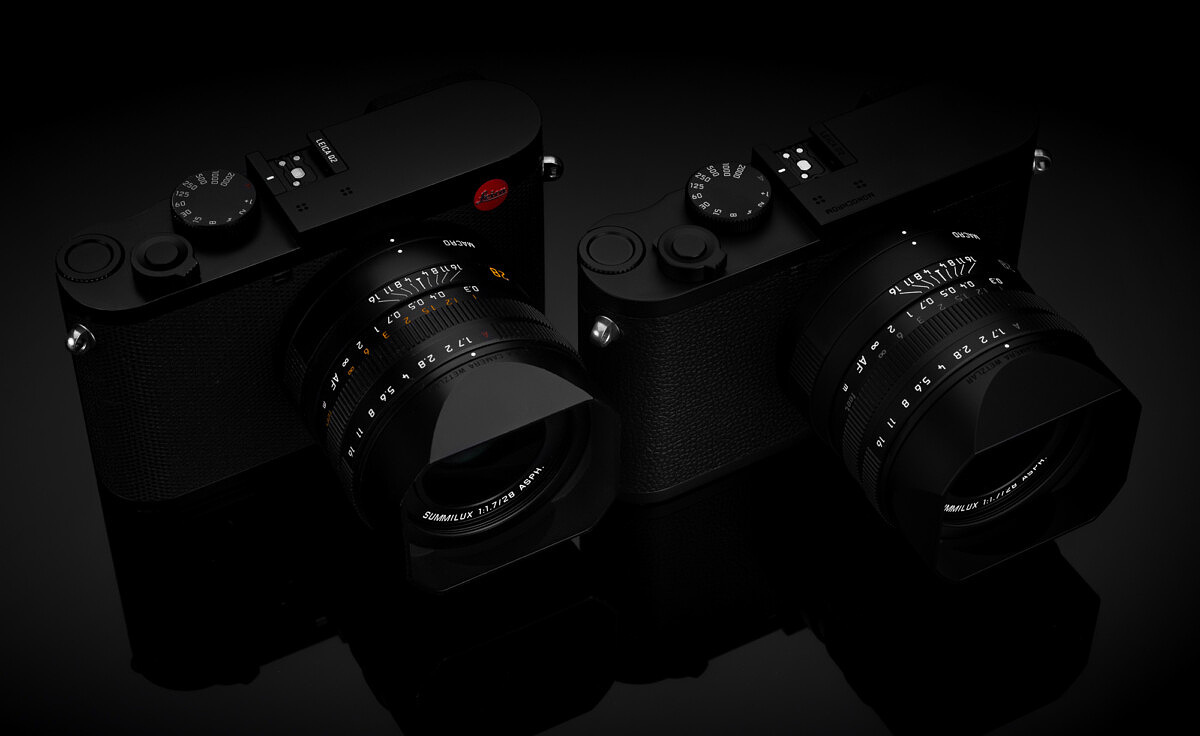
The Q2 and Q2 Monochrom do share the same lens, the outstanding 28mm Summilux f/1.7 ASPH, which is permanently bolted onto the front of the camera. If I really wanted to test against the two M cameras, a 50mm clearly wasn't going to work. So, I went with the best 28mm lens in the roster, the Summilux-M 28mm f/1.4 ASPH. To remove the optical differences from the test as much as possible, I stopped down all lenses to f/8, theoretically hitting their diffraction-limited performance maximums, as well as gaining some much needed depth of field for my test subject. Still, this isn't 100% ideal since, at the end of the day, these are two different lenses.
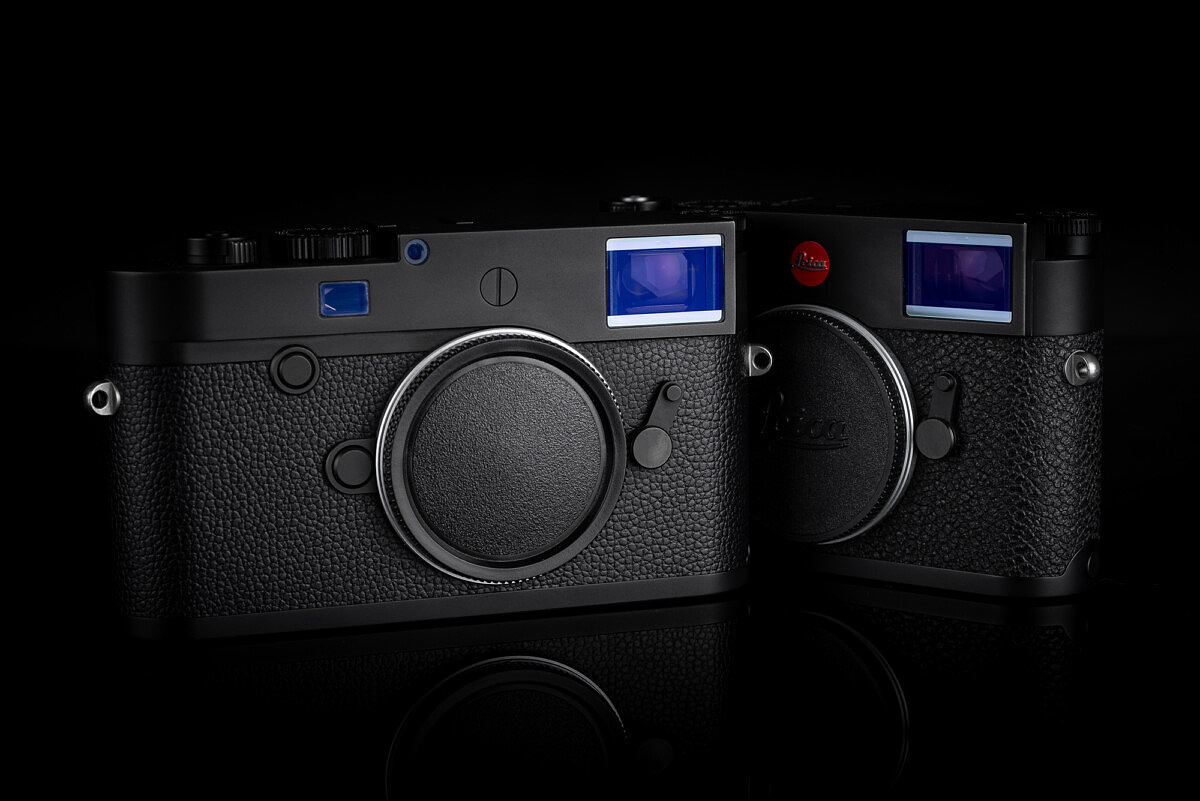
And predictably, I did run into a couple challenges. The first is that setting up a tabletop still life for 28mm is much more difficult than doing so for 50mm. The background needs to be extremely wide behind the subject, the subject itself needs to fill the frame as much as possible, and the camera angle relative to the subject needs to be as close to level as possible to avoid keystoning. Adding a little more complexity was the fact that the minimum focus distance on the Q2 is 0.3m in normal mode and the 28mm Summilux-M is 0.7m. I didn't want to shoot either lens at its minimum distance, again, trying to level the playing field optically. So, I settled on a 1m test distance, the same that I usually use for my 50mm tests. That resulted in a very wide scene which proved compositionally to be…not that great. I simply didn't have enough props to fill the frame, nor was I able to make meaningful use of the top or bottom of the frame. Look, this isn't a prize-winning still life picture, just one setup for the purpose of testing, so please bear that in mind.
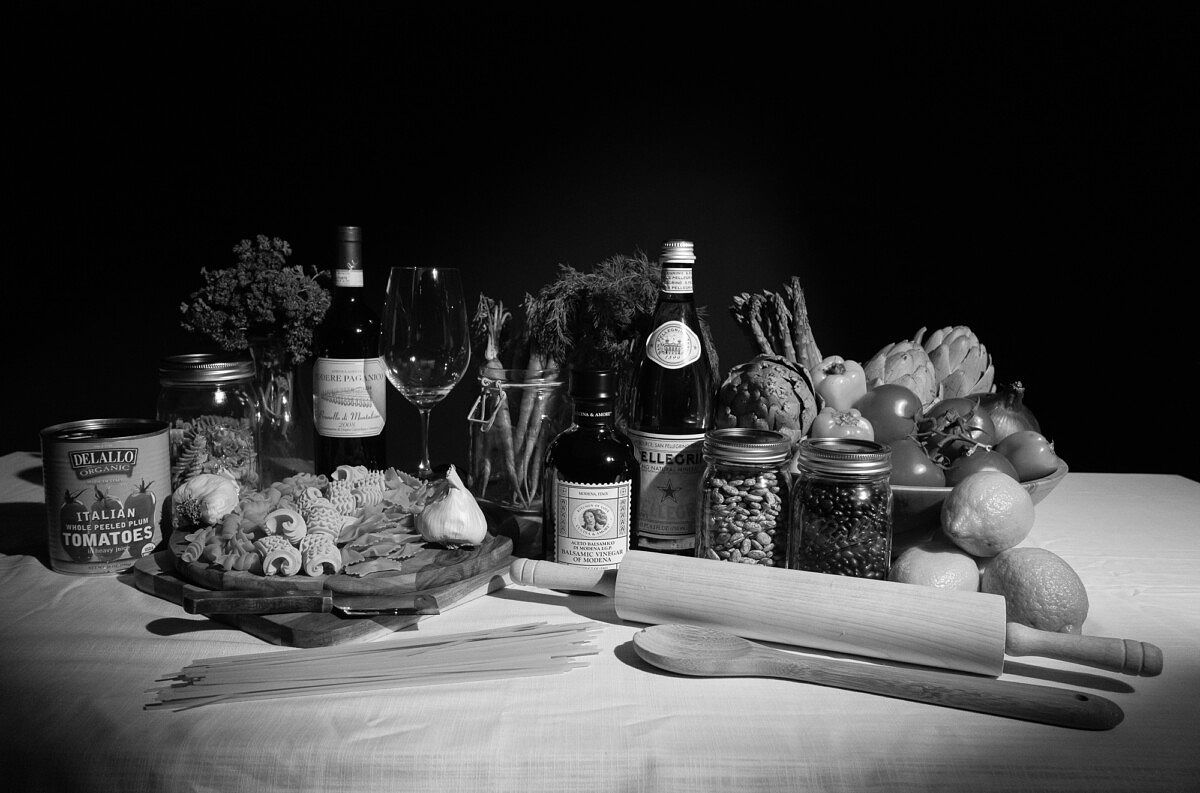
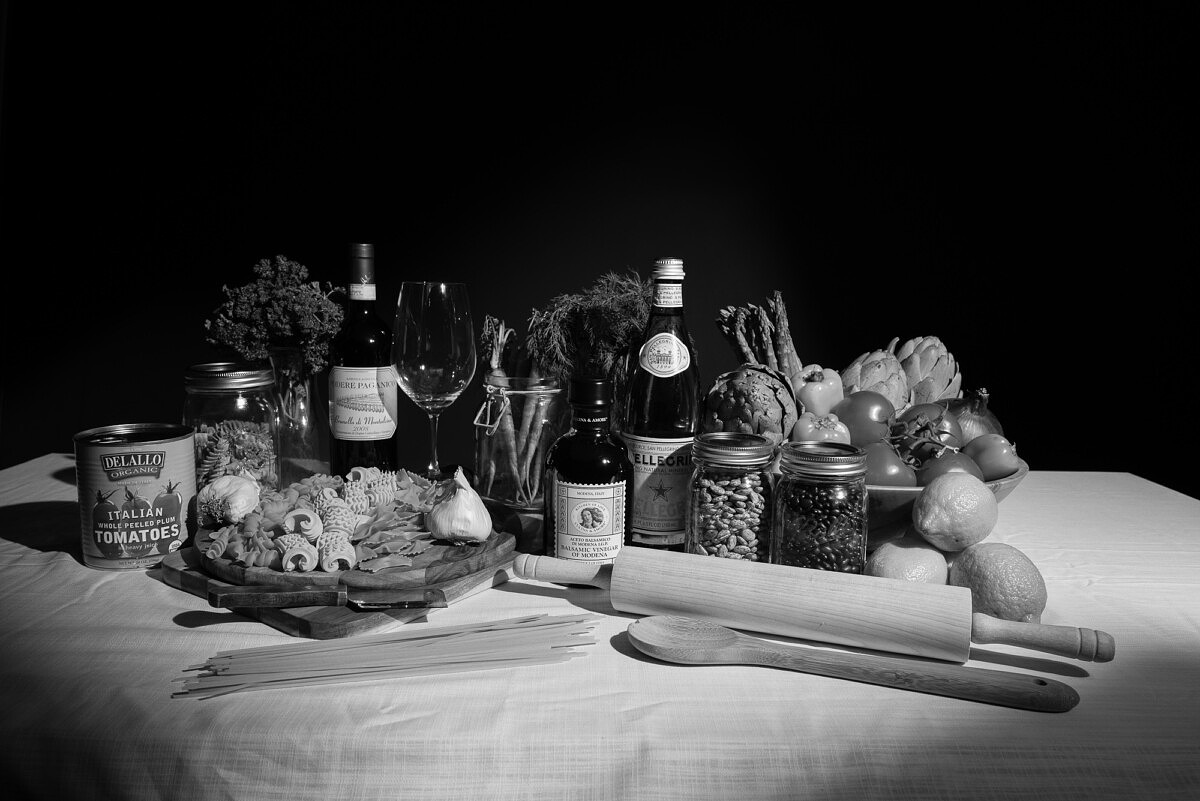
Not all 28mm lenses are actually 28mm
One unexpected yet wonderfully fortuitous complication was that the effective focal length of the two 28mm lenses tested here weren't the same. Turns out that the lens on Q2 is either slightly wider than 28mm, that the 28mm Summilux-M is slightly longer than 28mm, or a combination of the two. The convenient result was that the very slight focal length difference almost completed negated the six megapixel discrepancy between the 47MP of the Q2M and the 41MP of the M10M. Happy accident indeed, as no further pixel scaling was necessary in processing or file prep.
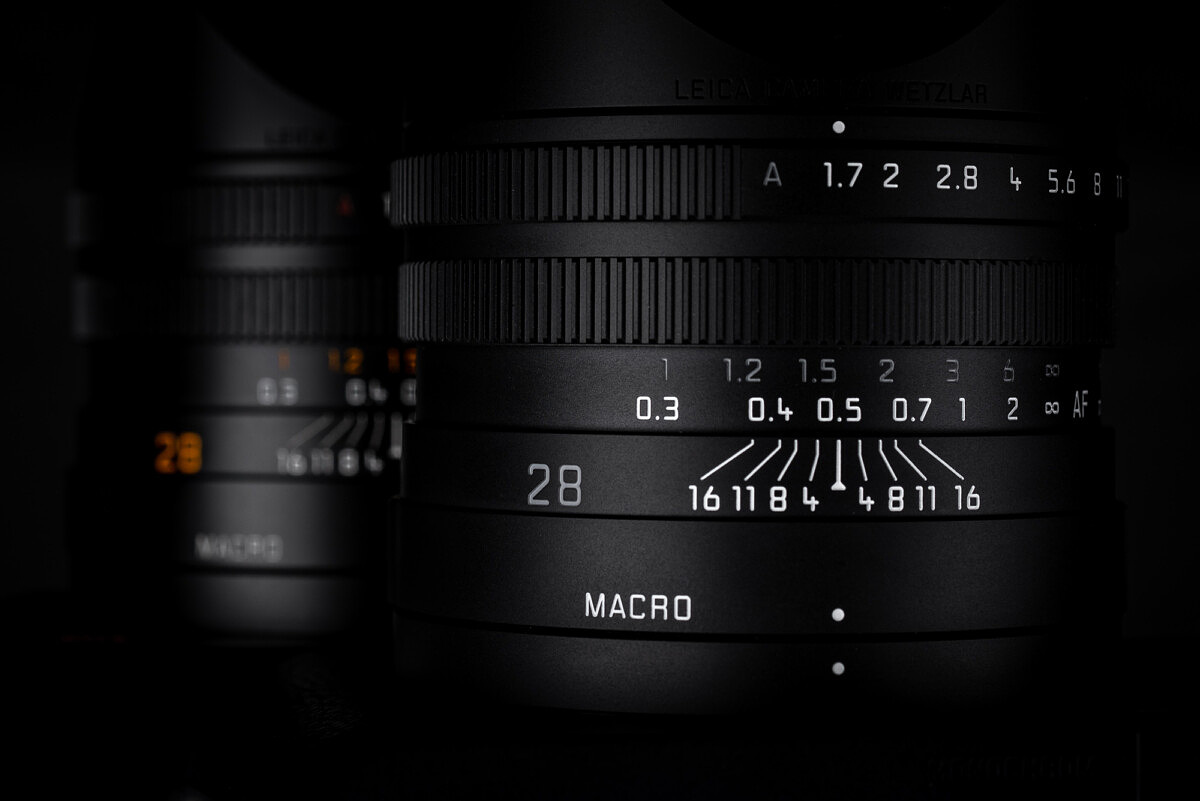
Lighting and Technique
Like my last test, I opted to use a hard light source in order to exaggerate the highlights and shadows. A softbox would have made for an easier test subject and more even illumination, but I wanted to make things a little more challenging from a dynamic range perspective. Again, it's not the prettiest because it is just a test. For lighting hardware, we're using the same Intellytech LightCannon F-165 Bi-Color High Output LED Fresnel as last time. Flicker-free and with a CRI of 97+, this is a highly-accurate constant illumination professional-grade cine light source.
Arca-style quick release plates were used on all cameras so that the same camera position could be maintained during testing. This time around I used the beefy Colorado Tripod Company 4-Series Centennial Tripod with Medium Ballhead. The adjustable clamp really came in handy here to accommodate the minor variations between QR plates.
ISO Range
Showing every single ISO value on all cameras wasn't feasible. Not only do the lowest and highest values differ, the Q2 and Q2 Monochrom only have whole ISO values, not thirds like the M cameras. This is slightly problematic as performance differences are typically apparent with small changes towards the upper end of the range. But since half the competitors here are limited to whole stops, that's what I'm showing. I do include the entire range of ISO values in the downloadable full-size files for the M10-R and M10M, and I did use these in determining the ideal maximum ISO values for these cameras.
At the top of the range, I let the M10M and Q2M strut their stuff and show results all the way up to each camera's respective maximum of ISO 100000. And since the M10-R and Q2 don't go as high, I freeze them at their upper limits of ISO 50000. Bear this in mind when looking at the comparison images. While only showing the changes in the M10 Monochrom and Q2 Monochrom from ISO 50000, I do think quantifying the improvement relative to the other cameras is useful.
I decided against underexposing and pushing the exposure in post processing to emulate even higher ISO values. The reality is that while possibly interesting to some, I can't realistically imagine anyone actually doing this in a real shooting scenario.
Crops
For the image crops, I selected three zones. The label of balsamic vinegar bottle was the true focal point for all cameras, and demonstrates high-contrast high-detail. The wood grain of the rolling pin in front of the bottle also provides some nice fine, lower contrast detail. The ridged pasta crop highlights textural details and tonal range, along with the cutting board and cheese knife. And the black beans in the glass Mason jar crop shows dark areas of detail, along with brighter spectral highlights on the metal lid and glass itself. There are other interesting crops that I explored as well, but there are already far too many images here as it is – well over 100 comparison images in total.
Image Processing and Noise Reduction
Ok, let's get this one out of the way. The samples below are not Straight Out Of Camera (SOOC). All the comparison images were processed using basic tone adjustments in the latest version of Lightroom Classic CC. I zeroed out all the Presence tools as this would have unduly colored the results. So, no Texture, Clarity or Dehaze were used on any of the images. I also made no adjustments to exposure, as doing so would have impacted noise performance. Even though the exposure values (shutter speed / aperture / ISO), there was an observed variance in resulting exposure as ISO increased. I left this uncorrected. Likewise, contrast at increasing ISO values also changed from shot to shot. I did not compensate for this effect either.
Basically, each camera had the same set of tonal adjustments for the entire ISO testing range. In essence, I could have improved the higher ISO results further by fine-tuning the exposure and toning settings, but I decided to show the exposure and contrast changes relative to ISO. No test methodology is perfect, but I think this one has worked well in the past. And sticking with what we've done in the prior tests allows for generalized comparisons from one roundup to another, even without all cameras being tested together.
For the color cameras, I applied Lightroom's default Monochrome profile, dialed in basic tone adjustments, then used the Black & White Mix controls to attempt to match the overall look of the native monochrome cameras. The resulting conversions aren't perfect, but certainly very close.
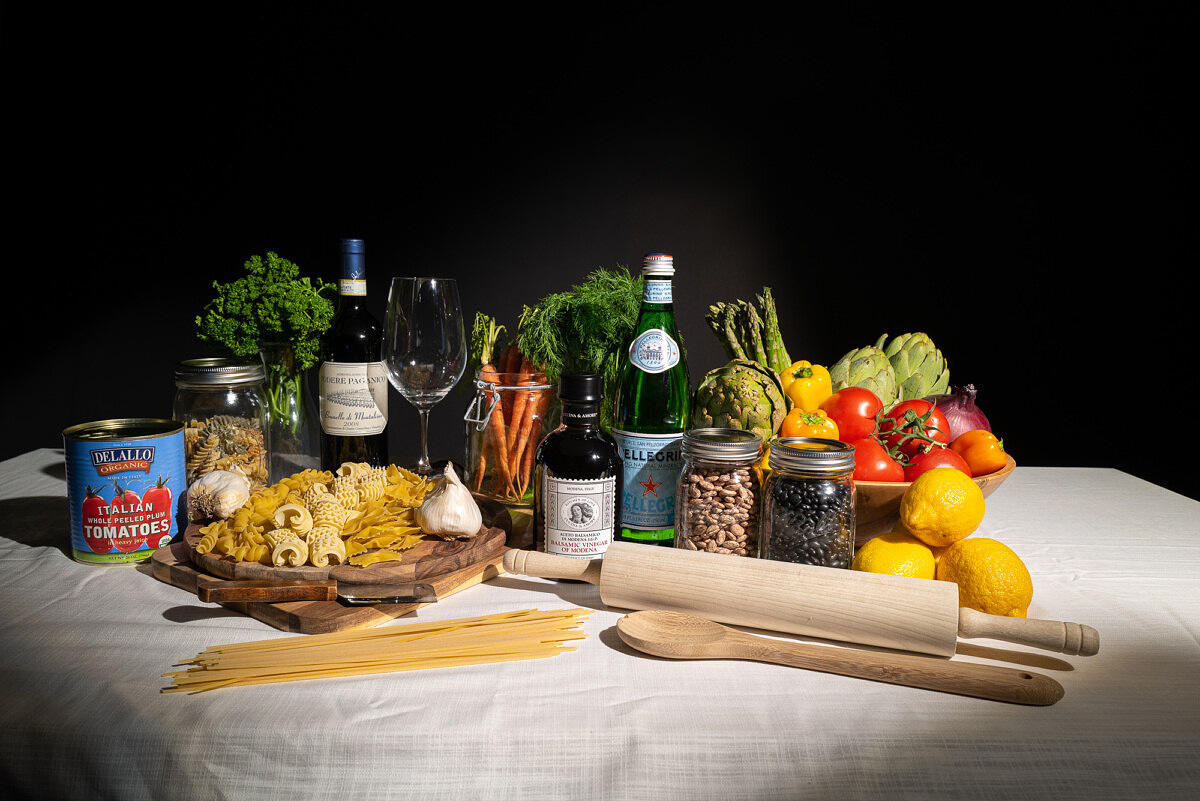
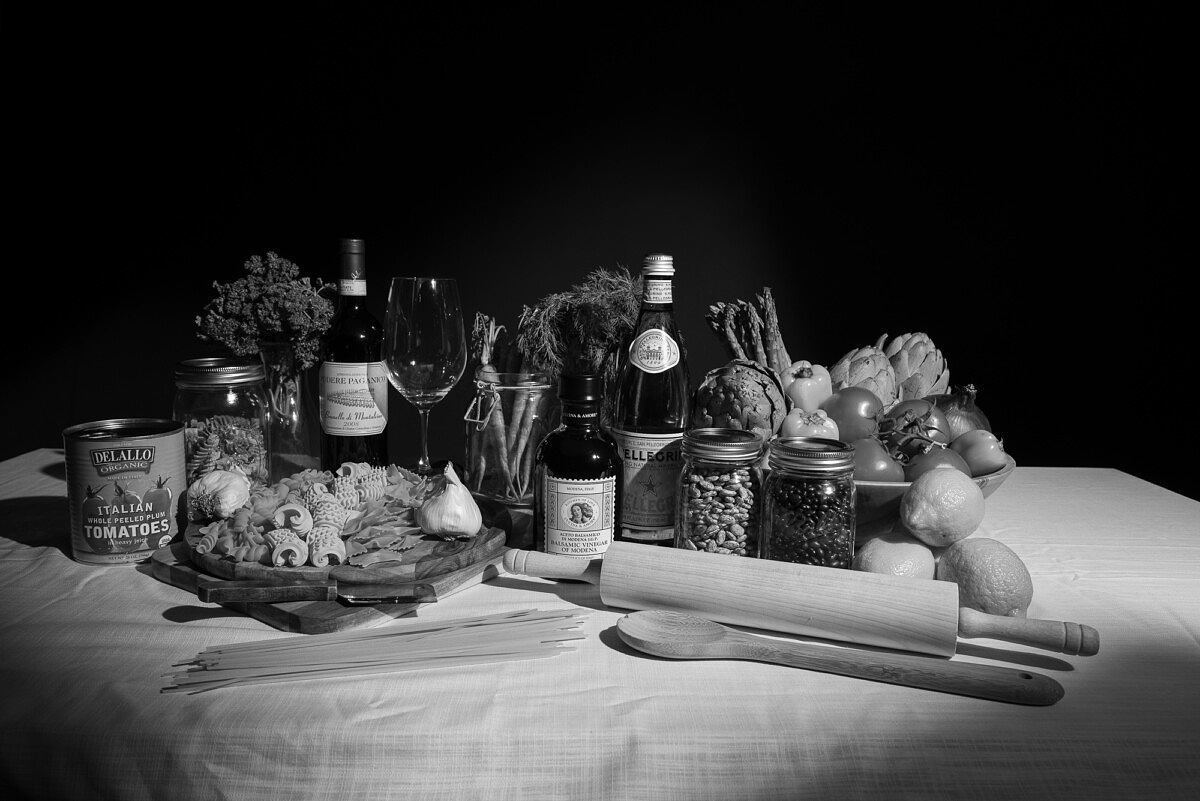

I chose to optimize noise reduction settings as ISO levels increased for each camera. At base ISO, even a small amount of default noise reduction would have diminished detail. And at high ISO, a lack of noise reduction would not have been representative of real-world usage. These are all best-case scenarios under ideal test conditions, so please view them as such.
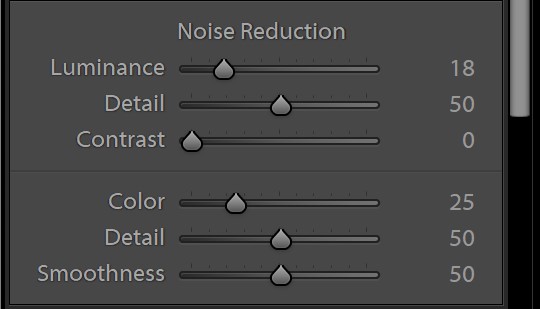
All files were exported from Lightroom using the highest level of JPG quality (100) with the least compression, with no image resizing and no additional output sharpening. Why didn’t I use TIFF? In my experience, there is no visible difference in a highest quality first-generation JPG and a TIFF. These processed images were then brought into Adobe Photoshop as full-size layers, composited for comparison, then output for web with a JPG level of 12. If nothing else, in preparing for the results, I did manage to create the largest Photoshop file I've ever worked with, at over 35GB in size. Yes, for single file. Thank goodness for Adobe's Large Document Format.
How to Properly View the Comparisons
One final note before we get into the comparisons: these images are output to 2000px on the long side, with 1:1 pixel rendering. Be sure to click on each crop set to view the larger image. When viewed with no onscreen scaling, one pixel on your monitor will display one pixel from the camera. This is complicated somewhat by Retina-type displays that do pixel resampling. Applications like the latest versions of Photoshop and Lightroom have the option of running in non-scaled, 1:1 mode, but the pictures will appear smaller on screen.
If your monitor resolution is less than 2000px across, like on an iPad or a laptop, be sure to right-click on the image and select Open link in new tab (be sure to select link not image). This will open just the image, allowing you to view it at the correct size once you click to magnify. Or, even better, right-click to Save link as… and view in Photoshop. Unfortunately, with technological innovation comes its own set of challenges. Retina and 4K/5K displays look stunning, especially for text, but are sometimes less than ideal for image comparisons as they employ pixel doubling and no longer show 1:1.
Full Size Images Download
Now, just in case all the following comparisons don't fully satisfy your curiosity and you want to do your own evaluations, I'm leaving a link to download the full resolution exports for each camera at every ISO. The images were output directly from Lightroom as non-resized JPGs, with no output sharpening and saved at a quality level of 100. For all intents and purposes, they are on par quality-wise with TIFF files. Each camera's image set is saved as a zipped folder for your downloading convenience.
B+W ISO Showdown 2021 – Full Size Files
Q2 Monochrom vs Q2
Ok. Enough tech jargon. Let's kick this party off with a head-to-head of the Q2 Monochrom versus the Q2. Apart from their cosmetic differences, the cameras are identical in every way other than one is full color and the other is monochromatic. The CFA has been removed on the Q2M and internal processing has been optimized for B&W imaging. But the underlying sensor architecture is the same.
ISO 100
Jumping in at base ISO (ISO 50 on the Q2 is most likely a PULL setting so we didn't use it), both cameras offer an extraordinary level of detail and nuance. Just stunning results from the 47 megapixel sensor and the phenomenal 28mm Summilux lens. This level of quality is maintained easily on both cameras through ISO 800 as you can see in the following comparisons.
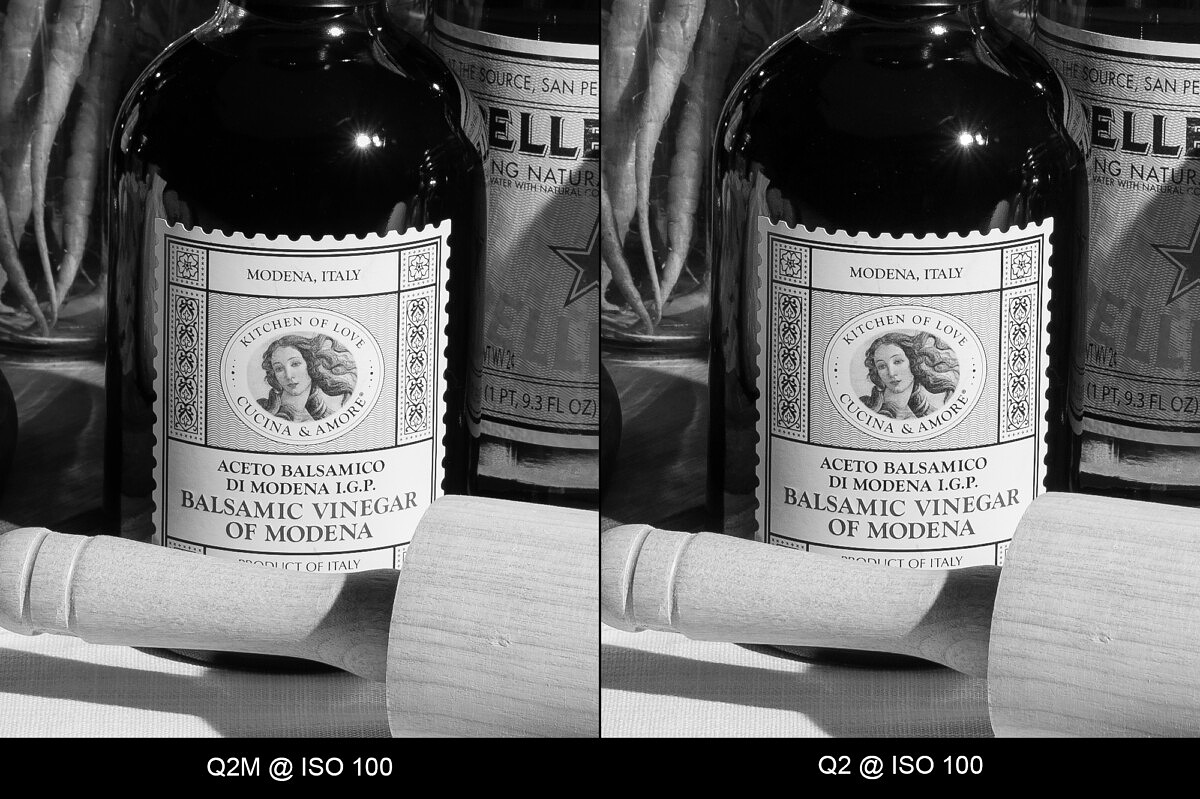
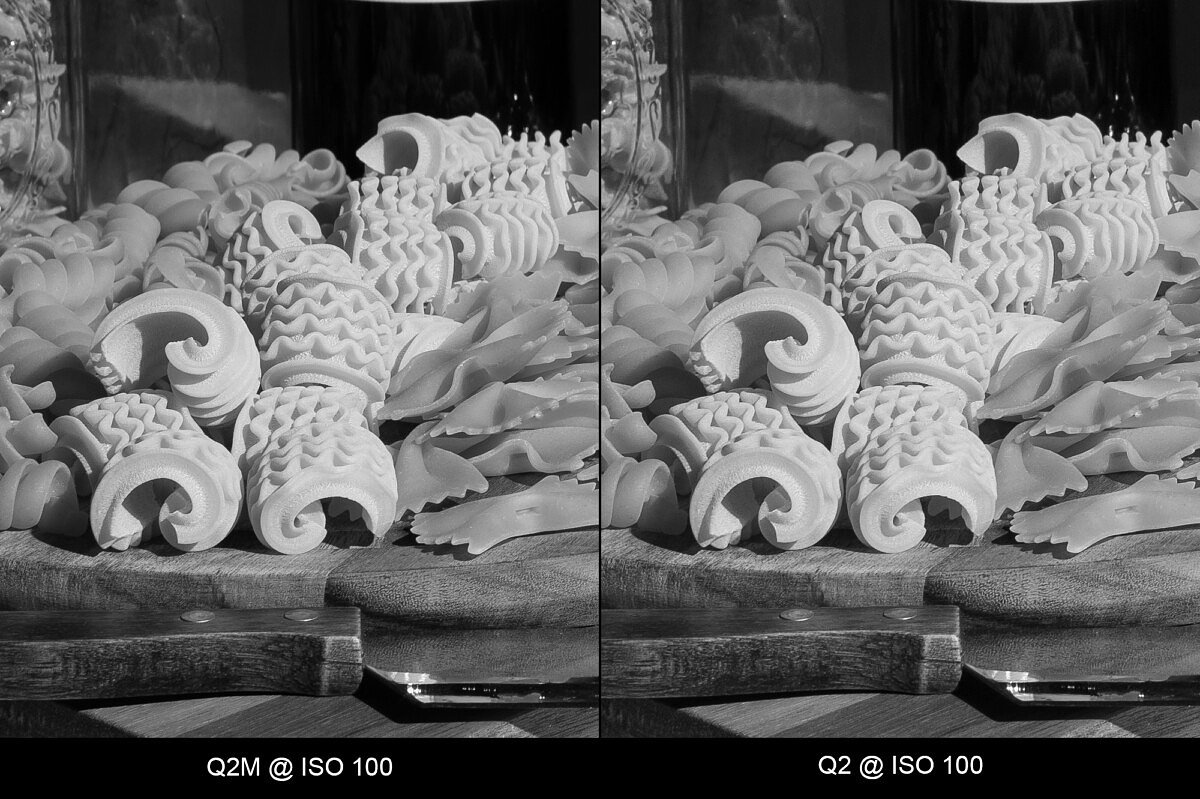
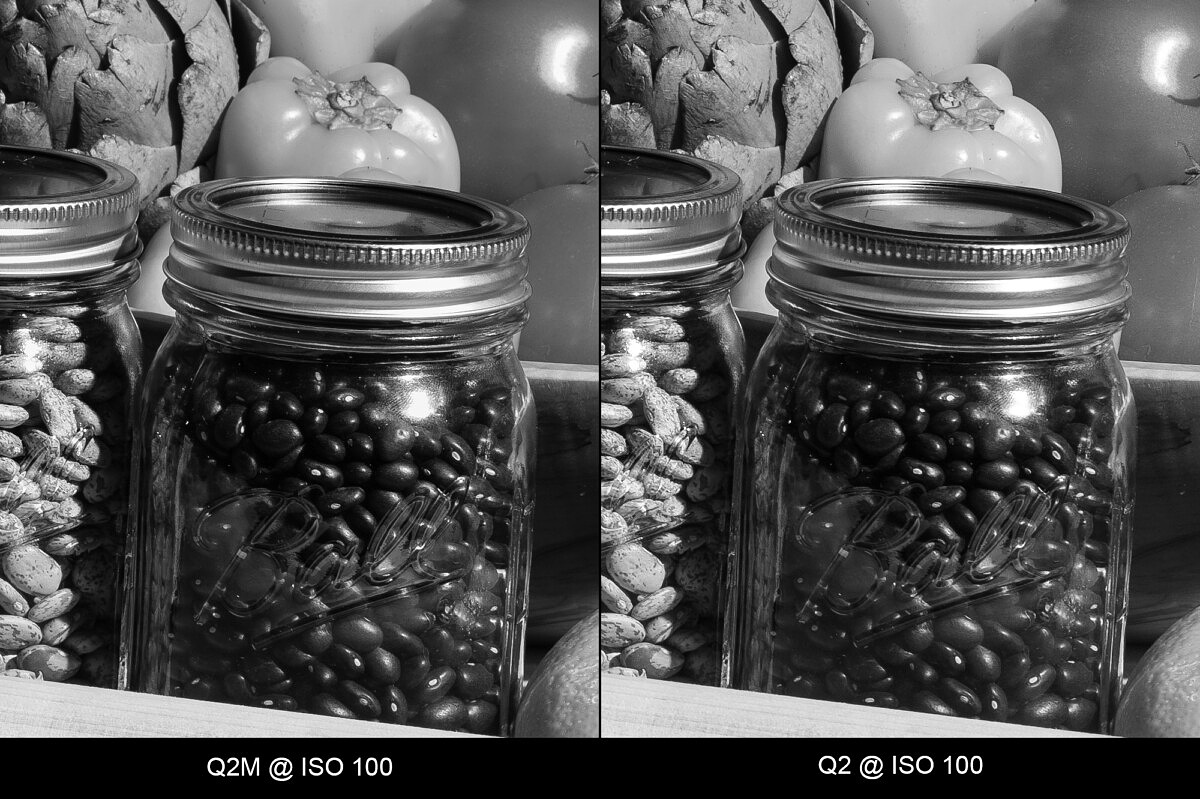
ISO 200
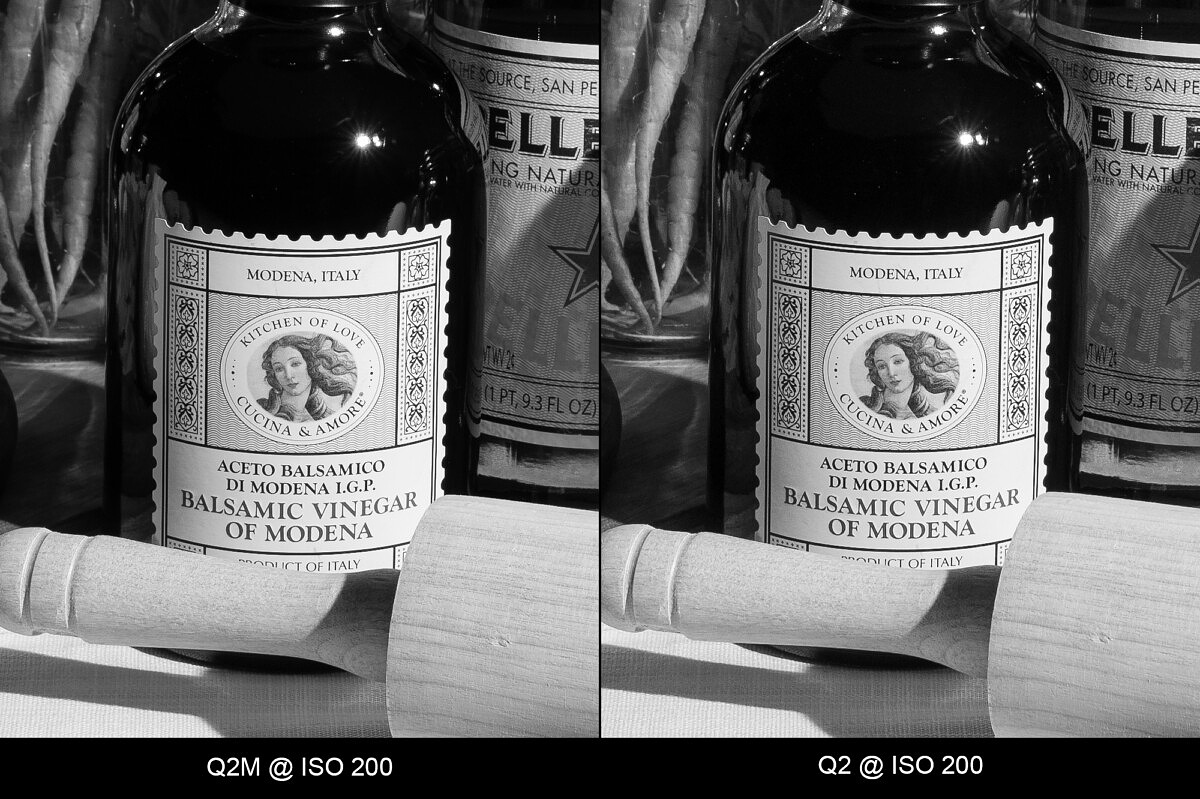
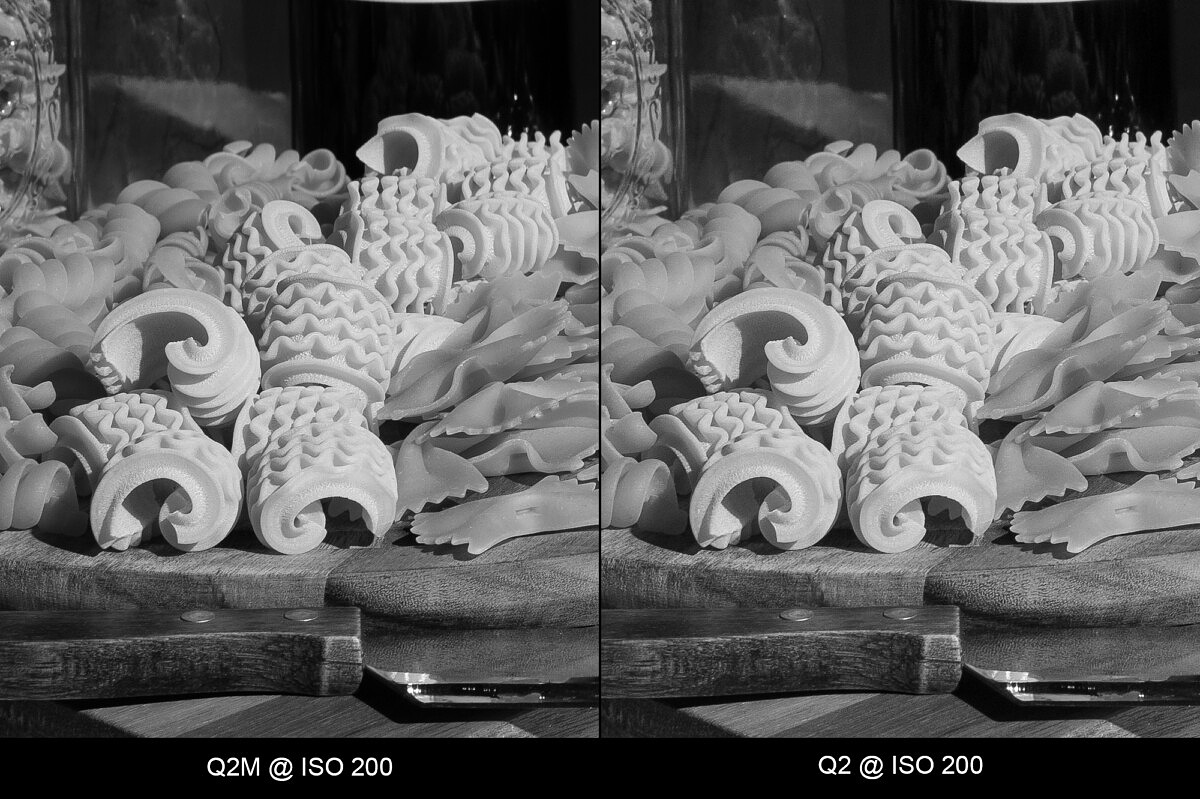
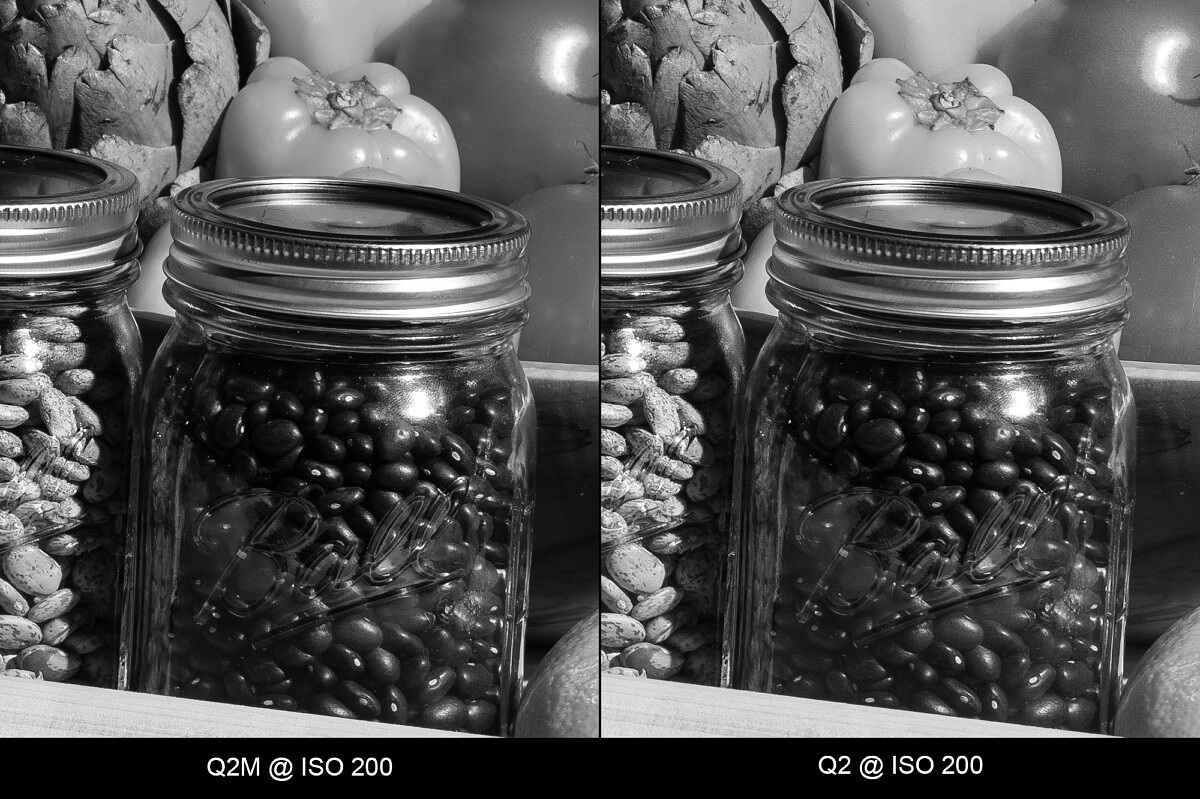
ISO 400
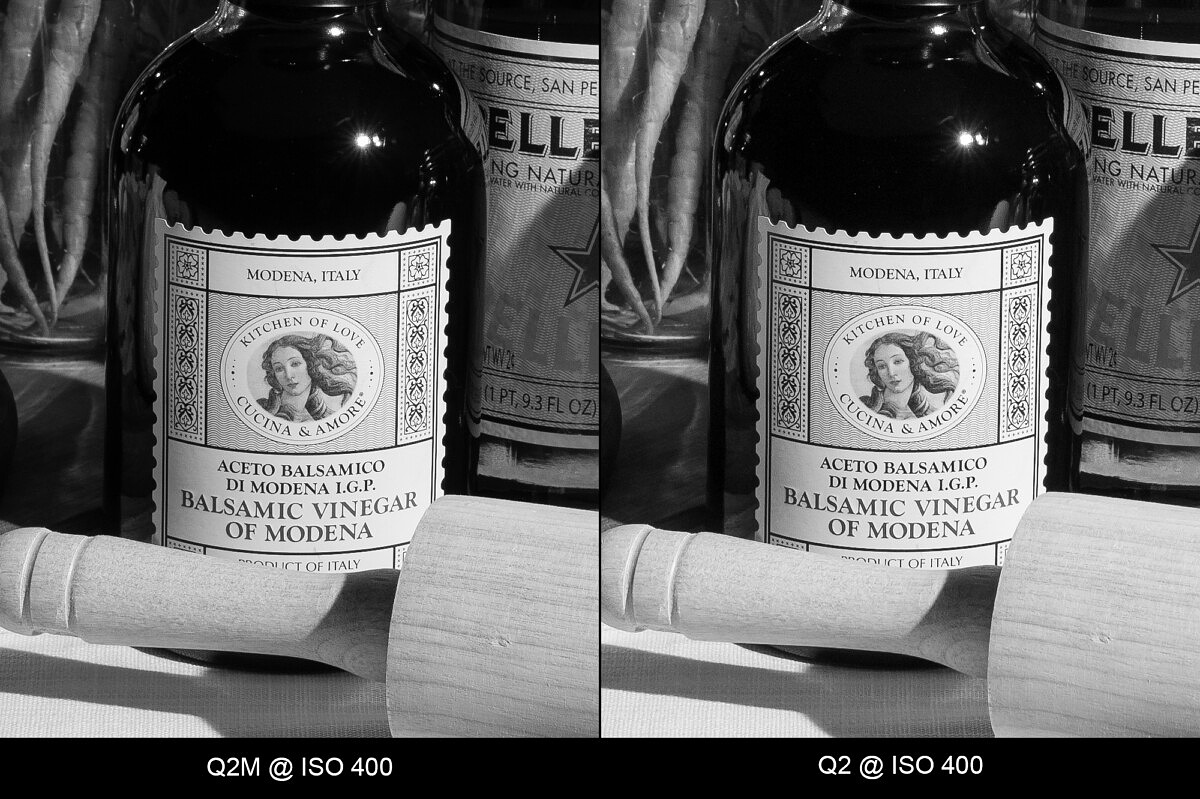
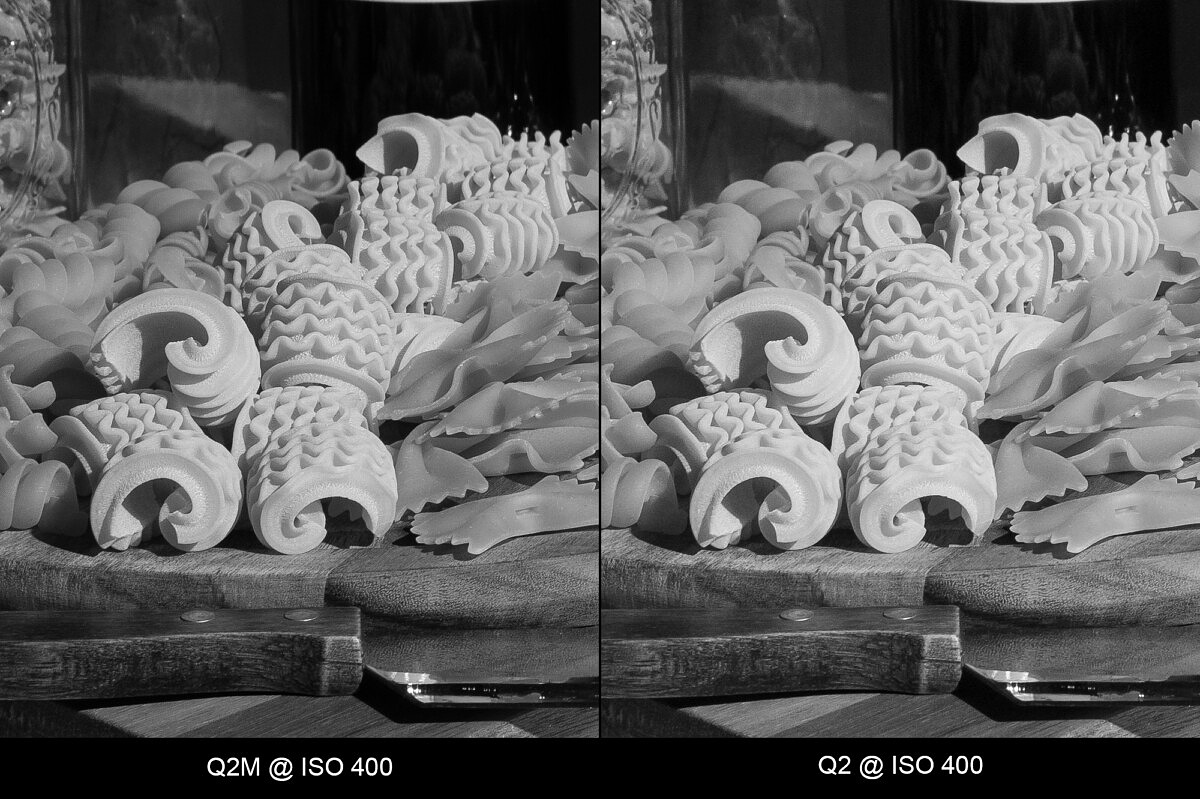
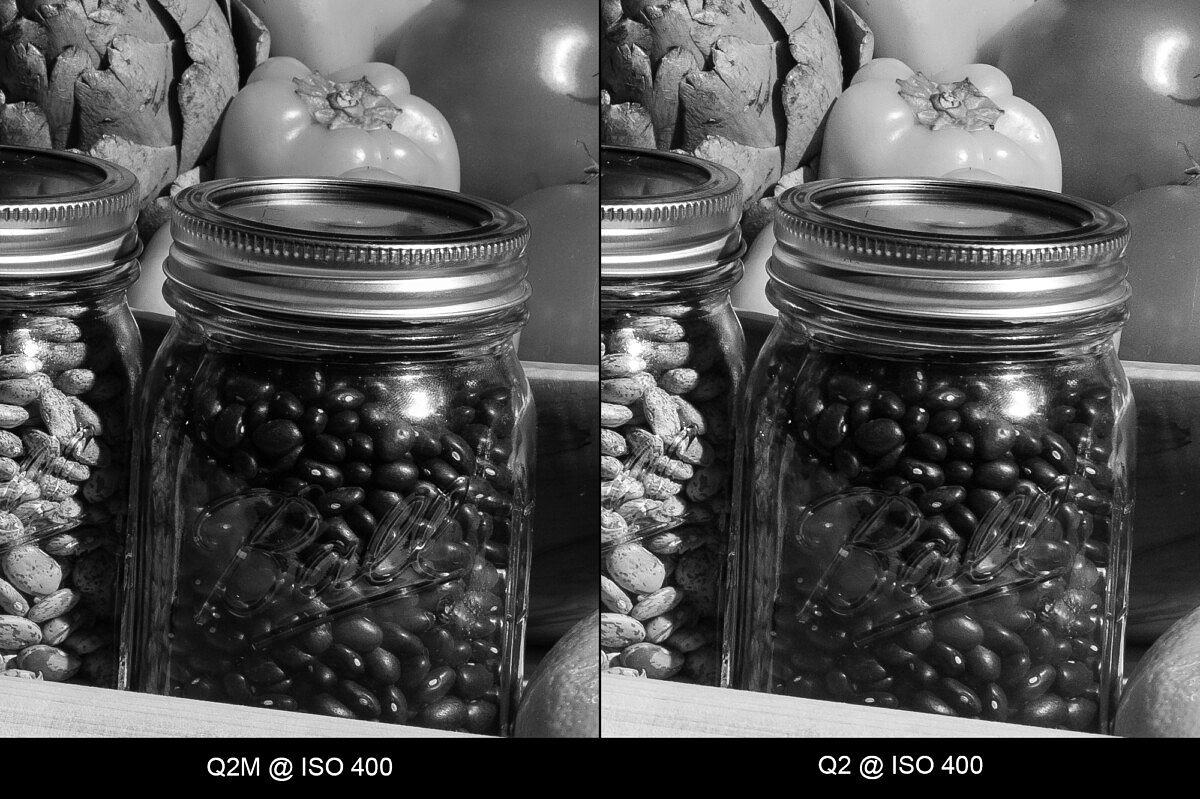
ISO 800
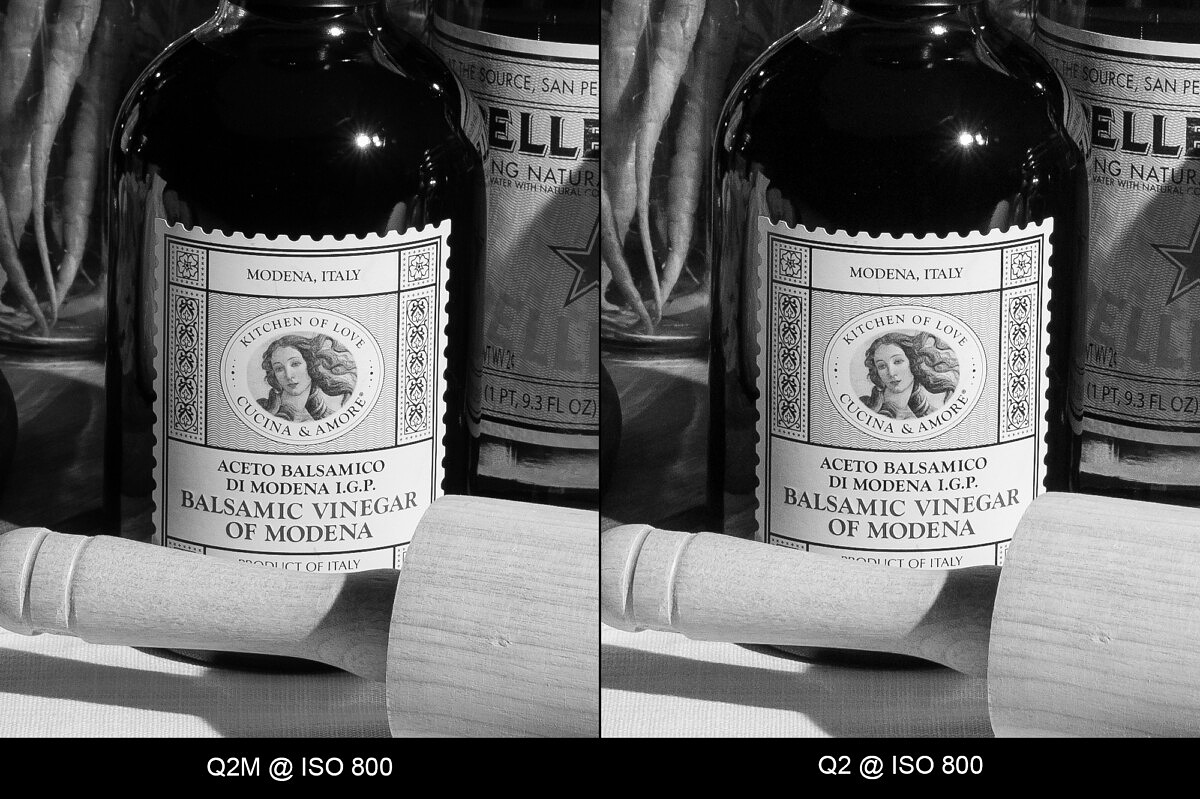
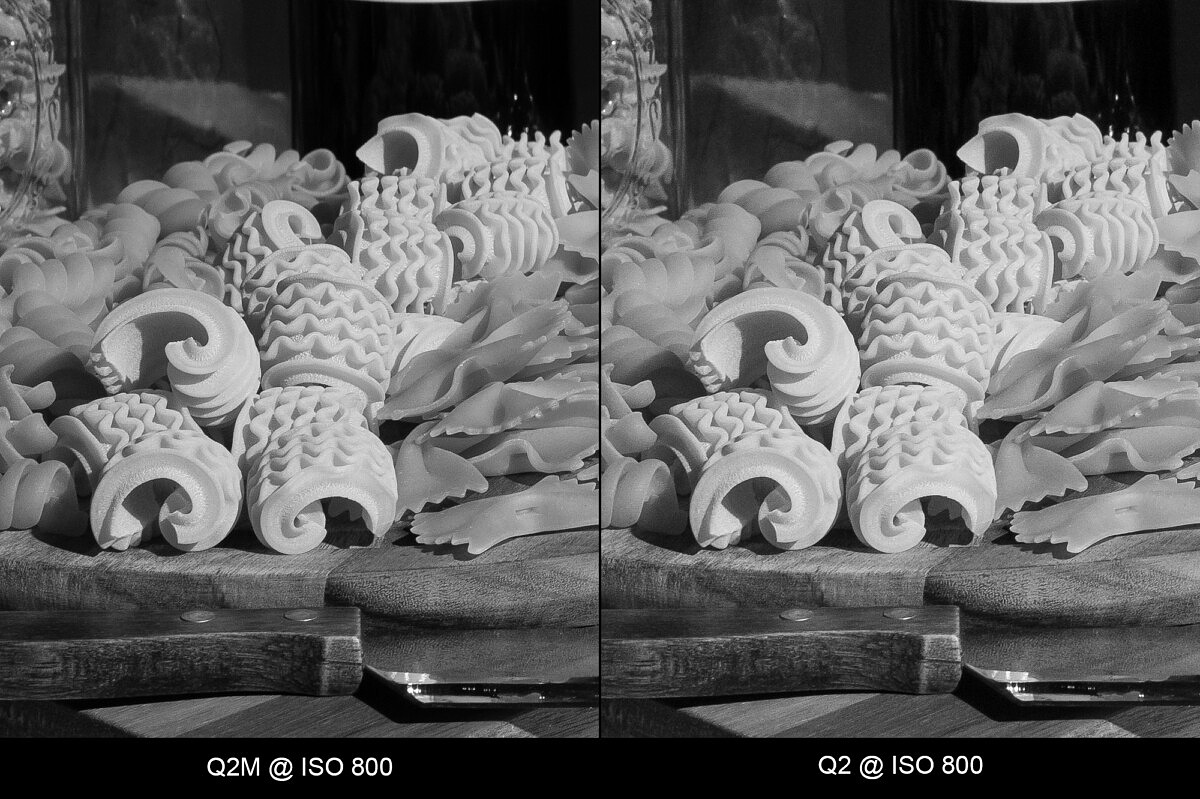
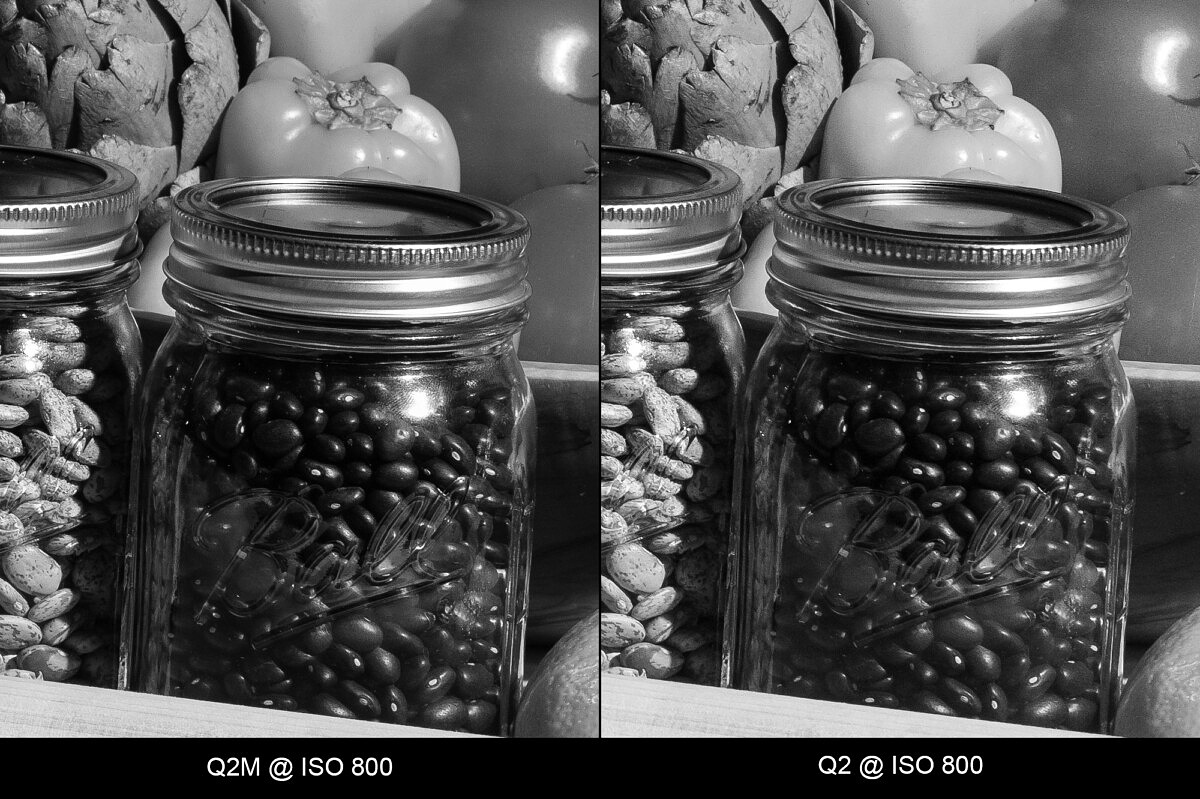
ISO 1600
Quality is still exceptional, with just the faintest amount of noise starting to creep in on the Q2 images. If this is barely detectable at 1:1 pixel size, it most certainly wouldn't be discernable in any normal viewing situation. Q2M images are still completely noise-free.
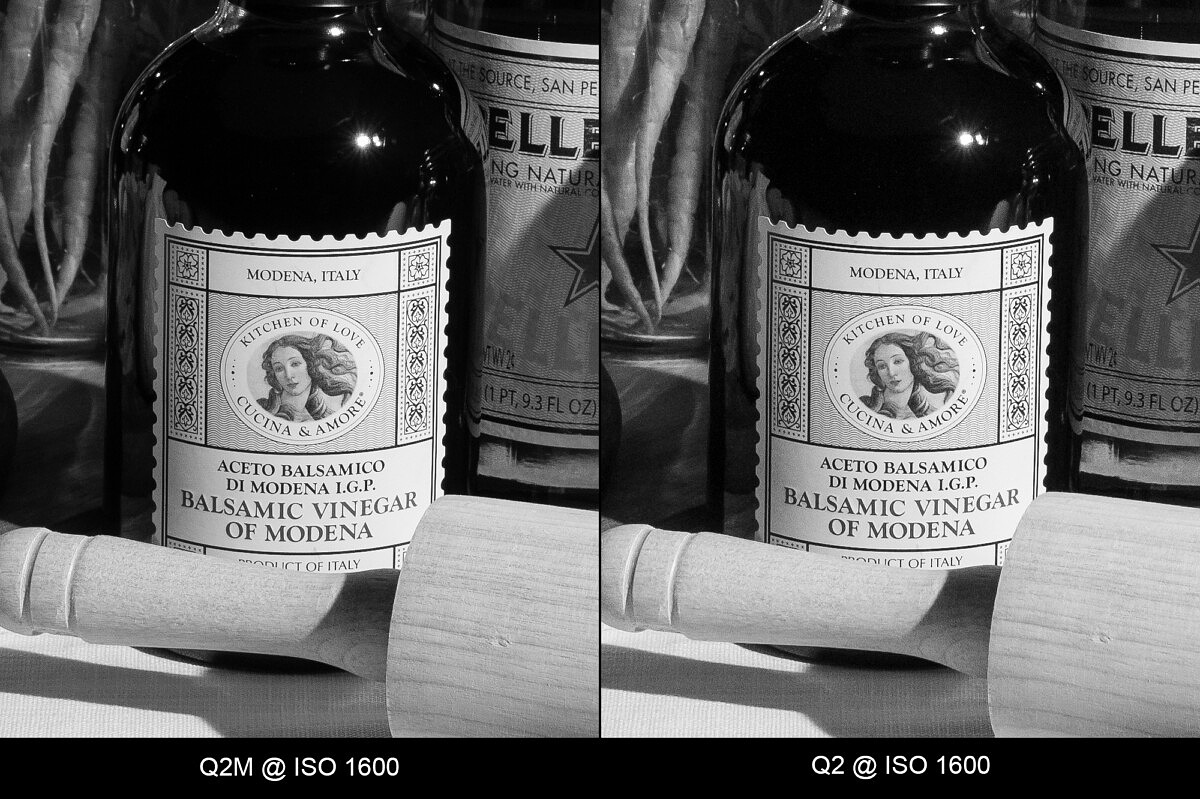
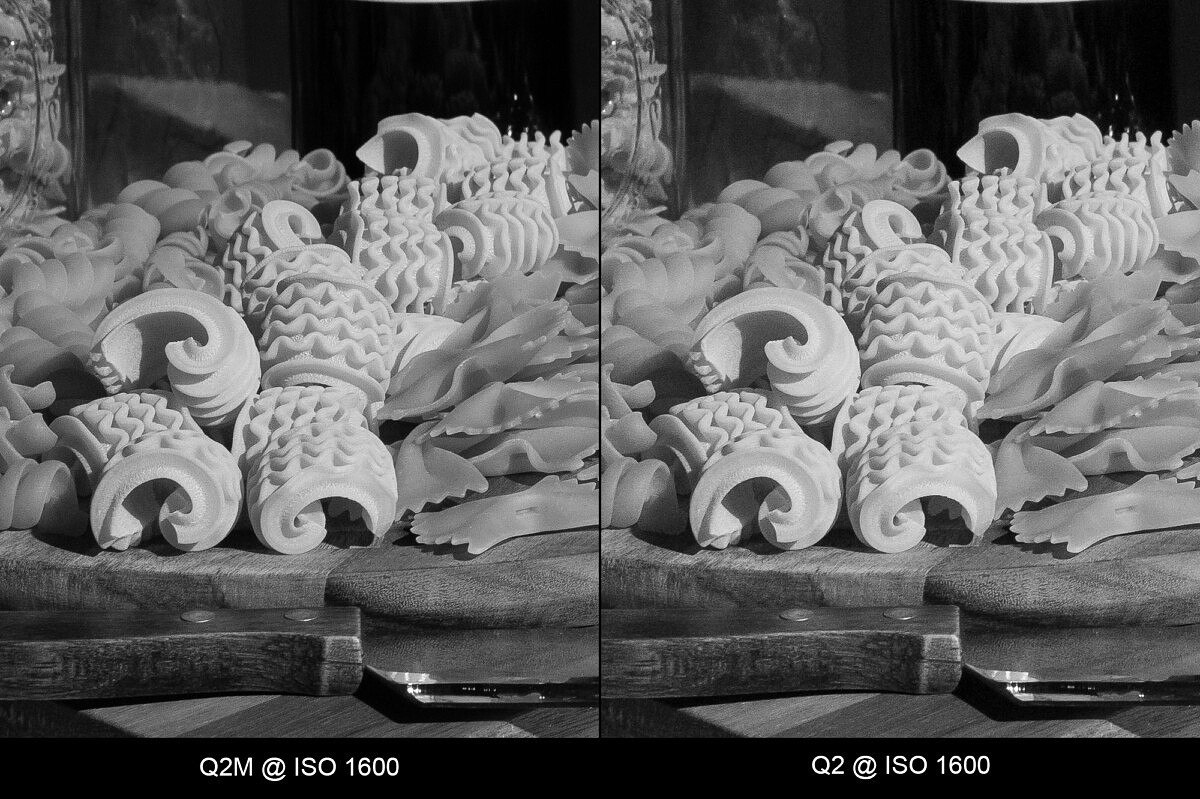
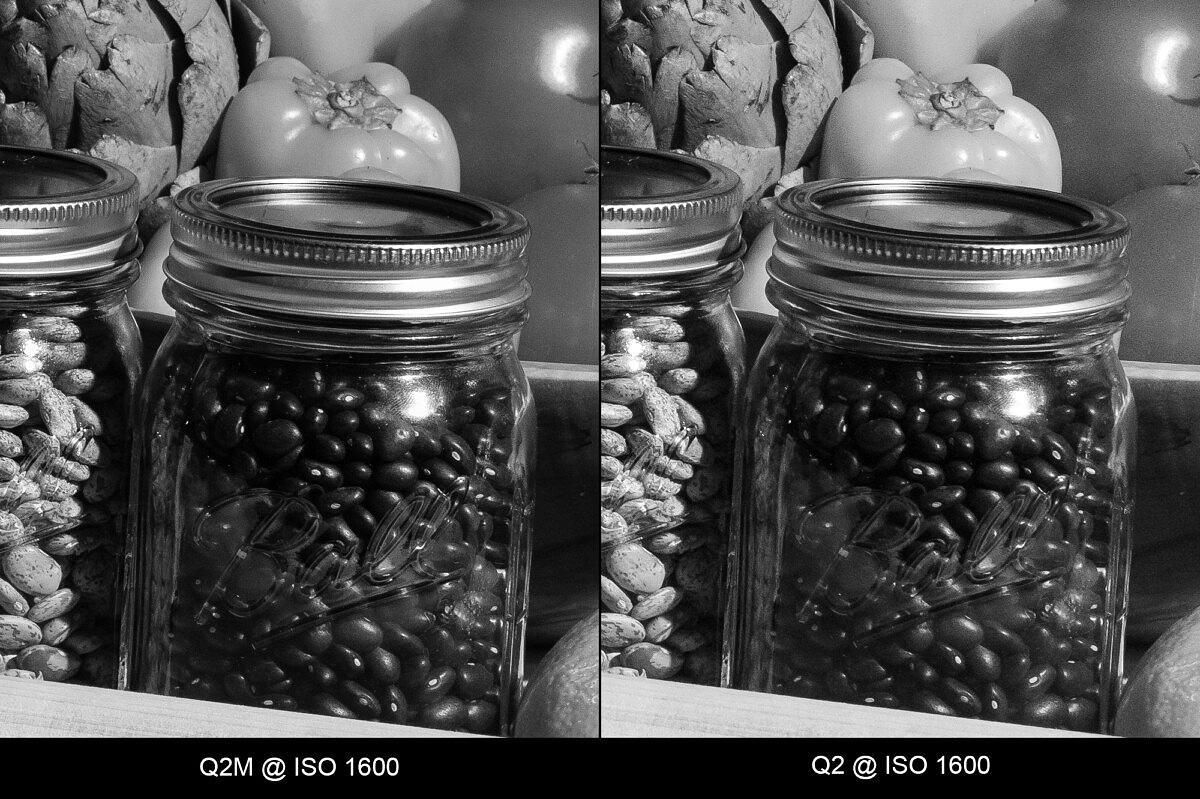
ISO 3200
At ISO 3200, the Q2 noise is becoming a bit more evident, especially in darker mid-tone areas. The Q2M, by contrast, still looks practically as good as it did at base ISO, and is definitely showing off against its color sibling.
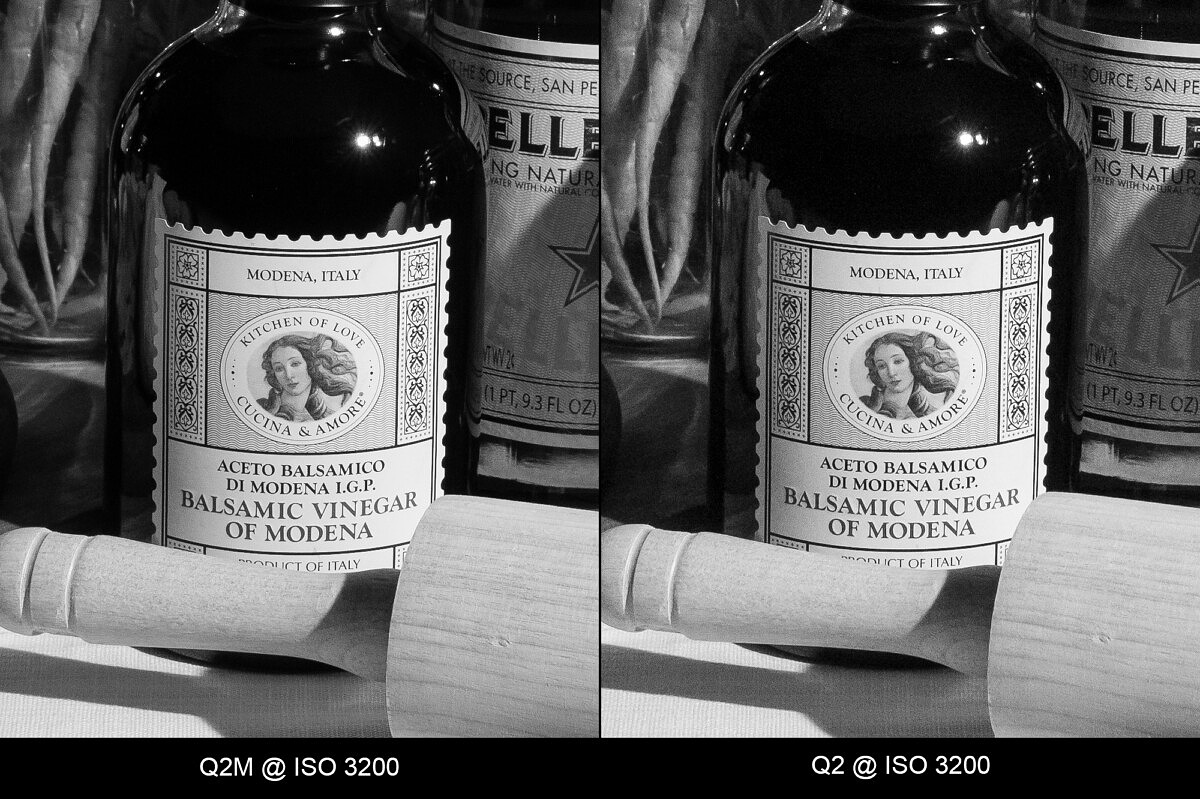
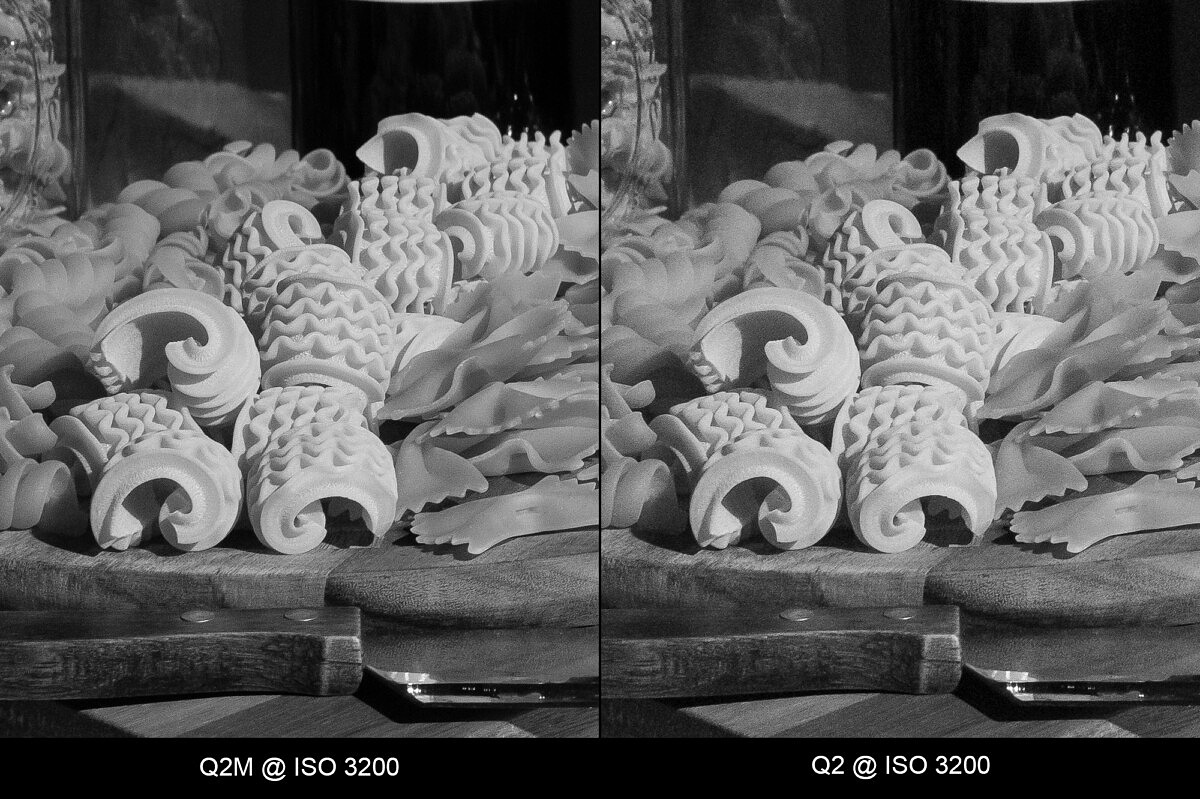
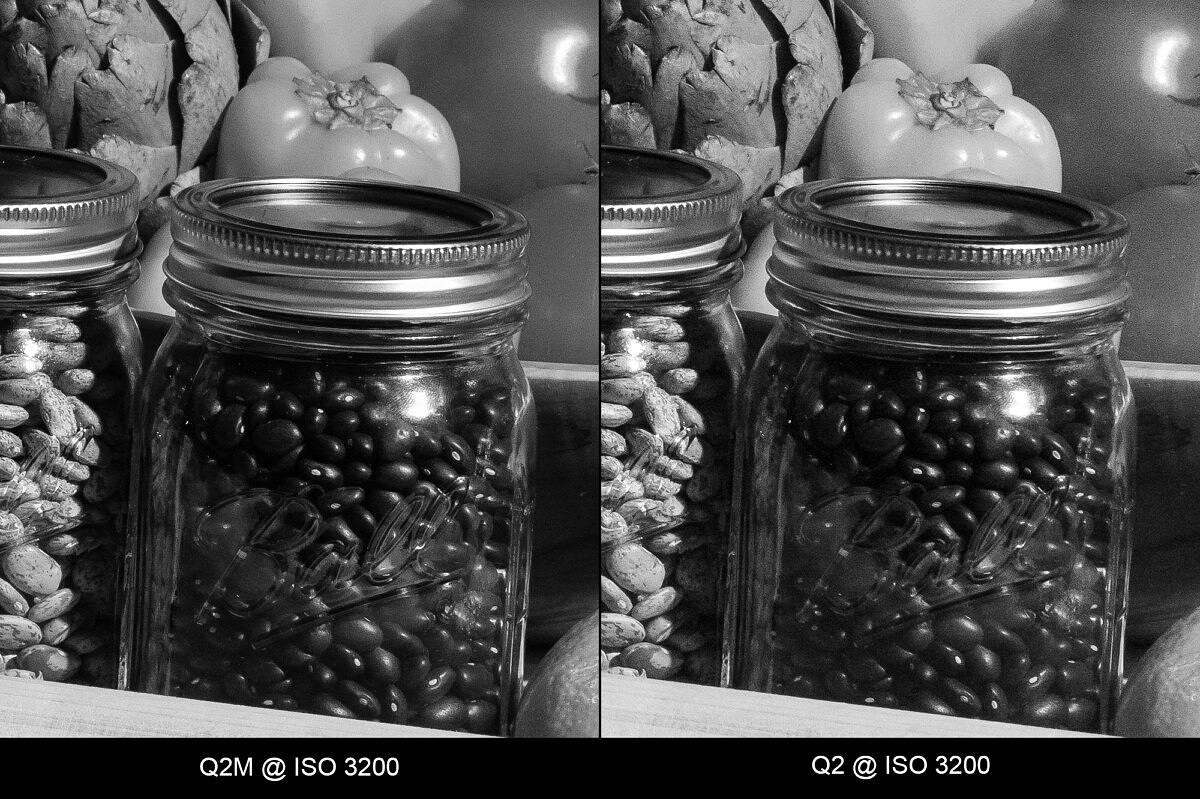
ISO 6400
At ISO 6400 noise is starting to impact fine detail and texture resolution of the Q2, but the camera is still capturing a very pleasing image overall. Noise is visible across the full tonal range now. The Q2M is just starting to exhibit the tiniest amount of tight-grained noise.
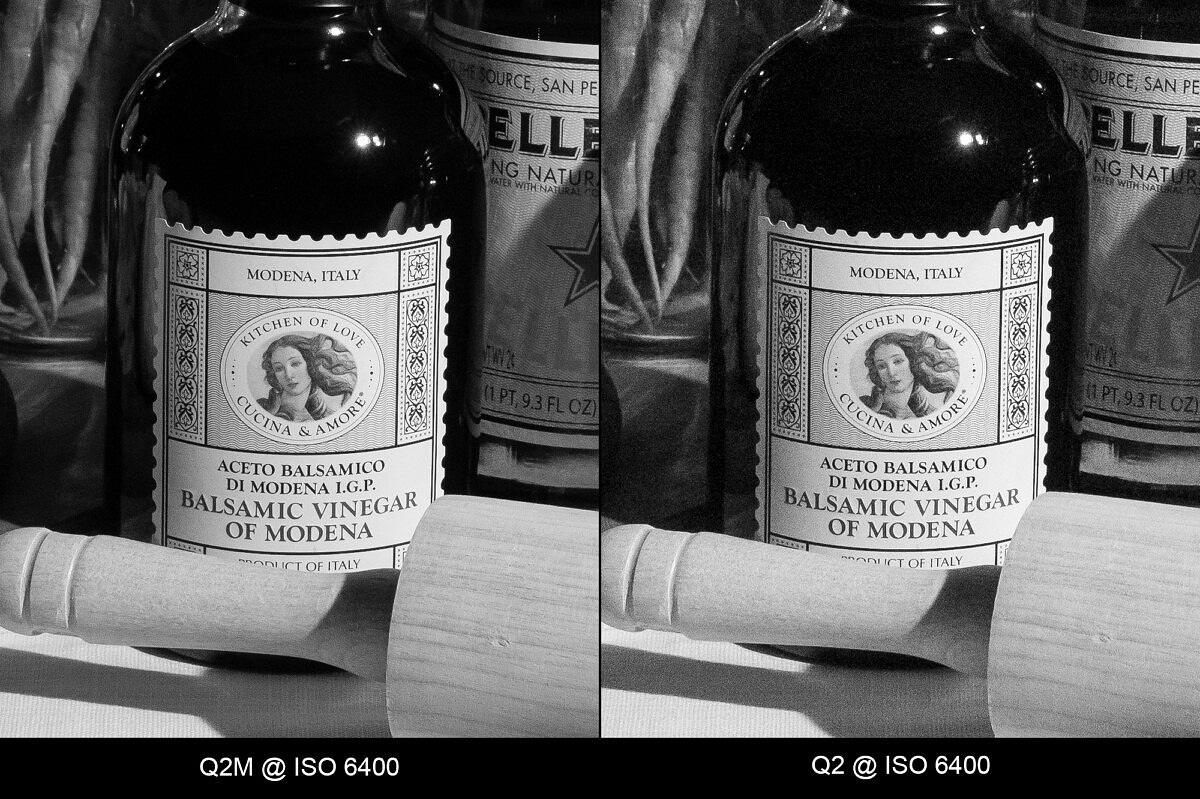
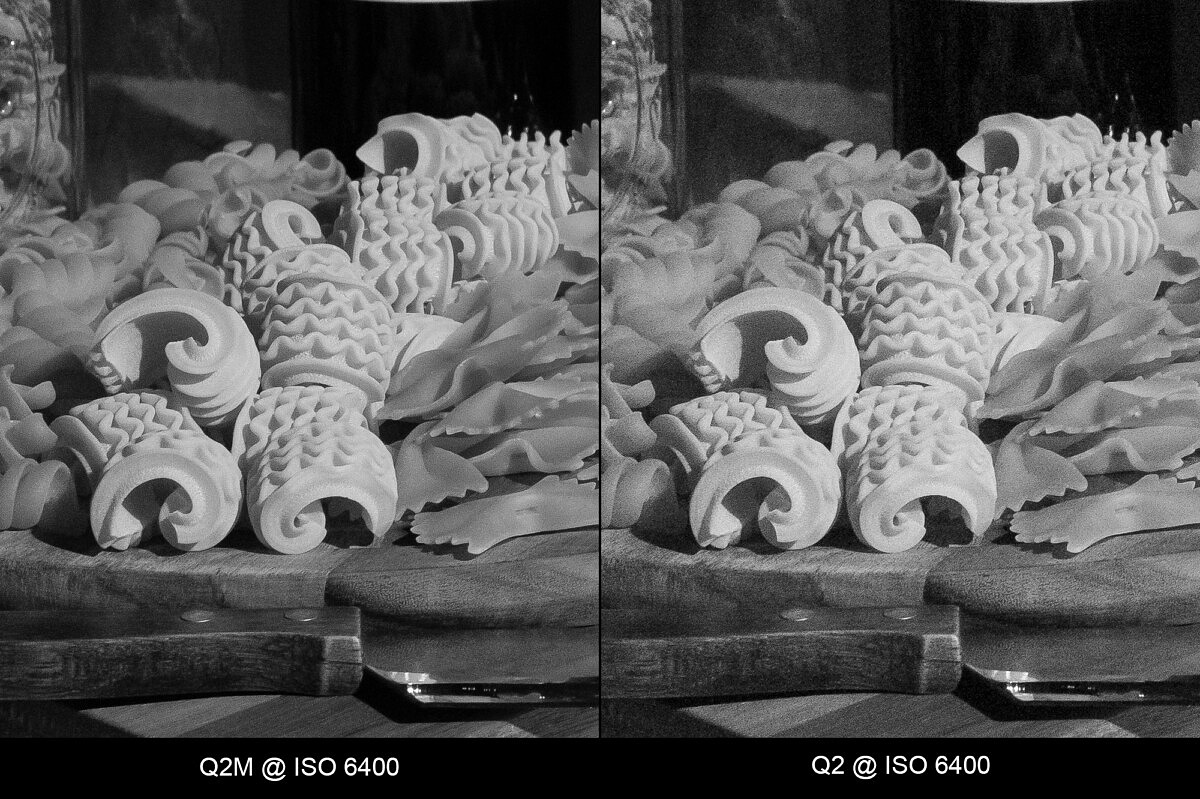
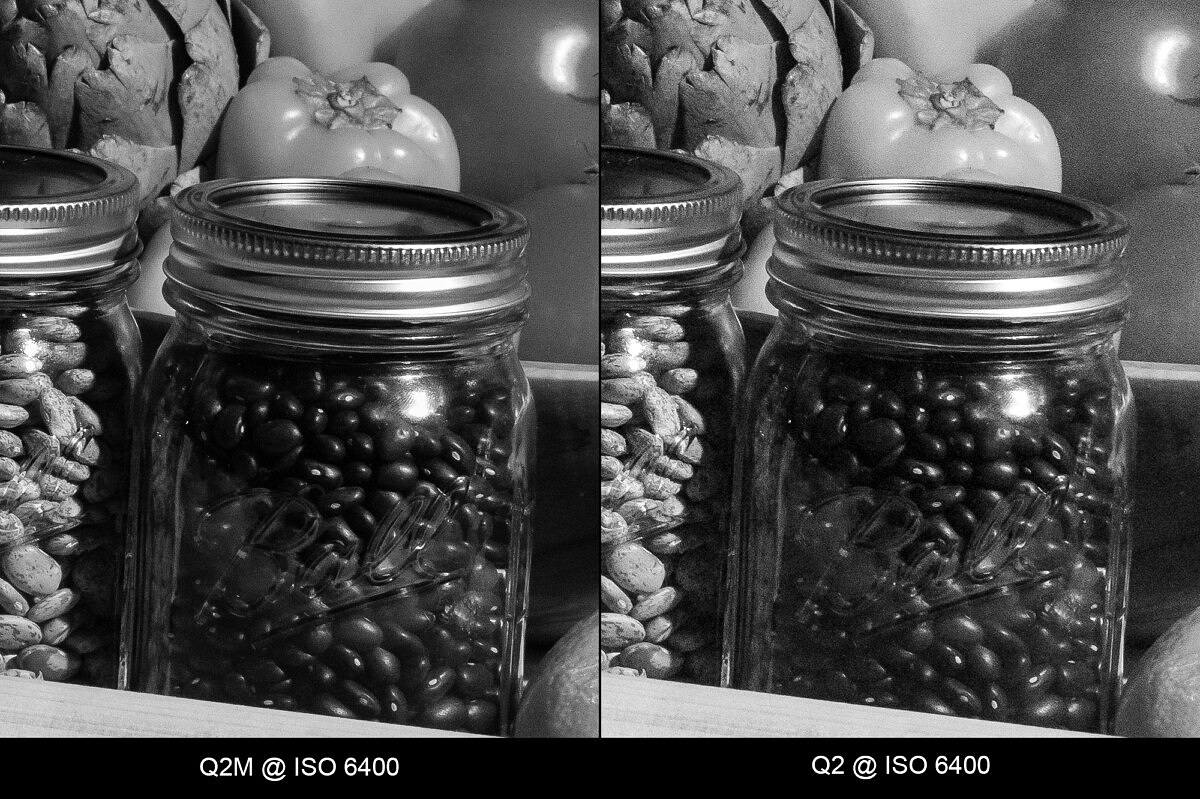
ISO 12500
At ISO 12500, visible noise is seriously affecting image quality on the Q2. There is an overall loss of image contrast. Details are getting obscured by noise. The Q2M continues to impress, turning out an impressively clean showing, with only minimal noise. And the noise that is preset isn't hampering fine details.
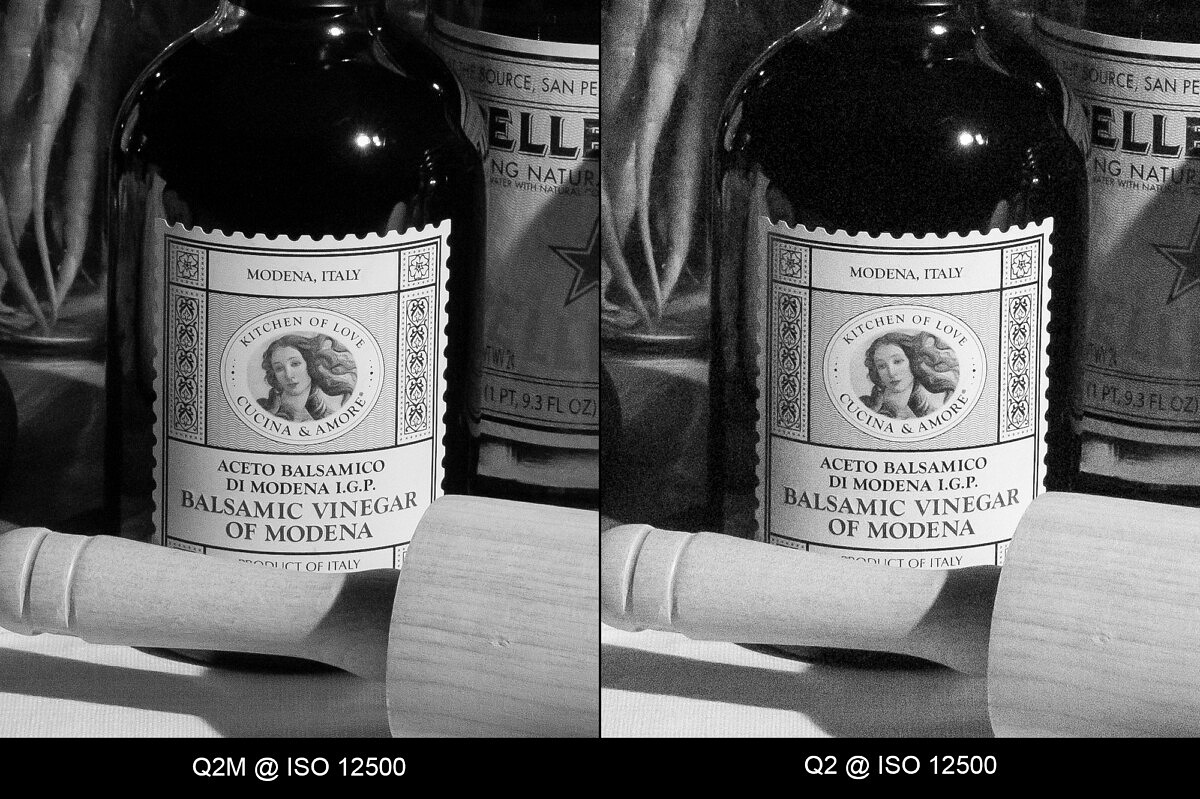
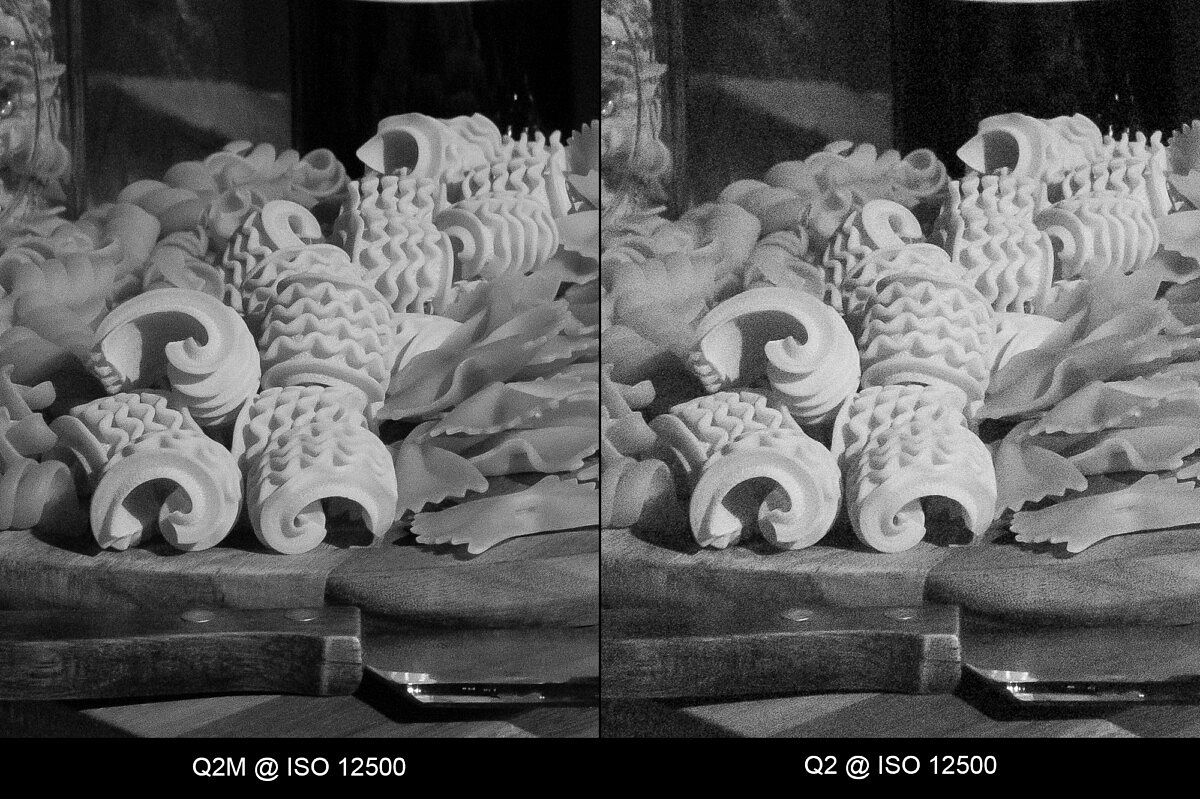
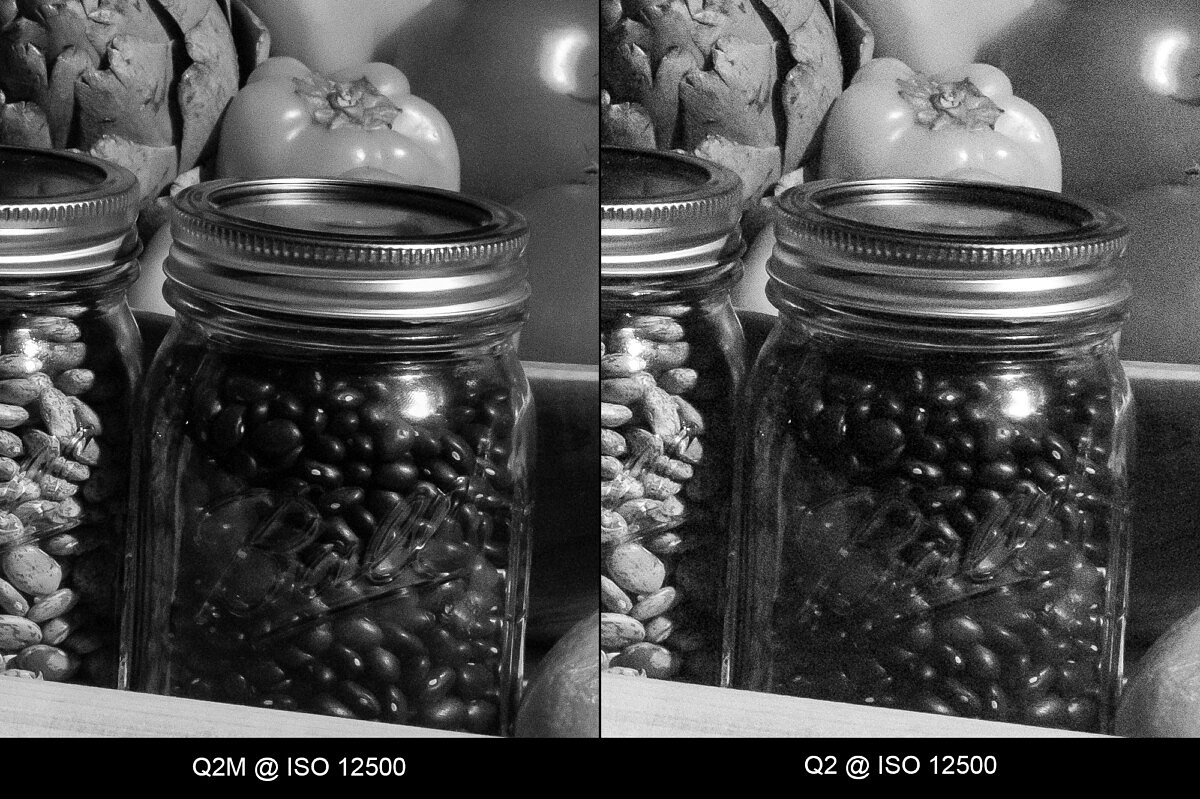
ISO 25000
While the Q2M produces a very usable image at ISO 25000, still keeping noise well under control, the Q2 is not holding up well here. More contrast and detail loss with a growing haze of noise over the image is obvious.
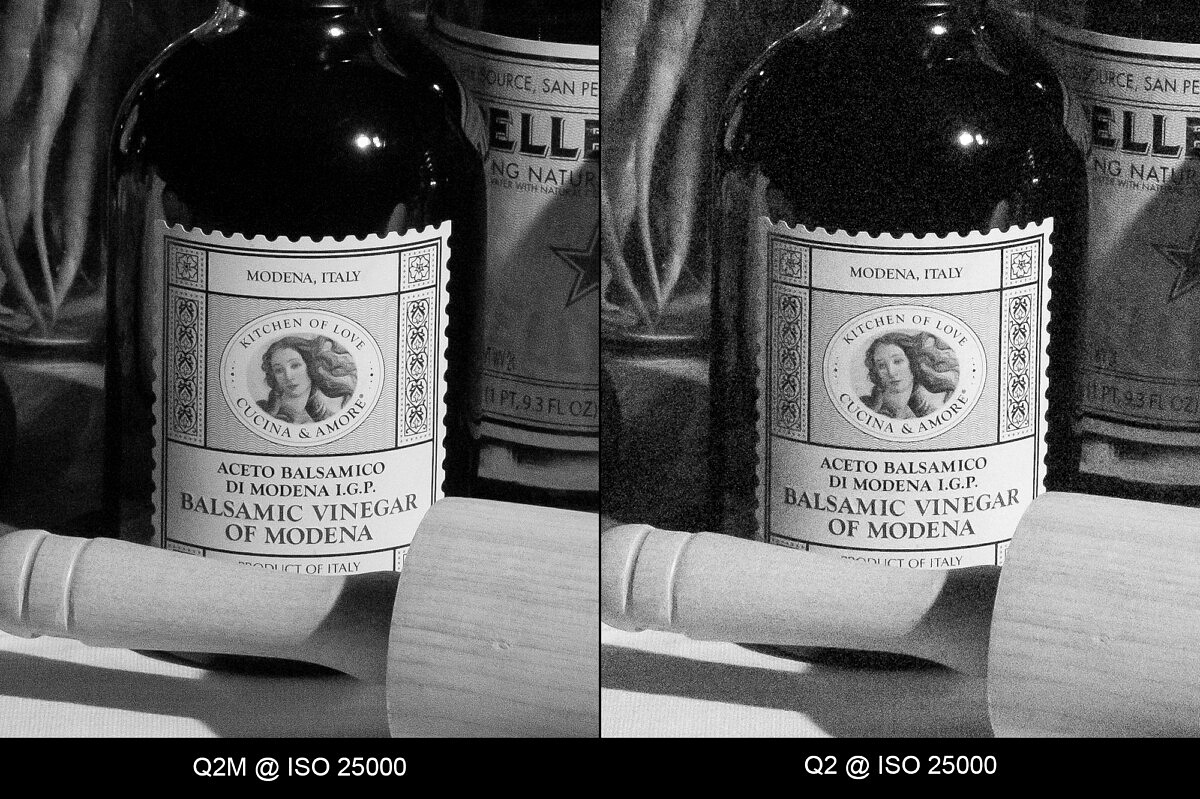
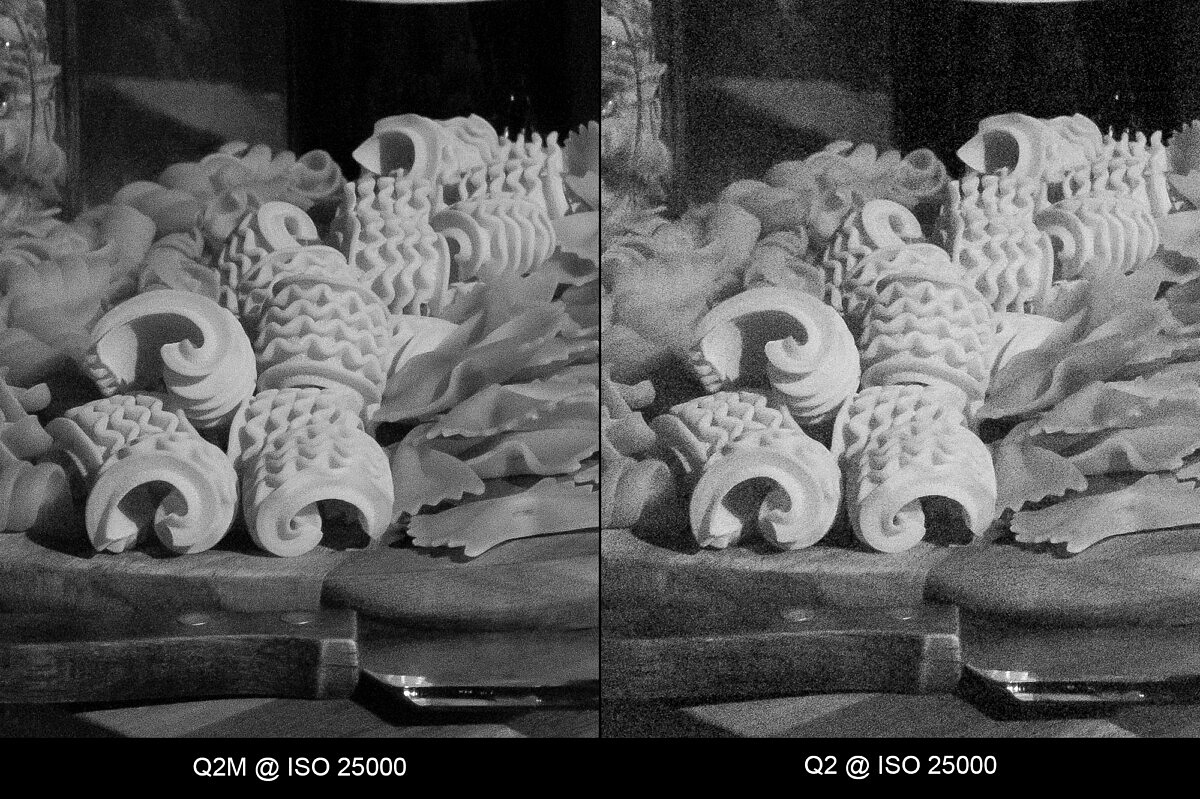
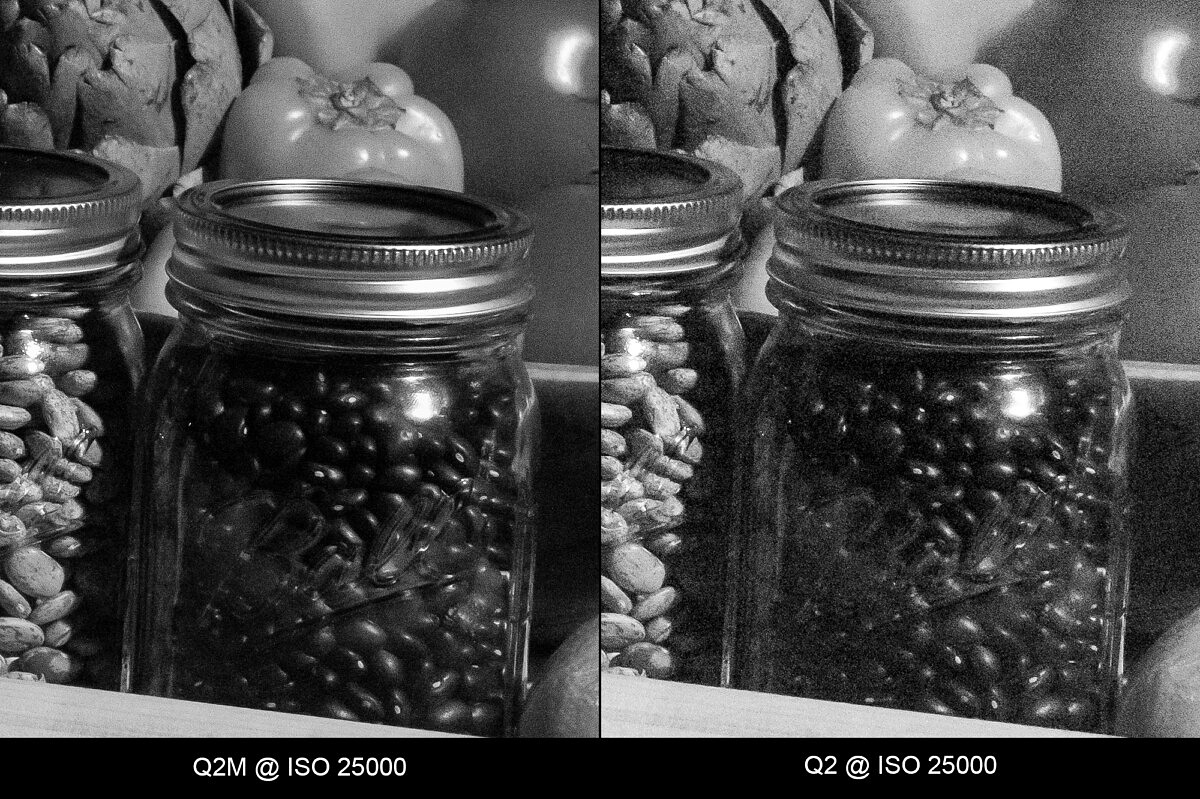
ISO 50000
Now at the maximum ISO value of the Q2, things are just getting worse for the color camera. This is an almost unusable result that even the most aggressive noise reduction can't fix. White speckles blanket the frame. Now, the Q2M is showing a little weakness here at ISO 50000 as well. While much, much better than its color counterpart, we're starting to see some sacrificing of the details due to increasing noise. Still impressive though.
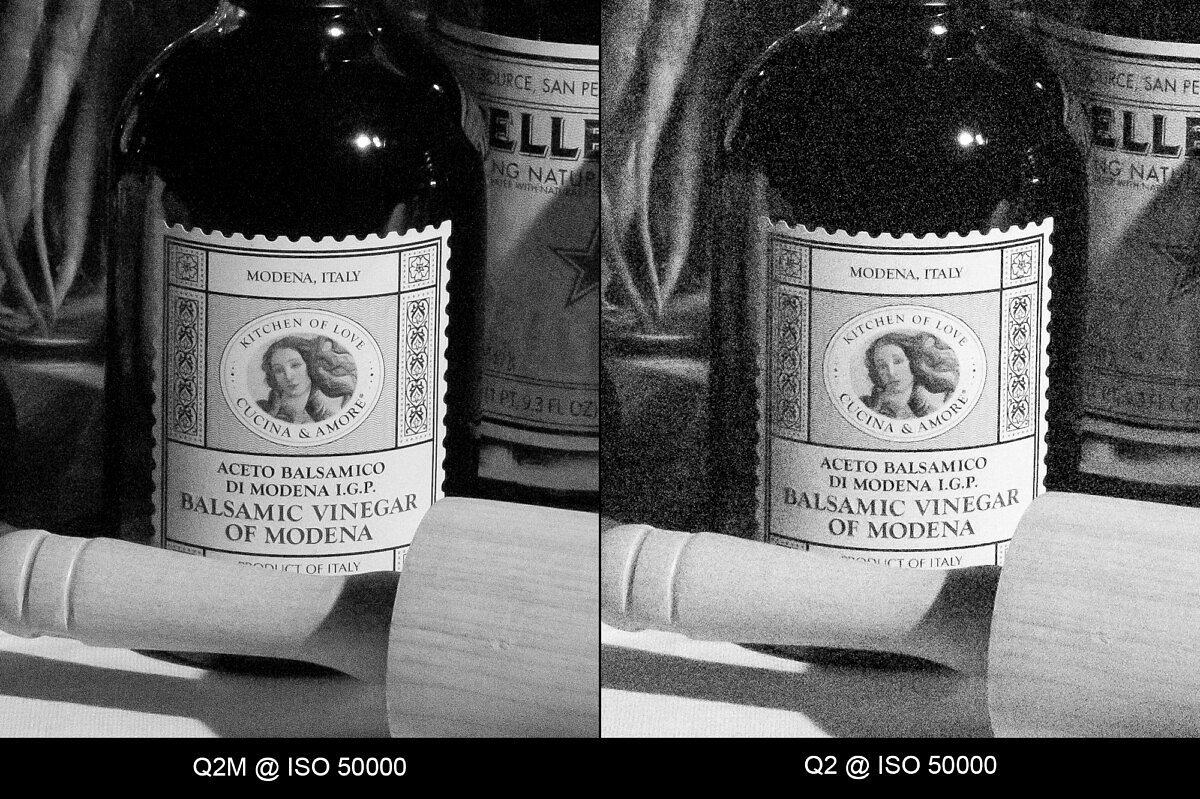
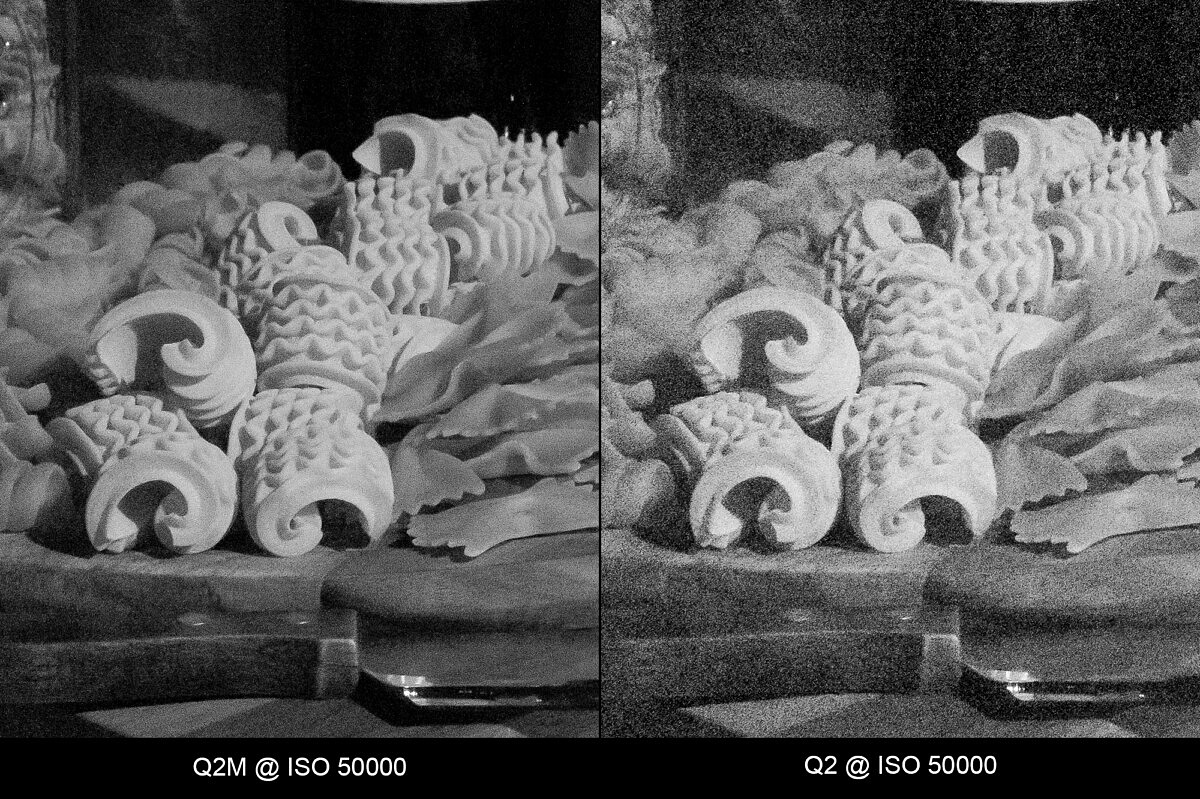
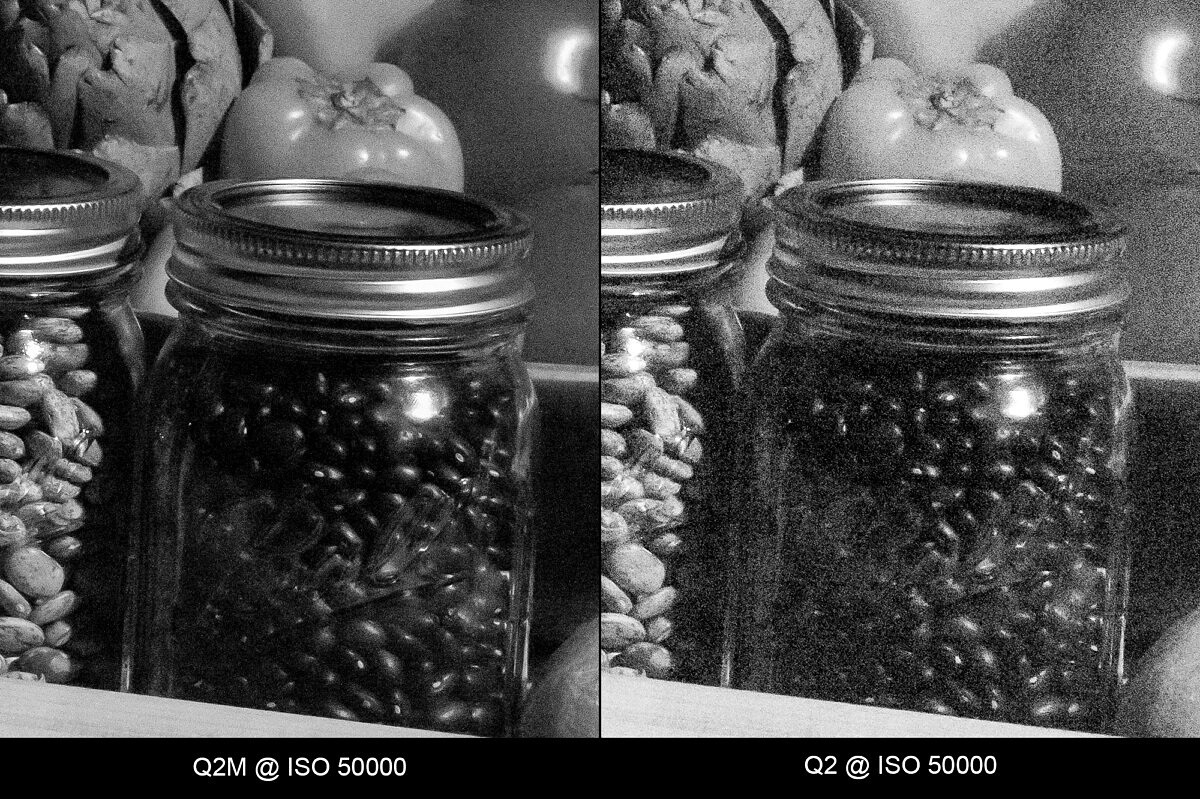
ISO 100000
As noted above, the Q2 maxes out at ISO 50000, but since the Q2M goes all the way to 100000, I figured I'd match up both cameras' highest ISO results. Even a full stop faster, the Q2M result easily tops the one from the Q2 at ISO 50000. But neither is great.
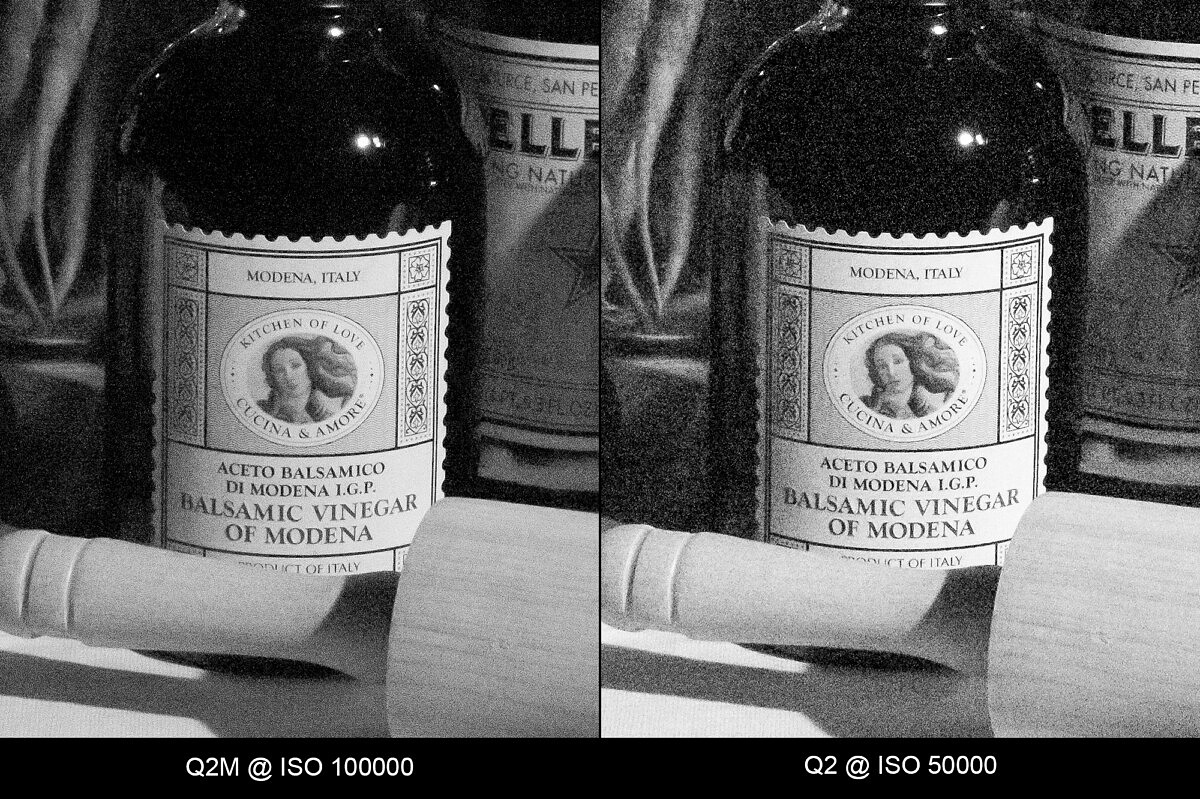
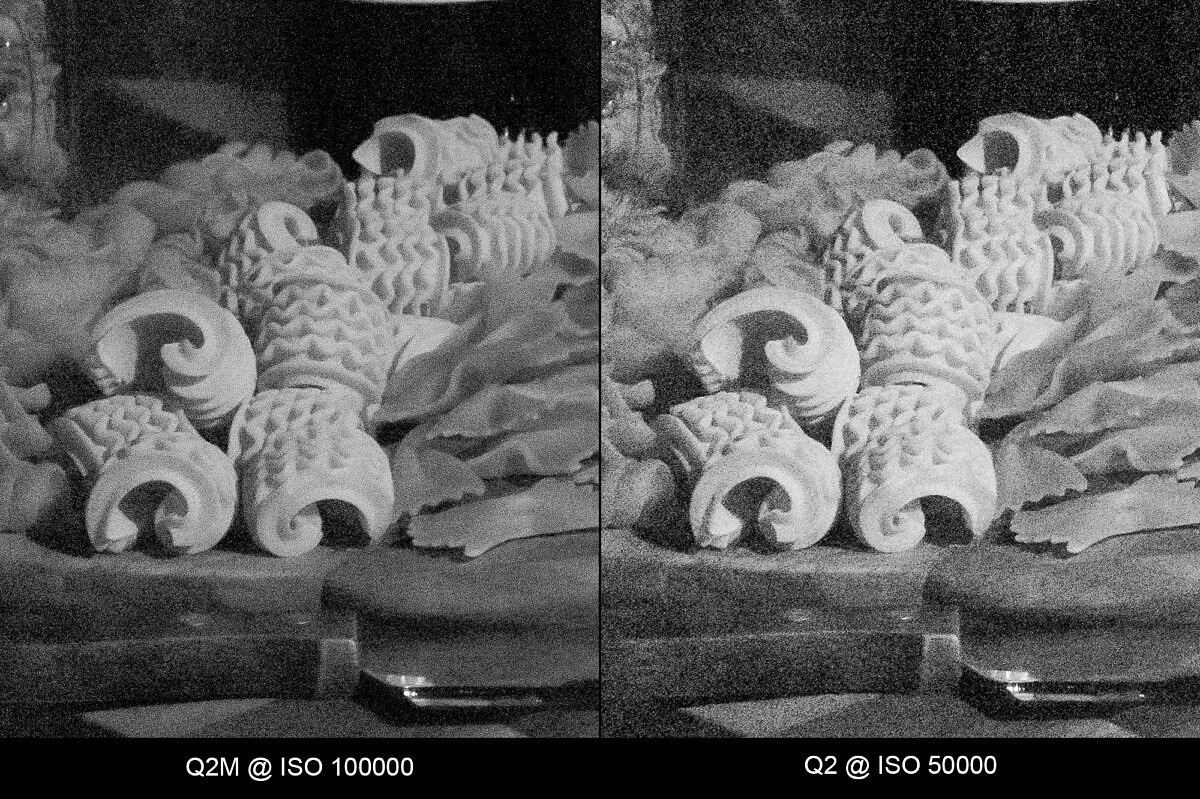
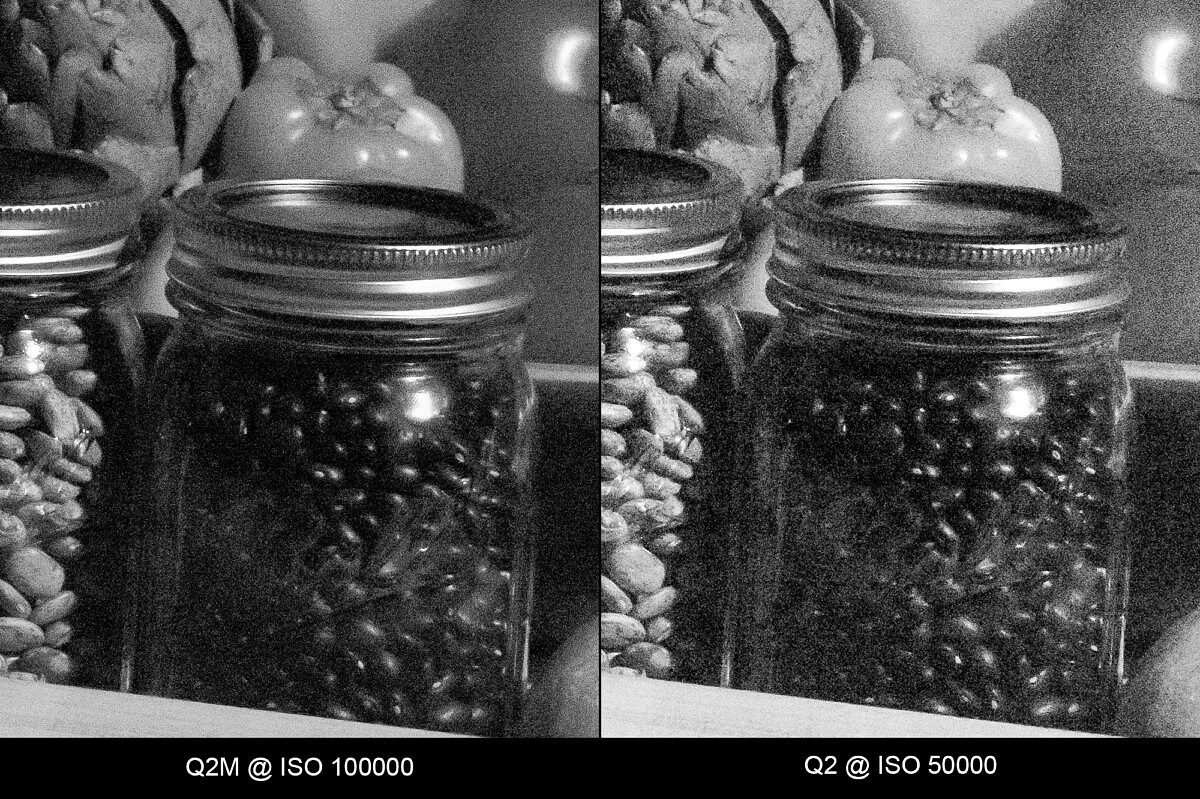
Ideal Maximums
Here, I wanted to see where the cameras hit their respective ideal maximum ISO values. By my definition, that means the highest ISO values achievable without a significant sacrifice of image quality. And thus we get ISO 25000 on the Q2M and ISO 6400 on the Q2, resulting in a solid and meaningful 2-stop advantage of the Q2M. Sure, you may find that you're willing to push this further, and you certainly can, but that 2-stop advantage will remain for Monochrom.
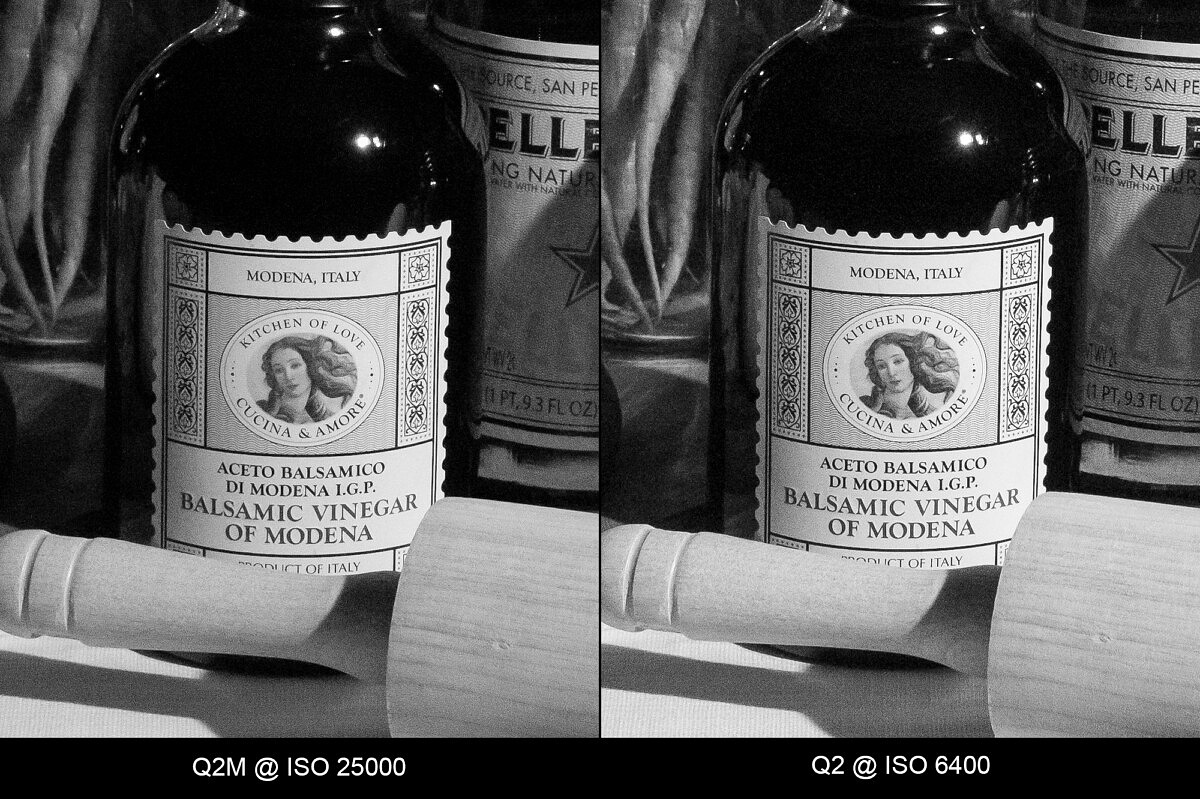
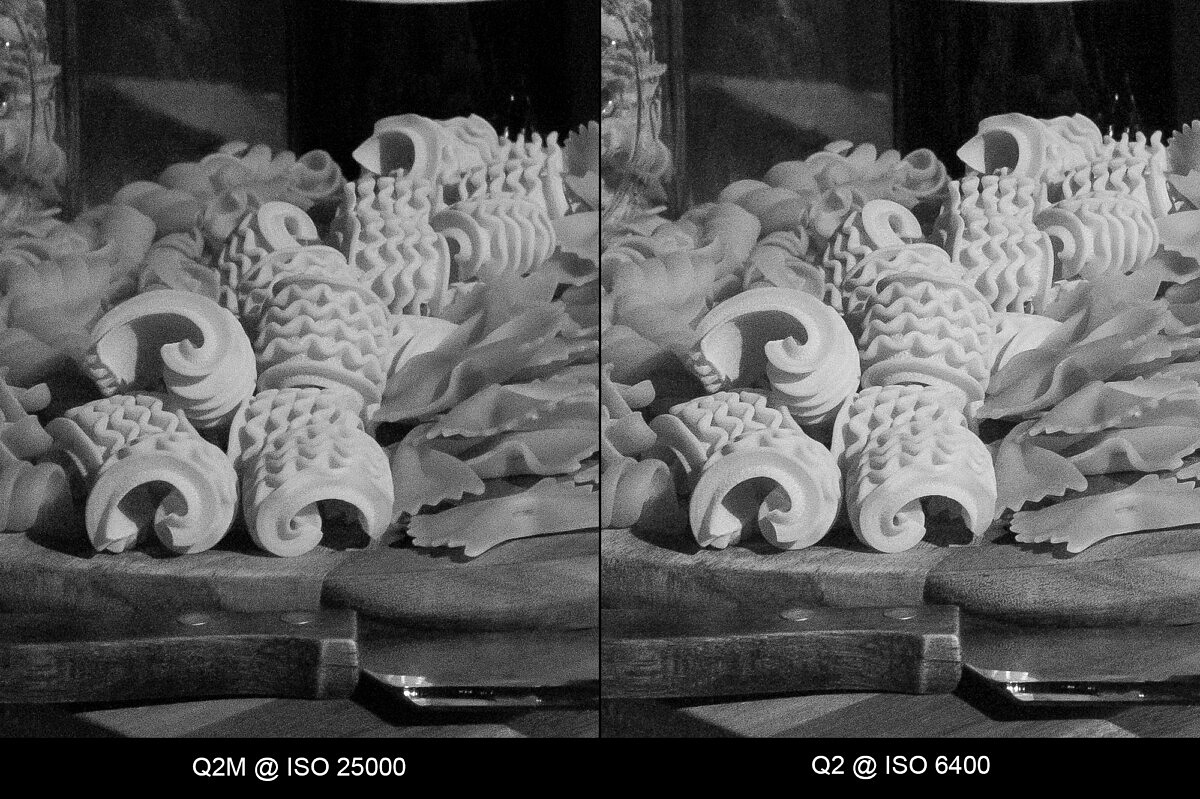
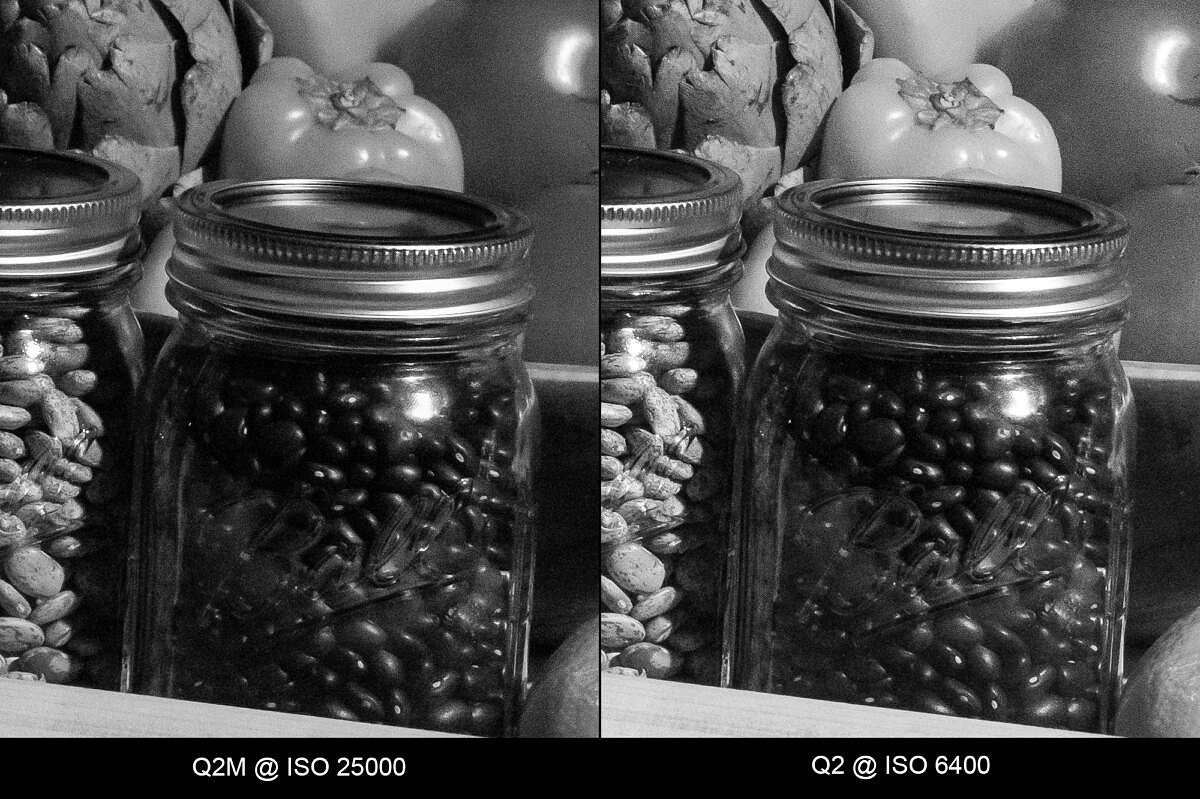
M10-R vs M10 Monochrom
We've already seen how the M10 performs at this kind of test in my 2020 B&W ISO Showdown, but not as it compares to its color counterpart, the M10-R. That camera wasn't on the Leica roster the last time, so this match-up should be quite interesting. Just like the Q2M versus Q2 comparison above, both of these M cameras feature the same underlying sensor. In this case, the M cameras feature the excellent dual-gain 41 megapixel CMOS chip, one using a CFA for full color and the other in tuned for black and white.
ISO 100 / 160
Starting at the respective base ISO values for each of the M cameras, we're treated to truly exceptional image quality. Amazing detail, texture and tonality. And this level of quality is maintained on both cameras easily up to ISO 3200. Truly, every setting from ISO 100 to ISO 3200 looks virtually identical on the M10-R and M10M. This immediately puts the M10-R performance a notch above the Q2, and almost on par with the Q2M. Not a bad start.
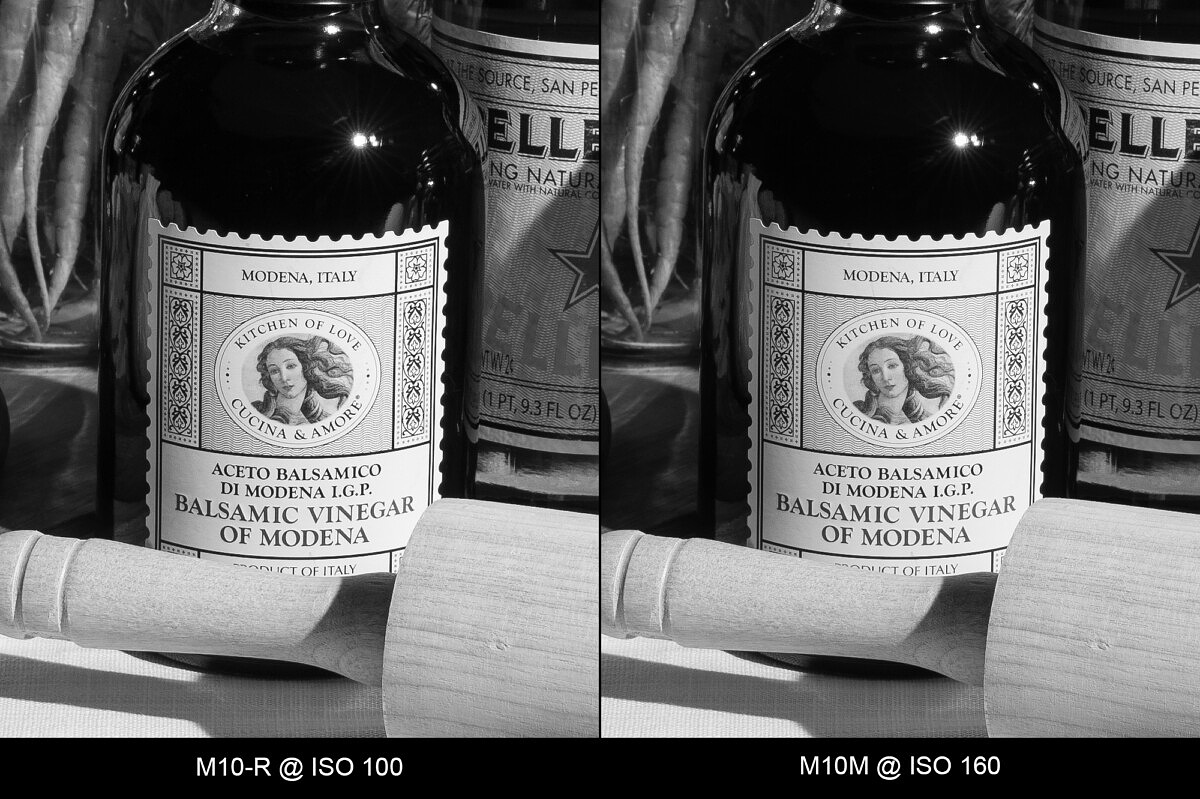
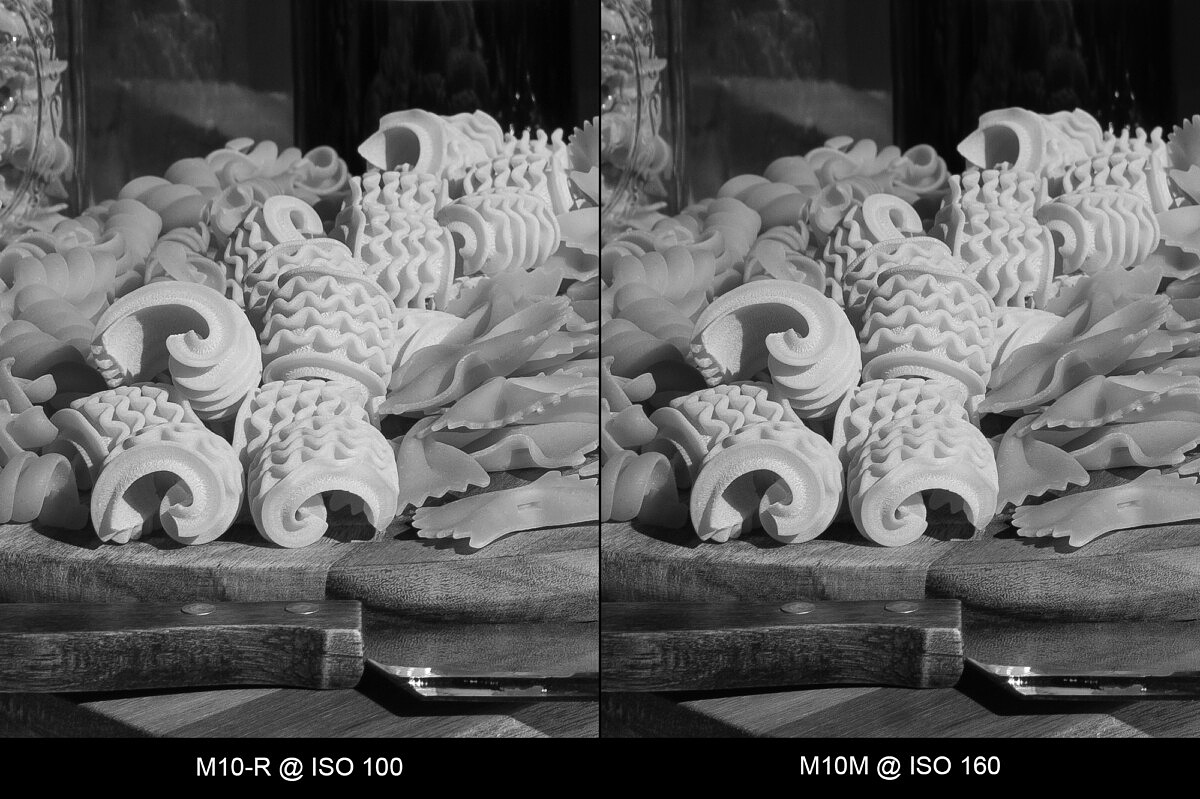
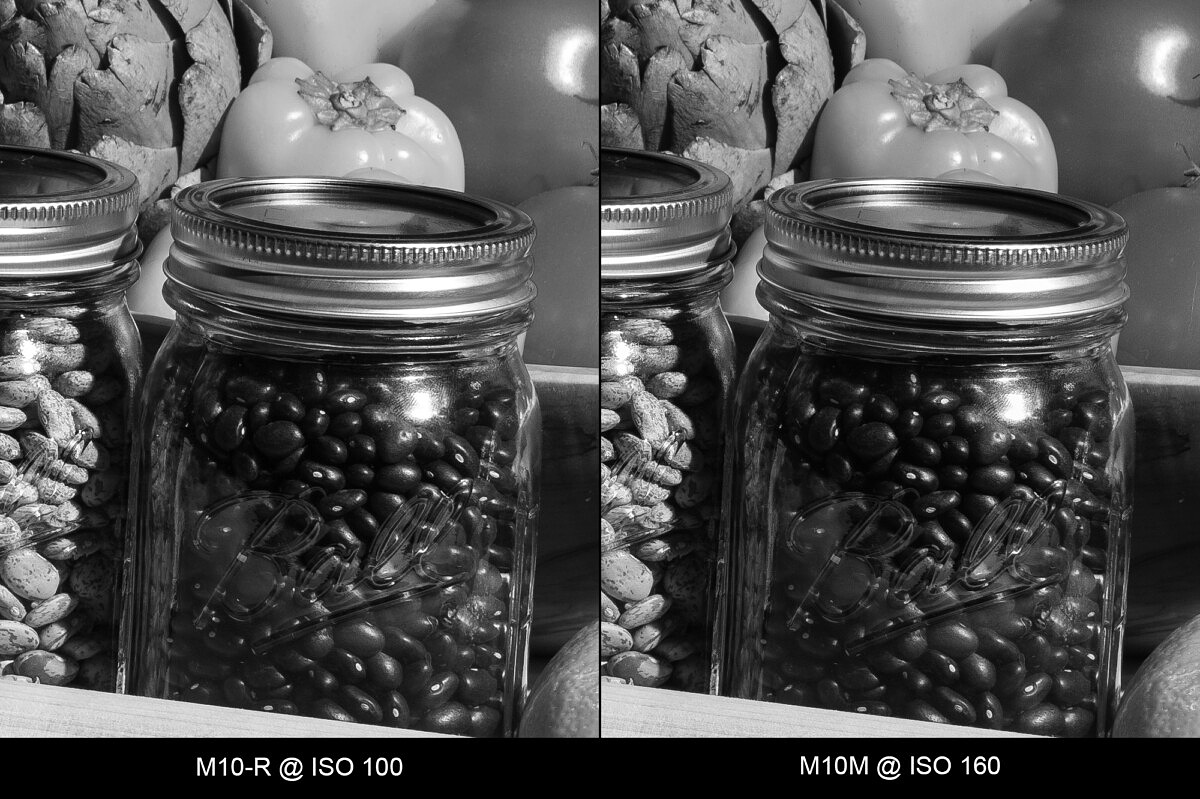
ISO 200
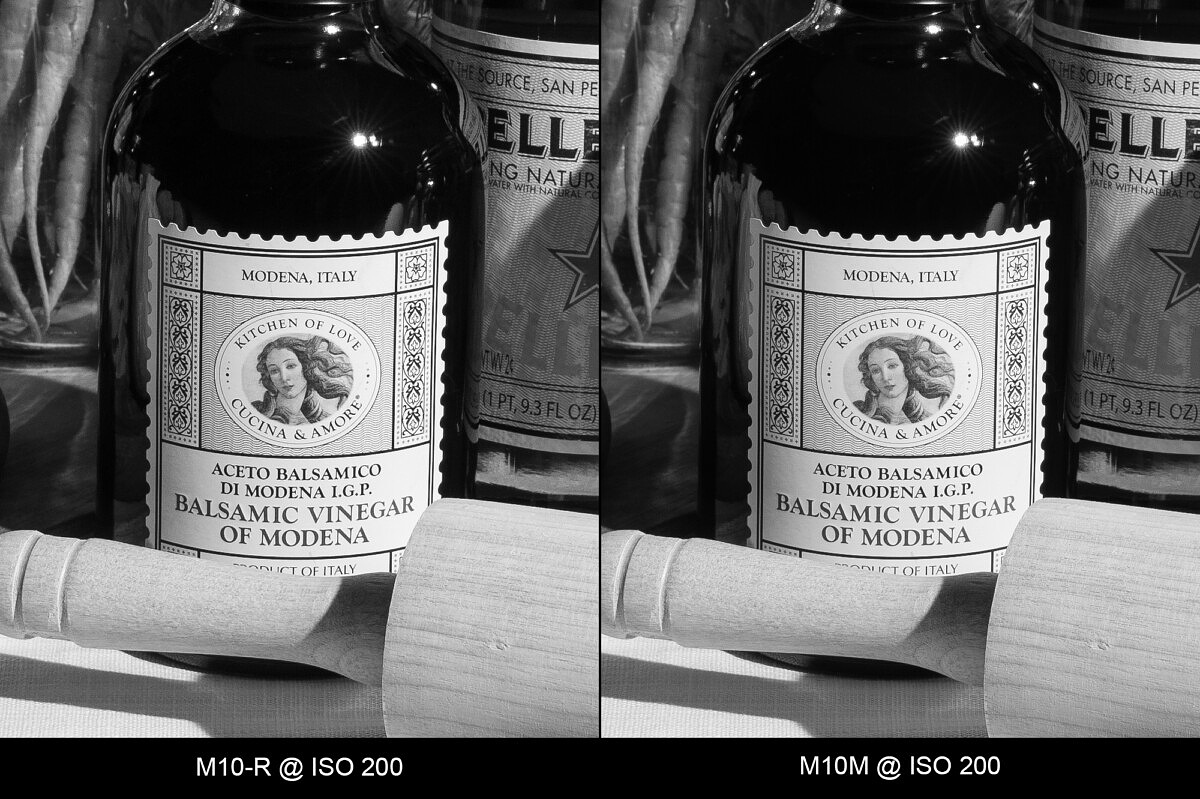
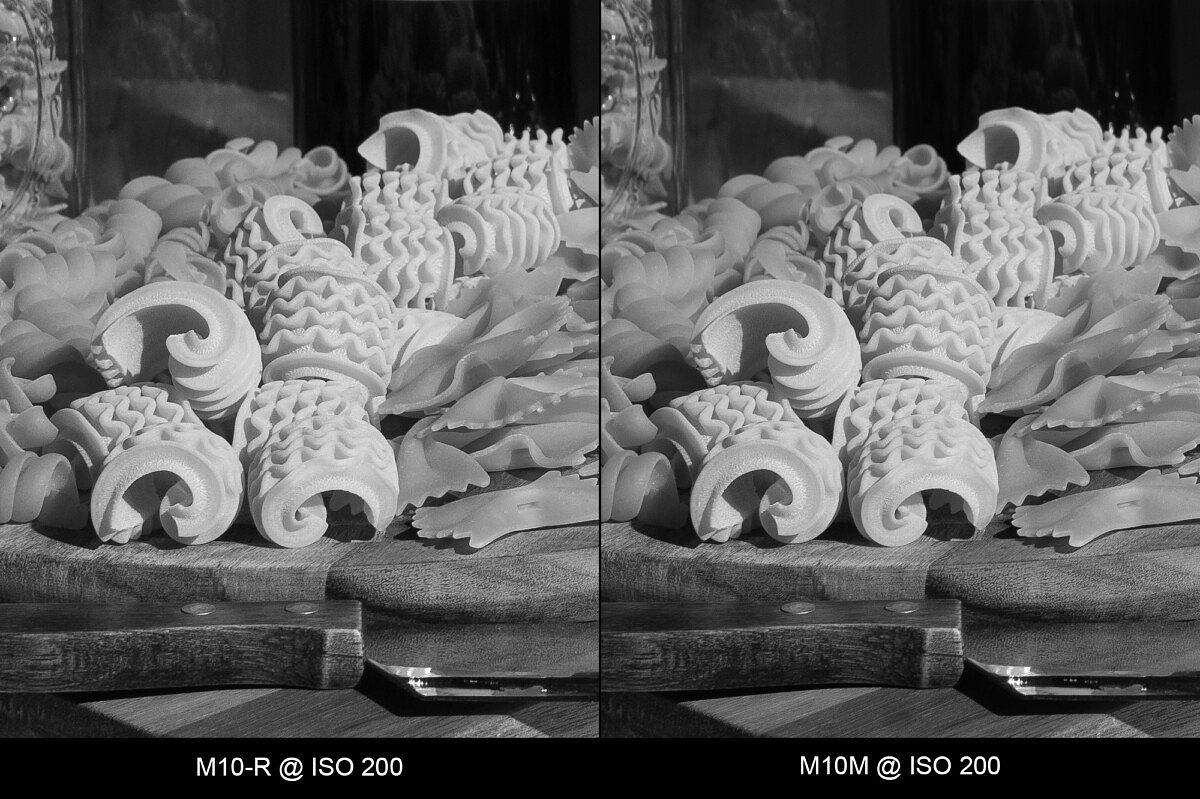
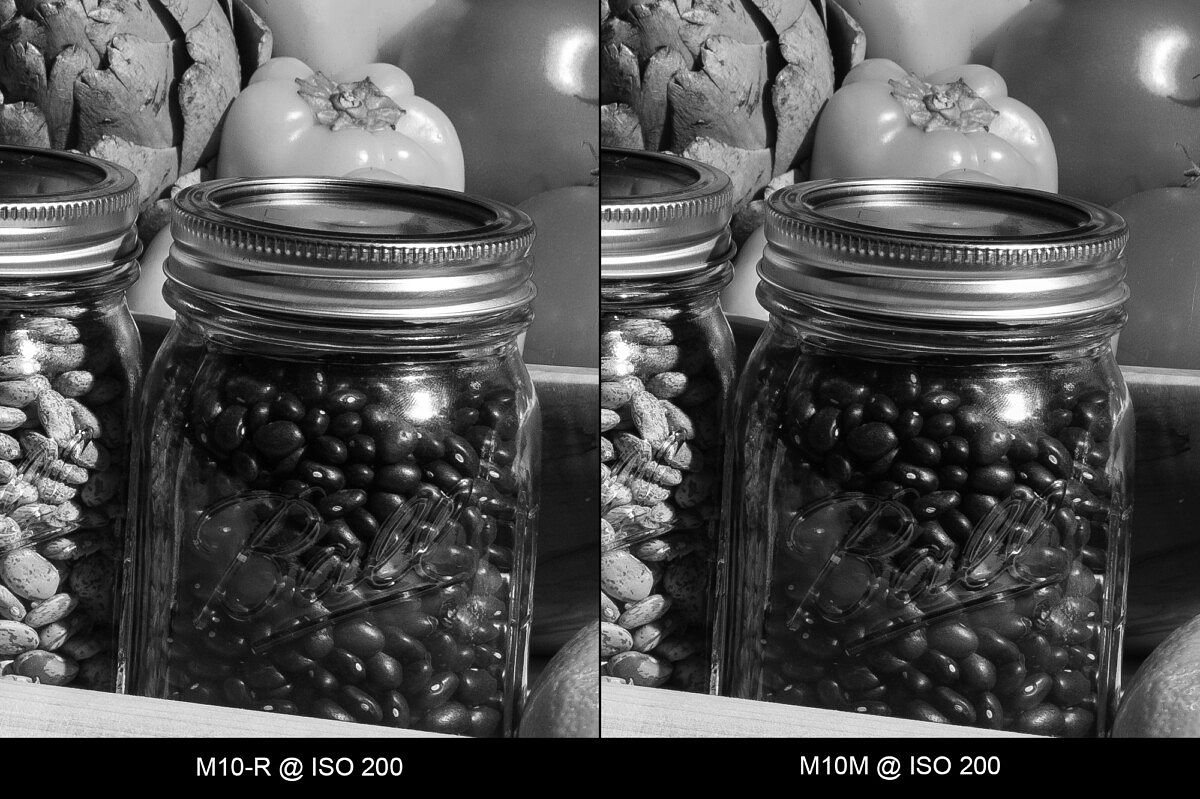
ISO 400
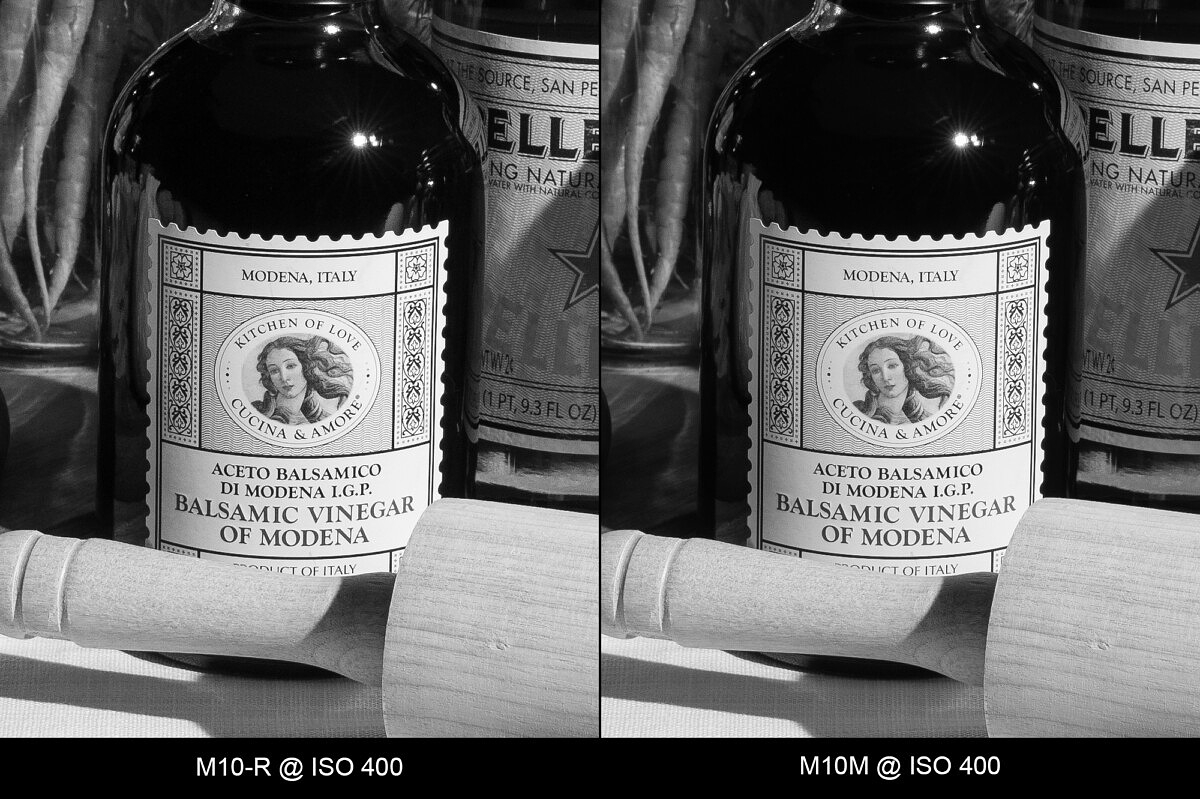
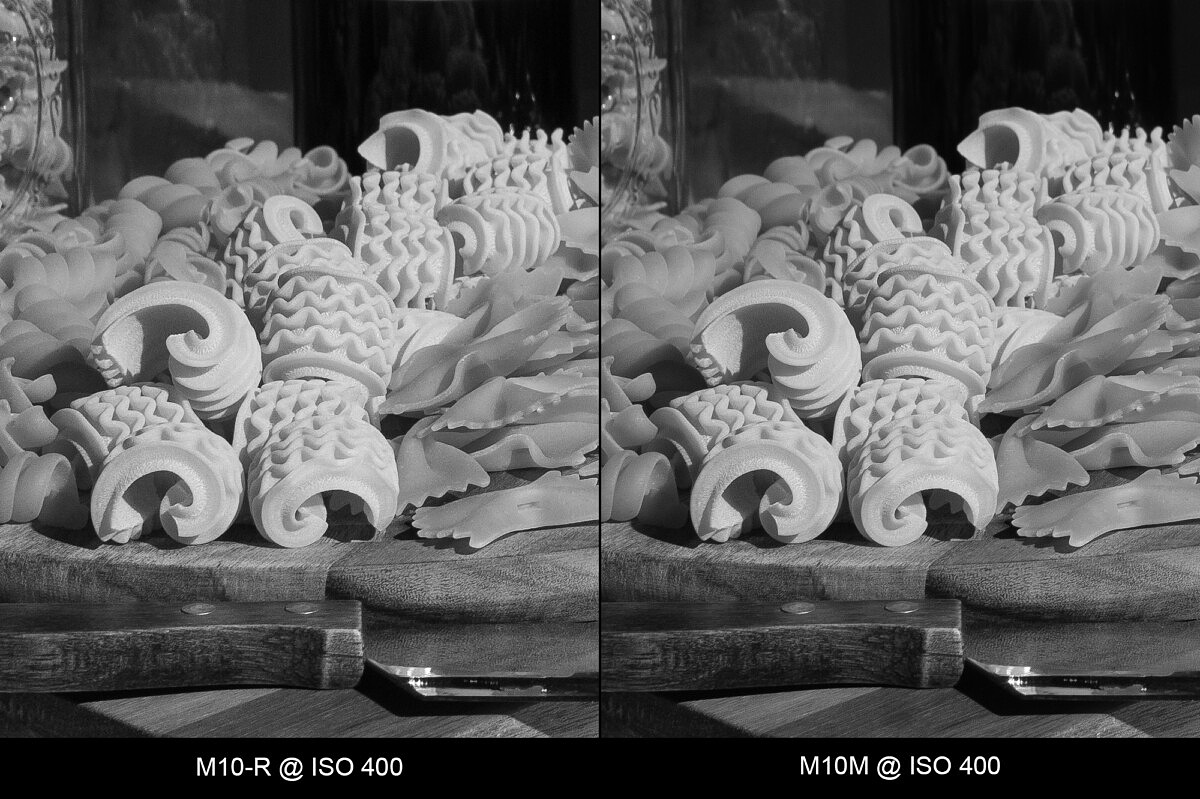
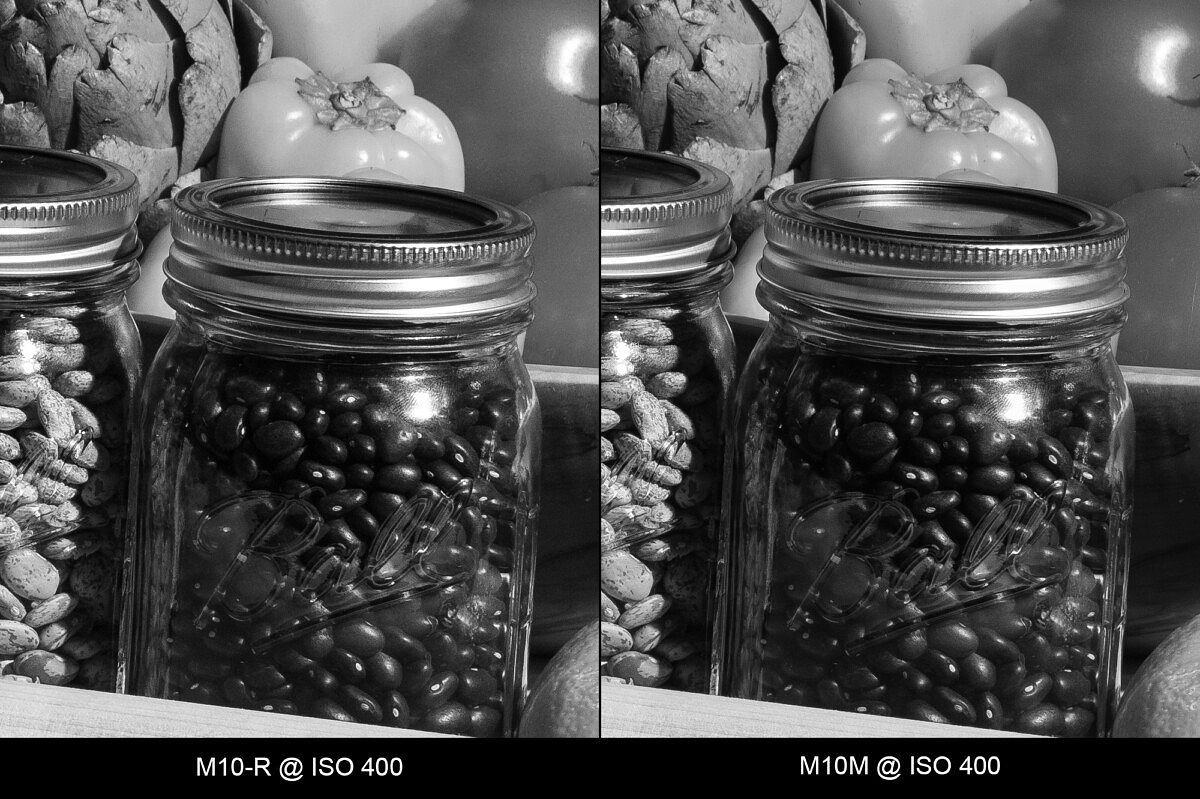
ISO 800
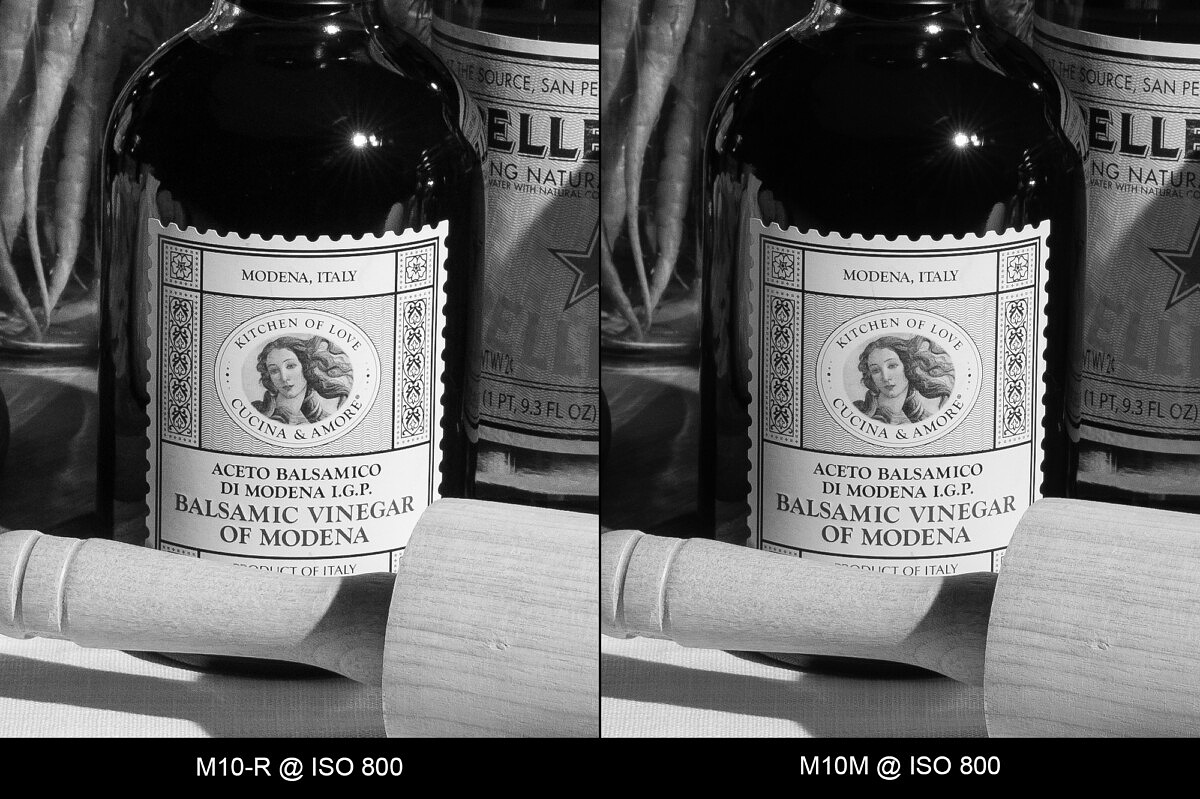
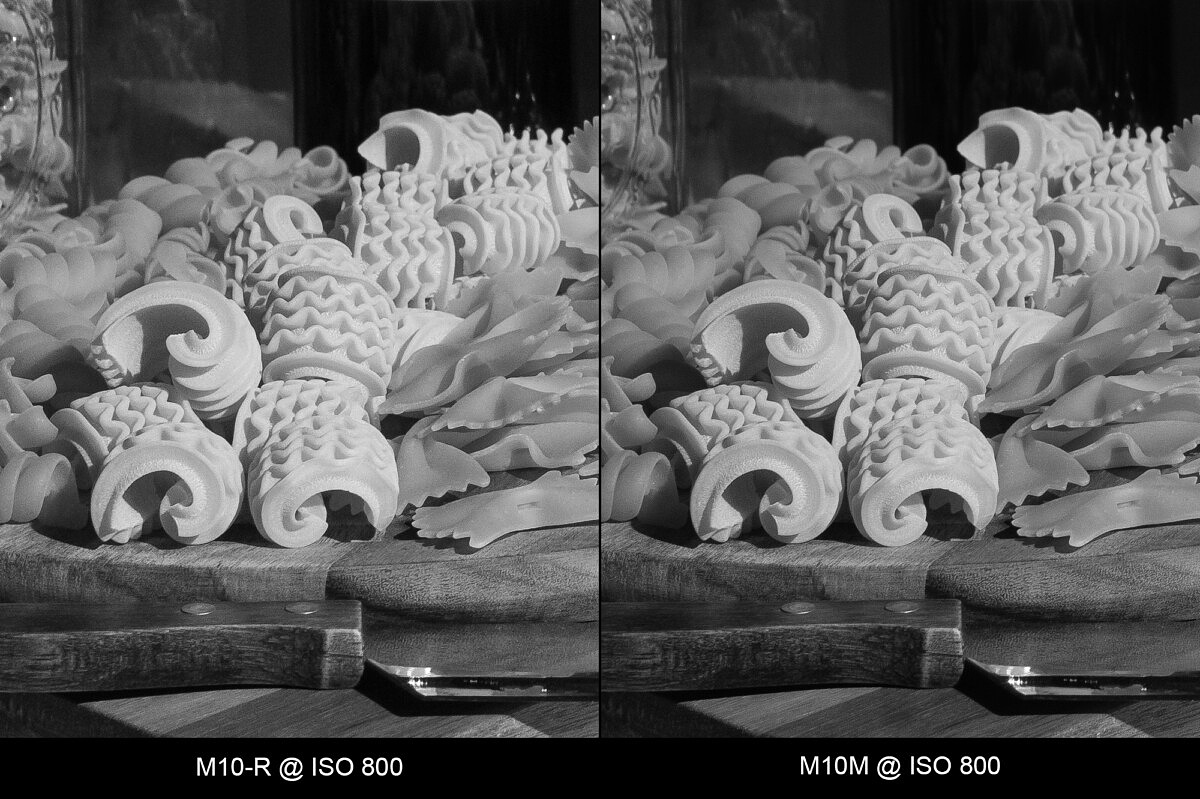
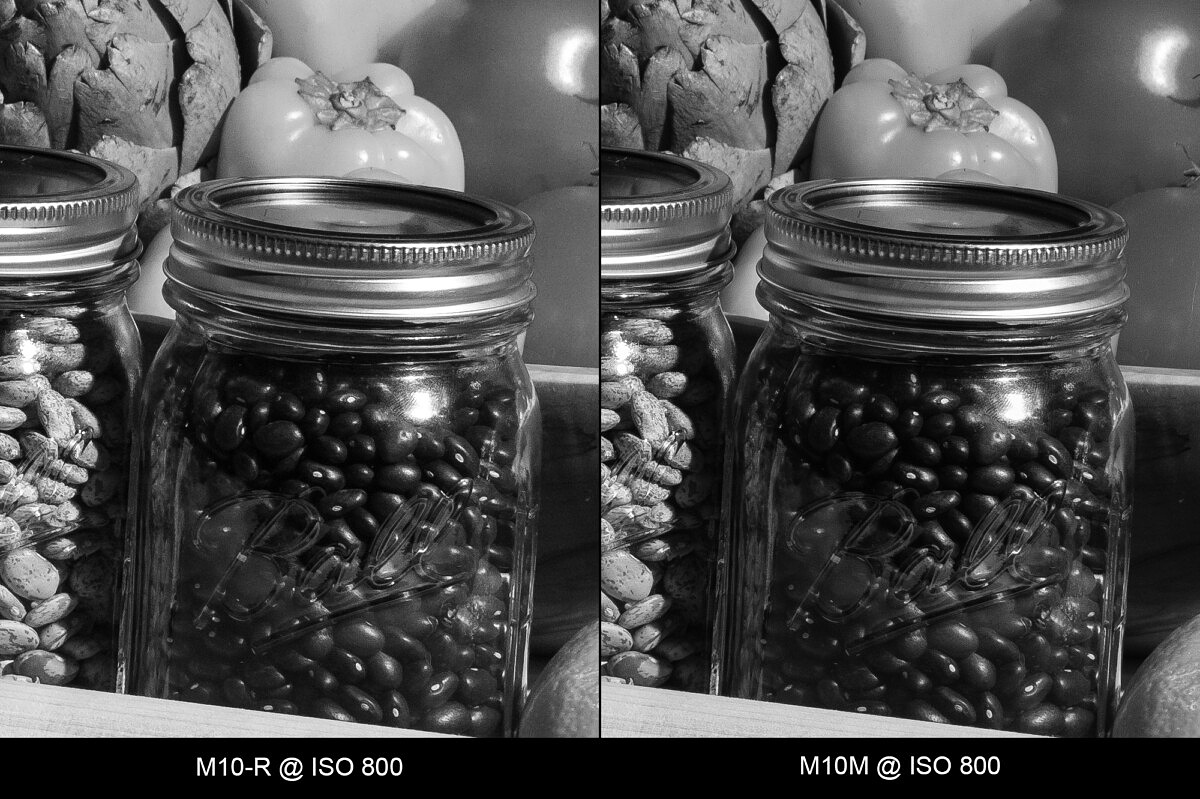
ISO 1600
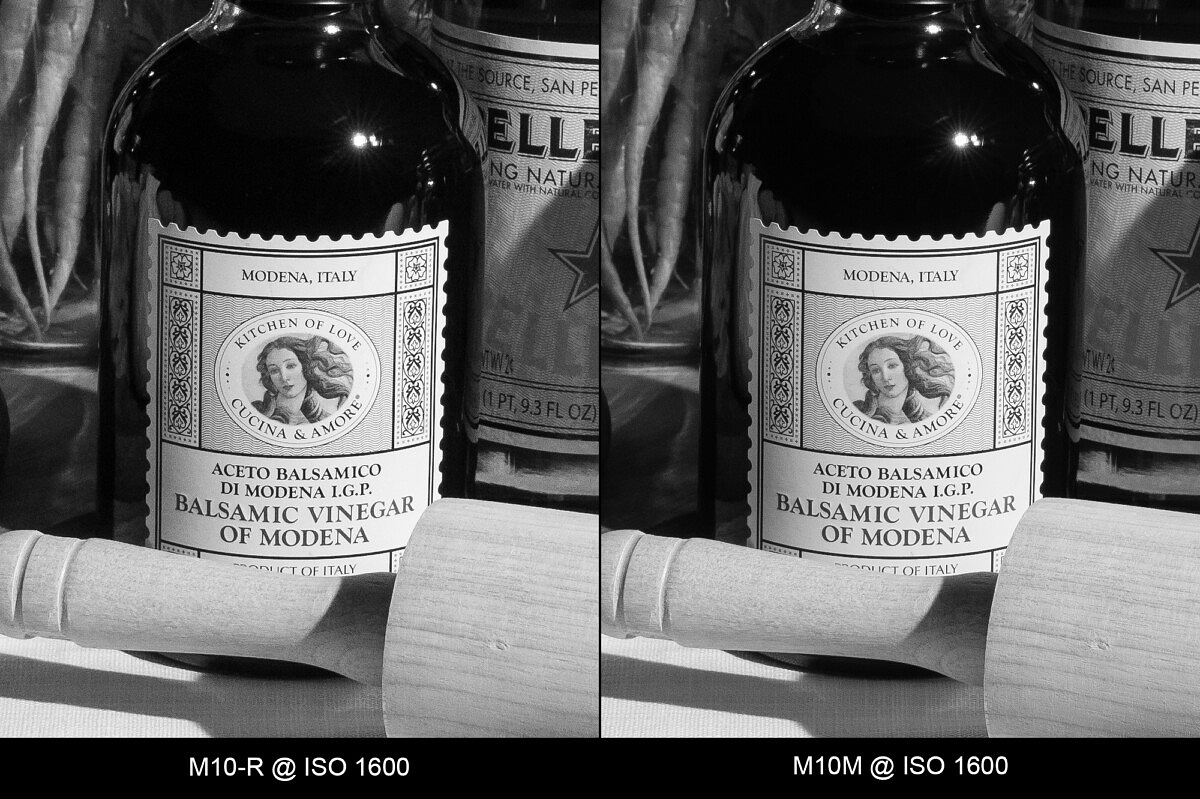
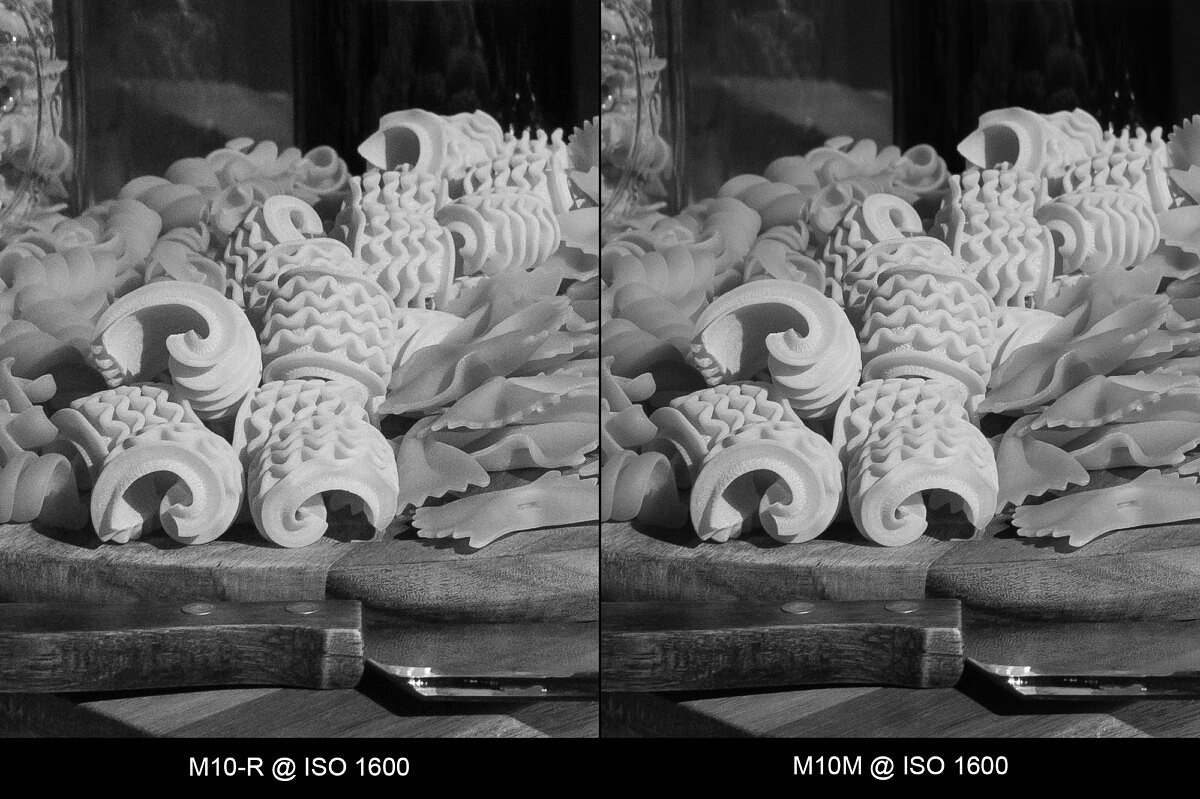
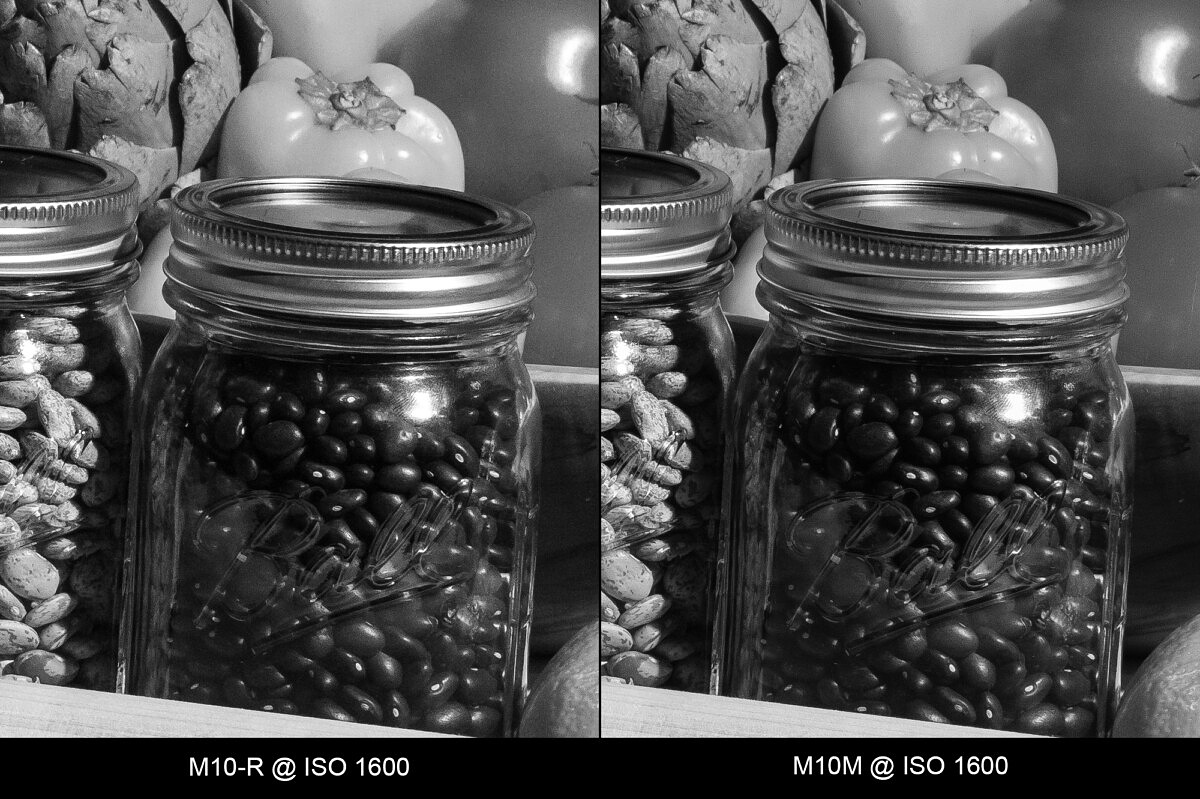
ISO 3200
I feel we are nitpicking here, but the M10-R is starting to show just the smallest amount of visible noise, while the M10M is still super clean. The noise pattern is very tightly packed and doesn't hurt detail resolution at all. This is extremely impressive given the higher pixel density of the M10-R over the 24 megapixel M10 and M10-P.
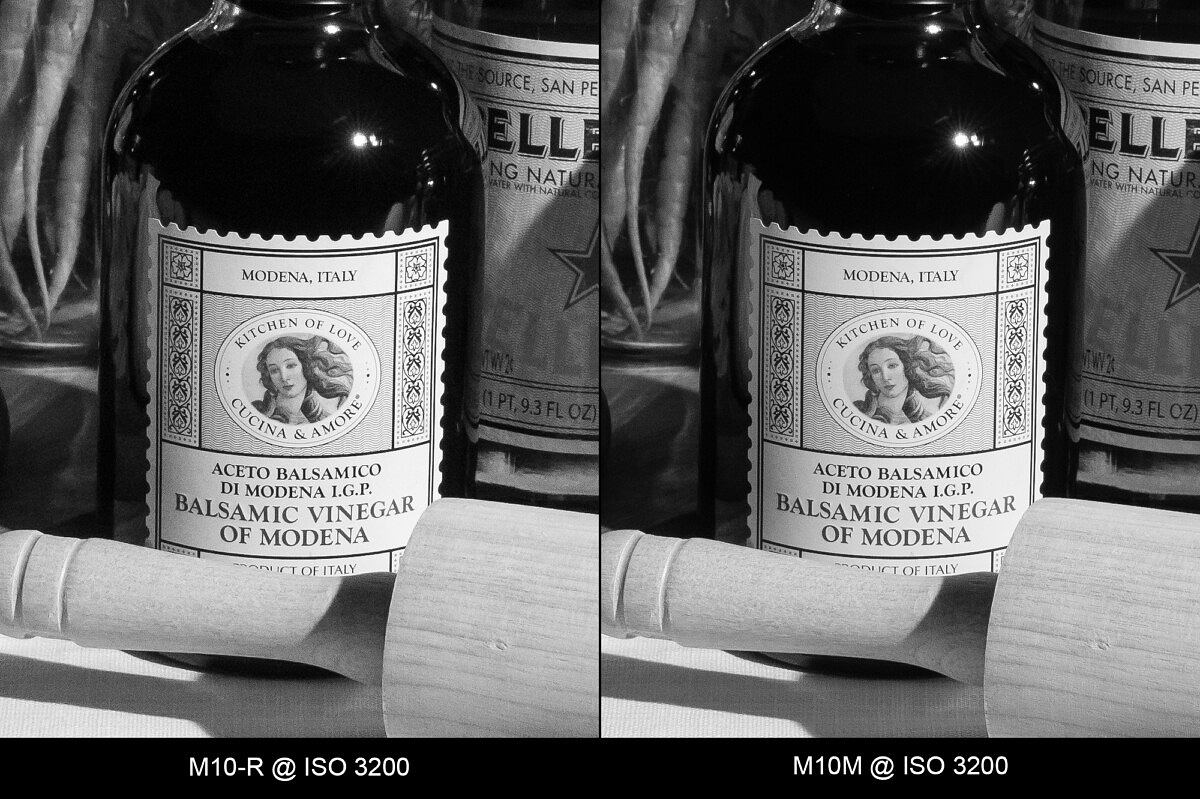
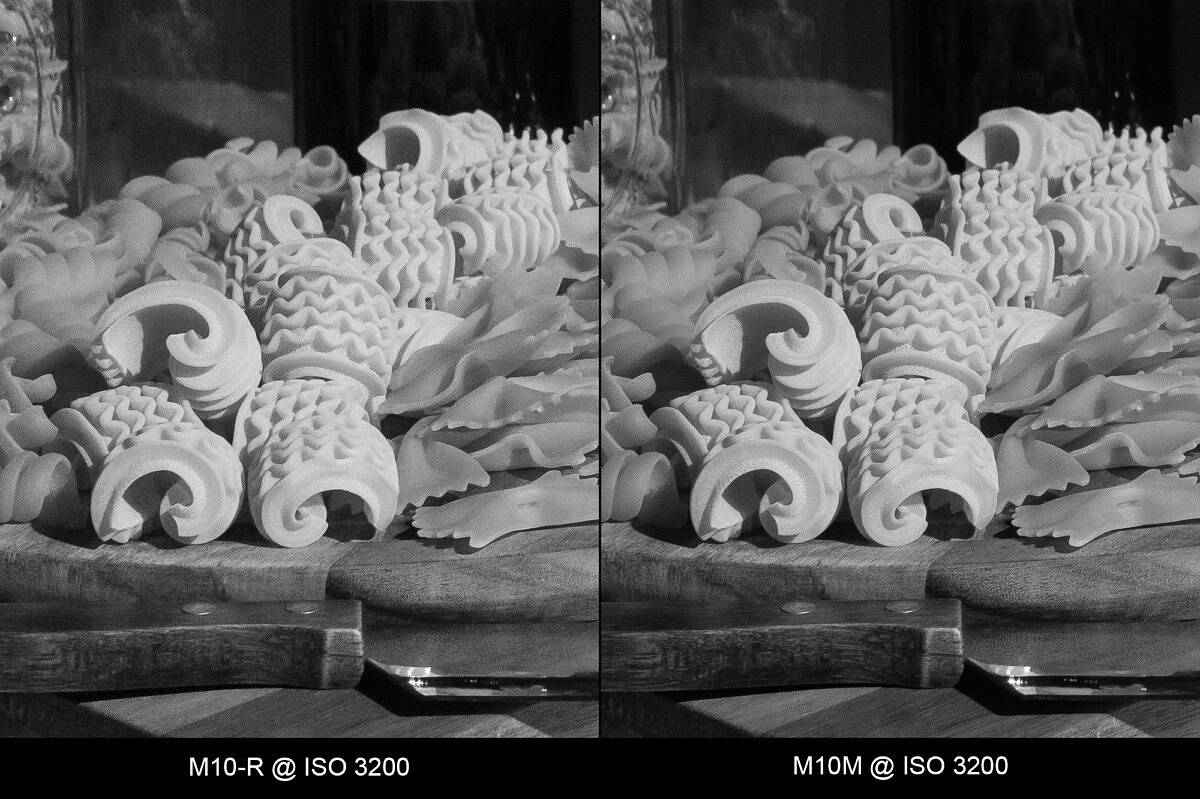
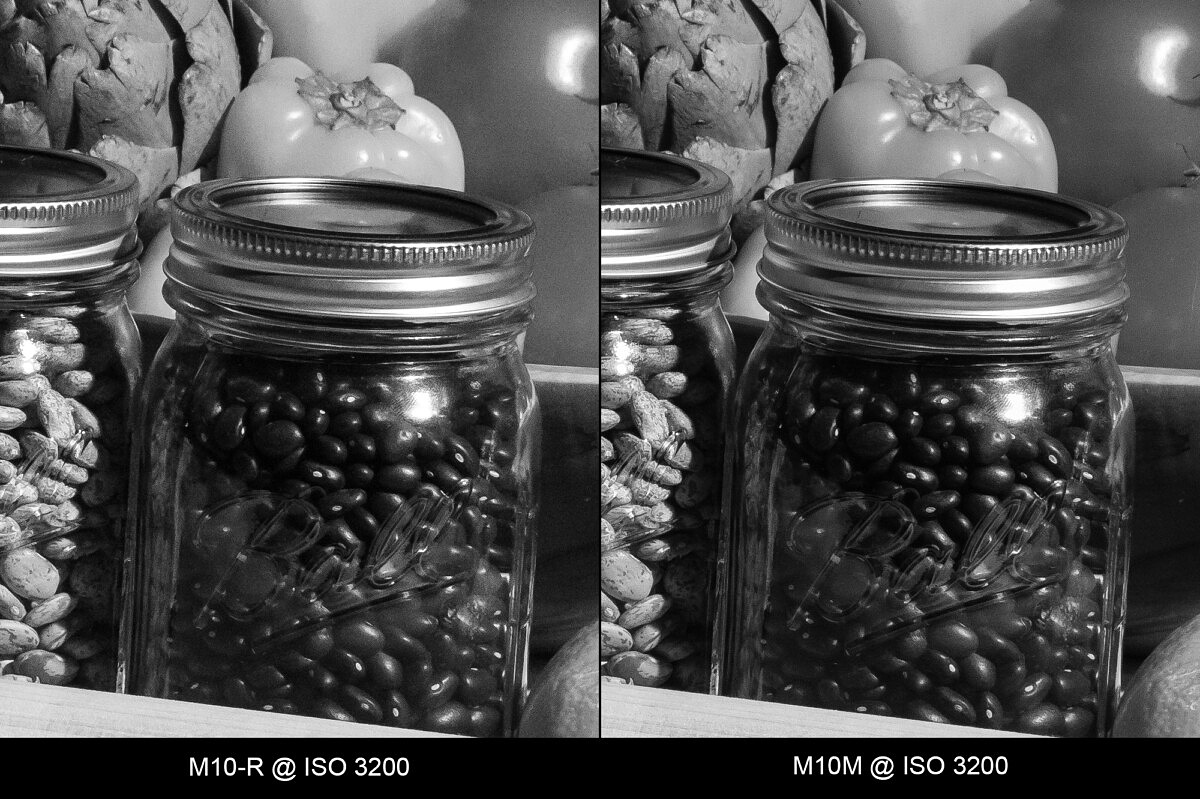
ISO 6400
At ISO 6400, noise is just starting to become visible in the M10M image now, with the M10-R not worsening by very much from the ISO 3200 result. Both cameras are performing extremely well.
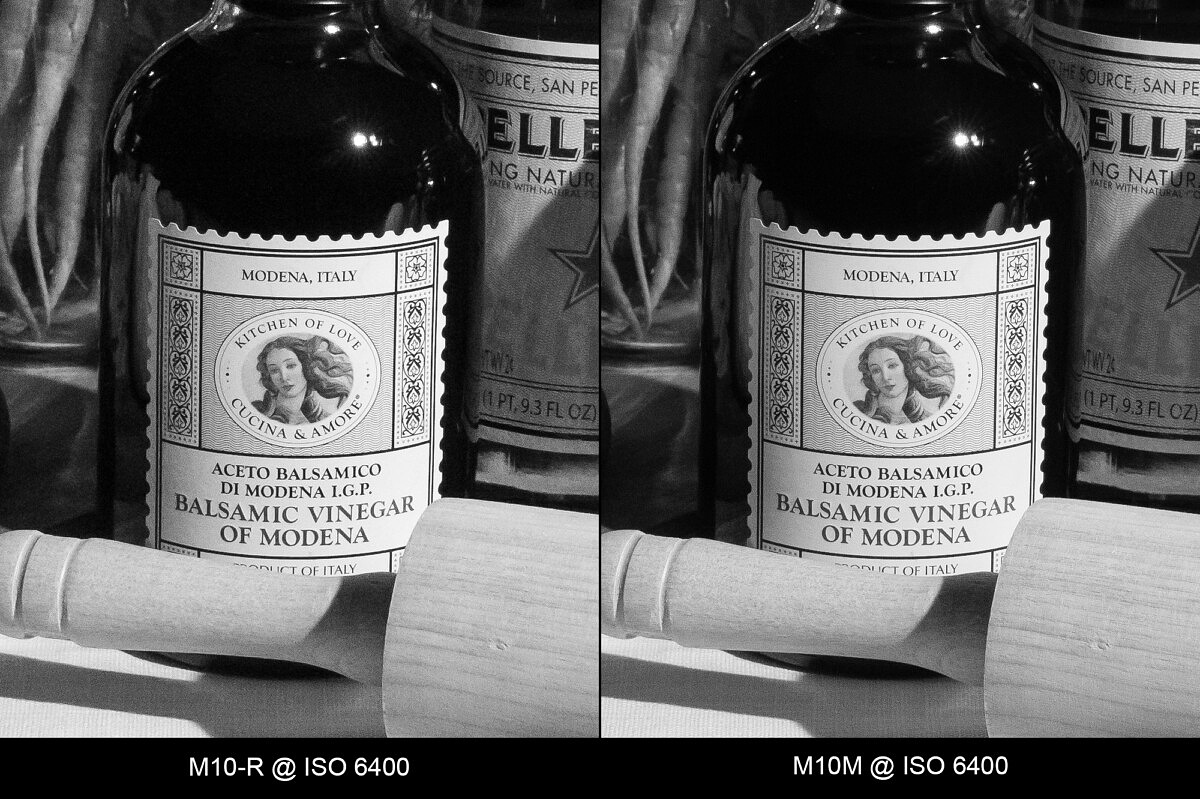
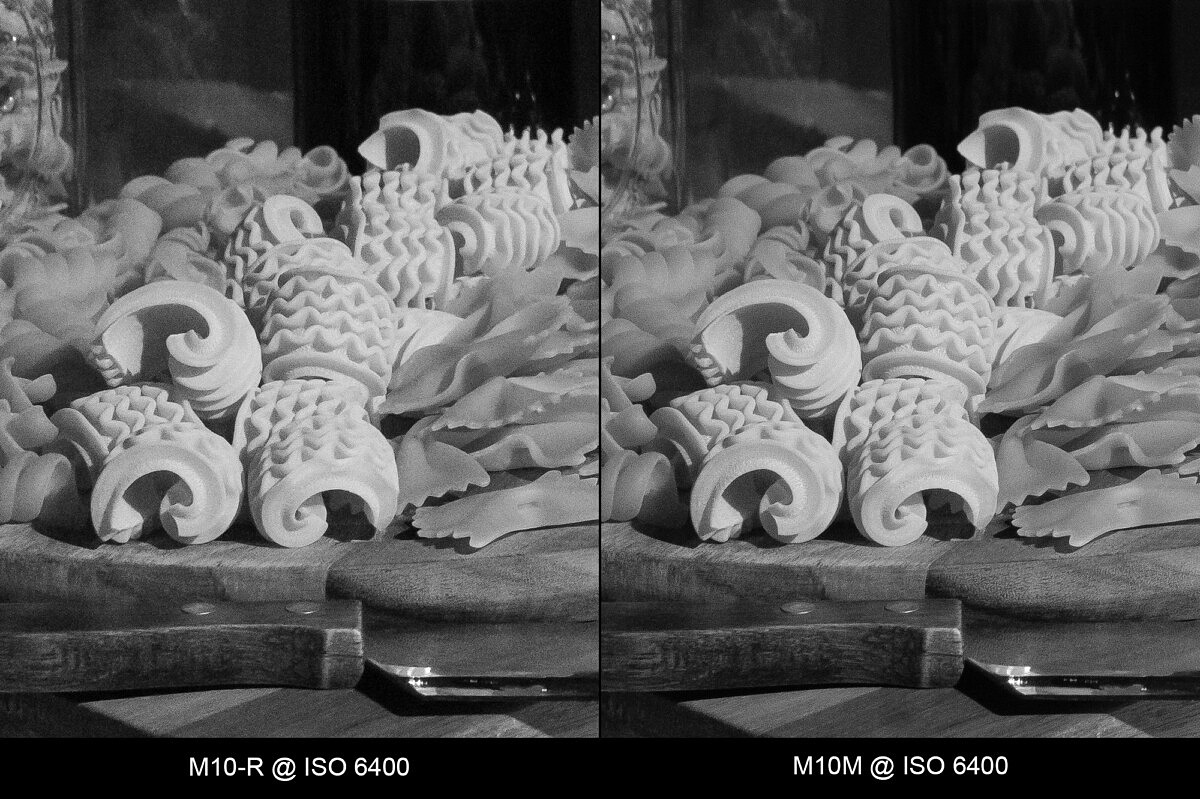
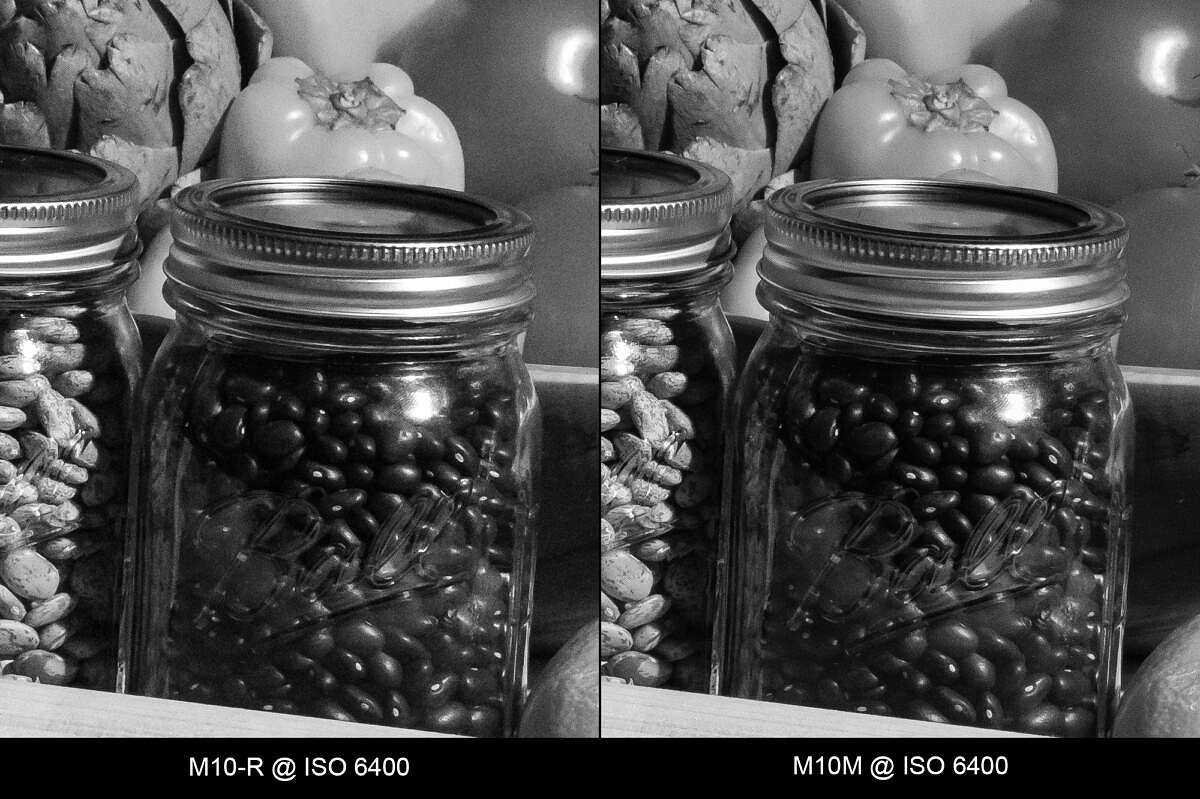
ISO 12500
At ISO 12500, the M10-R is still keeping noise under control, but the M10 Monochrom clearly has an advantage with better resolution and smoother tonal gradations. In our previous ISO Showdown, this is really where the M10M started to shine against its predecessor, the M Monochrom (Typ 246).
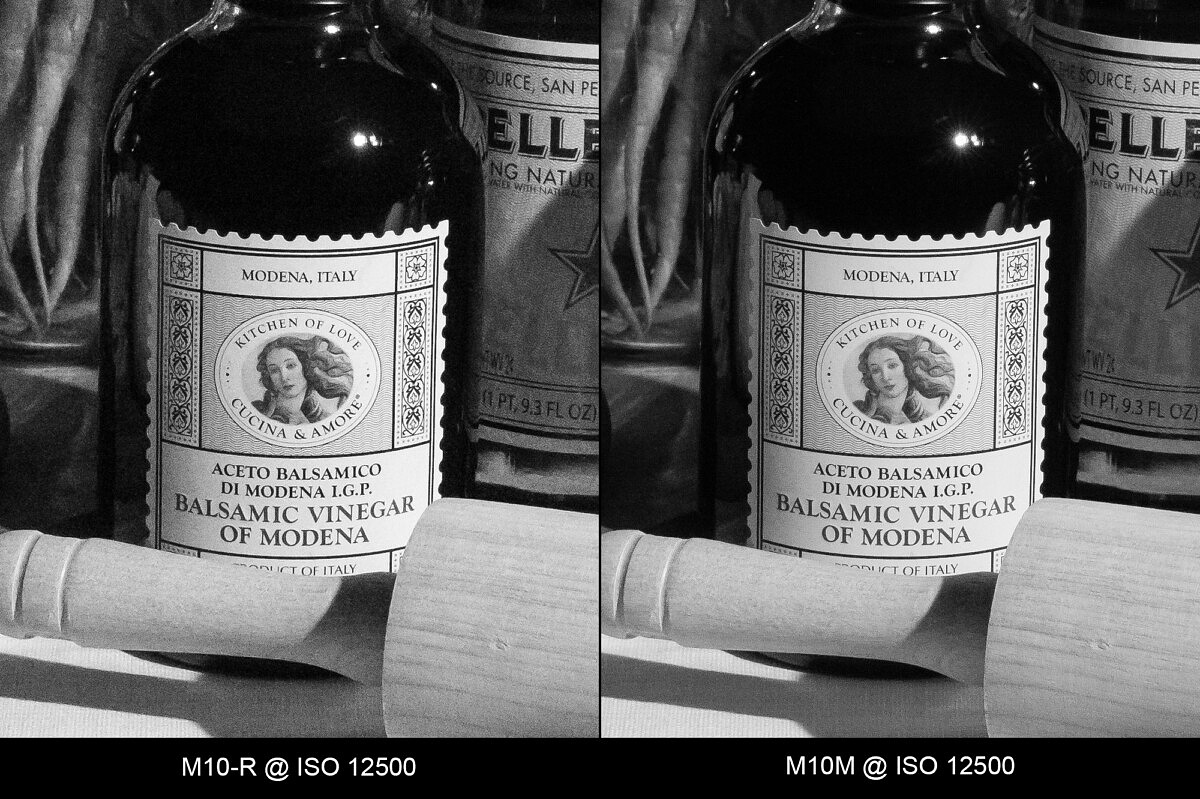
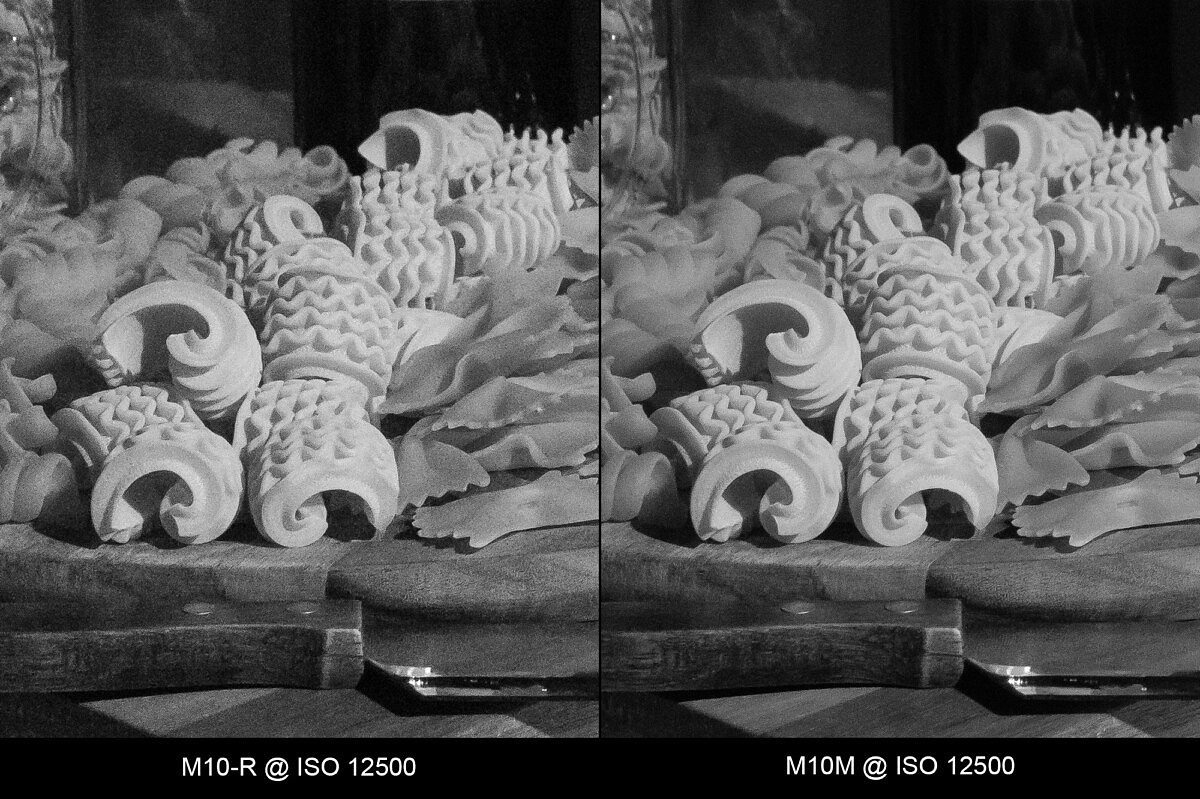
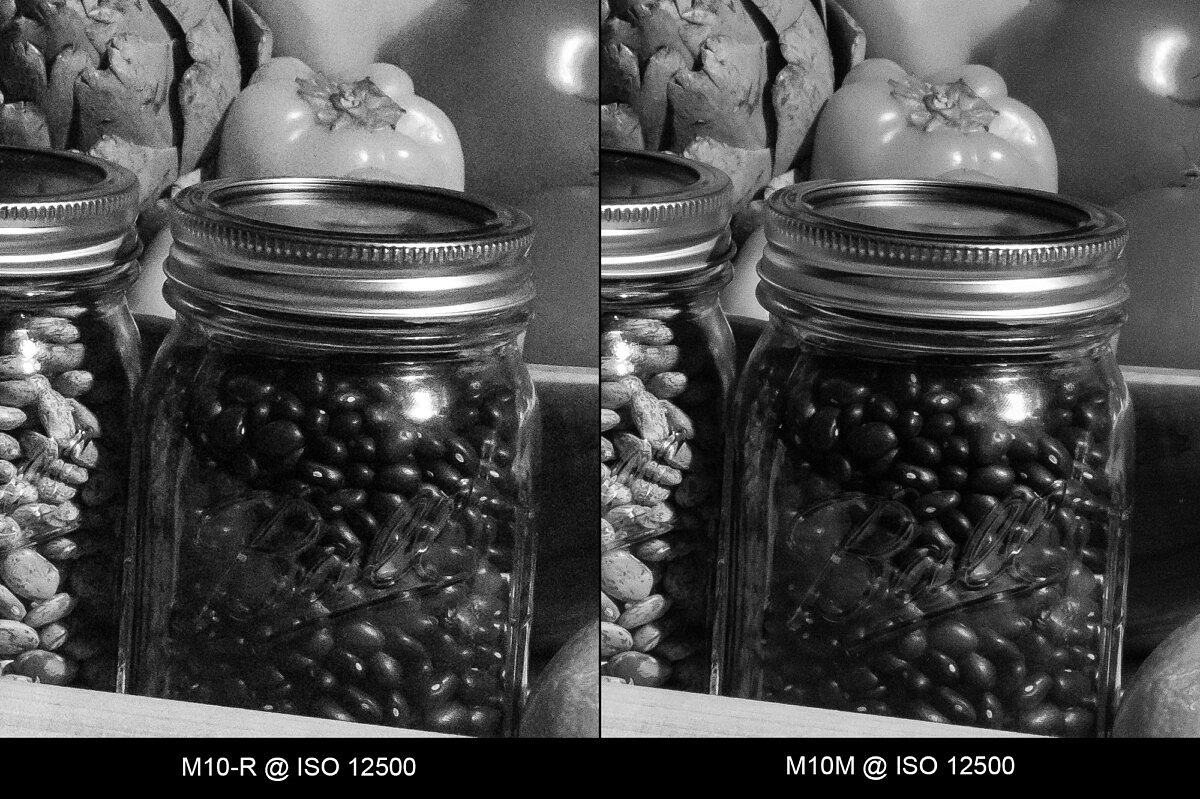
ISO 25000
At ISO 25000, the M10 Monochrom continues to pull away from its color counterpart. The M10-R is showing much more noise and is giving up detail and tonal gradations, but the M10M is still going strong.
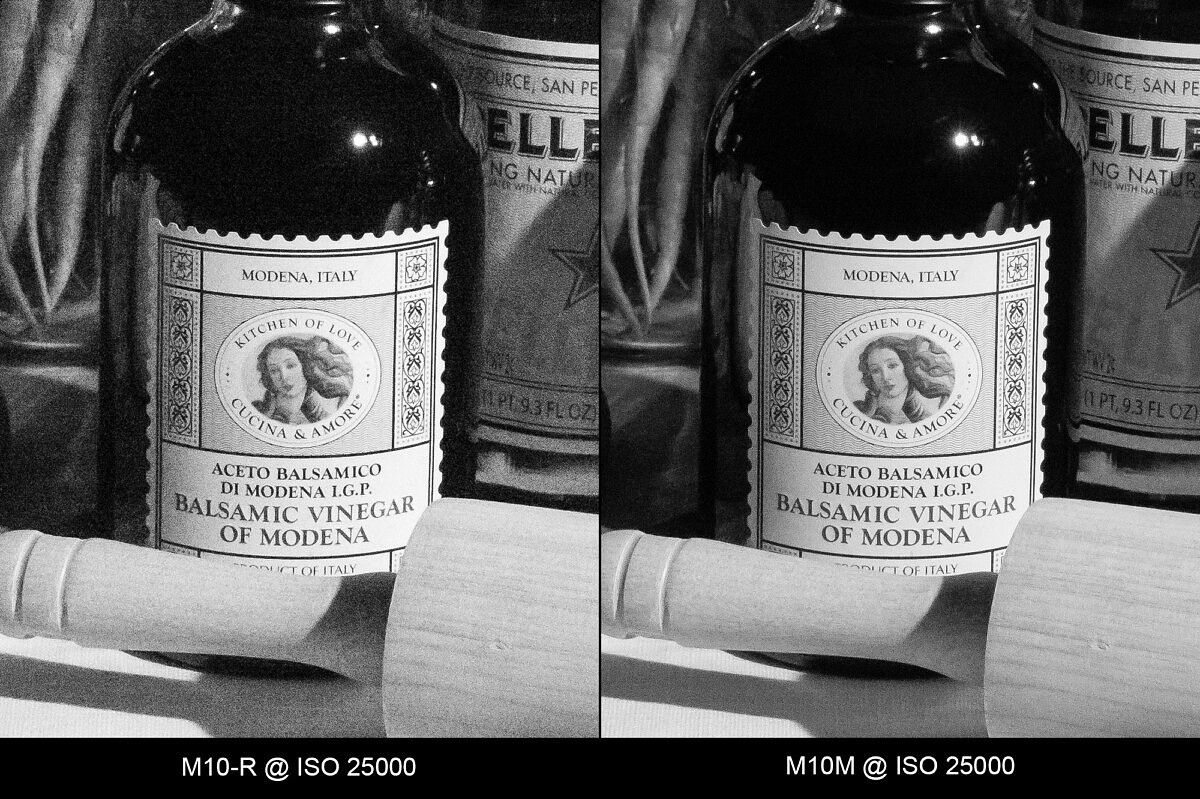
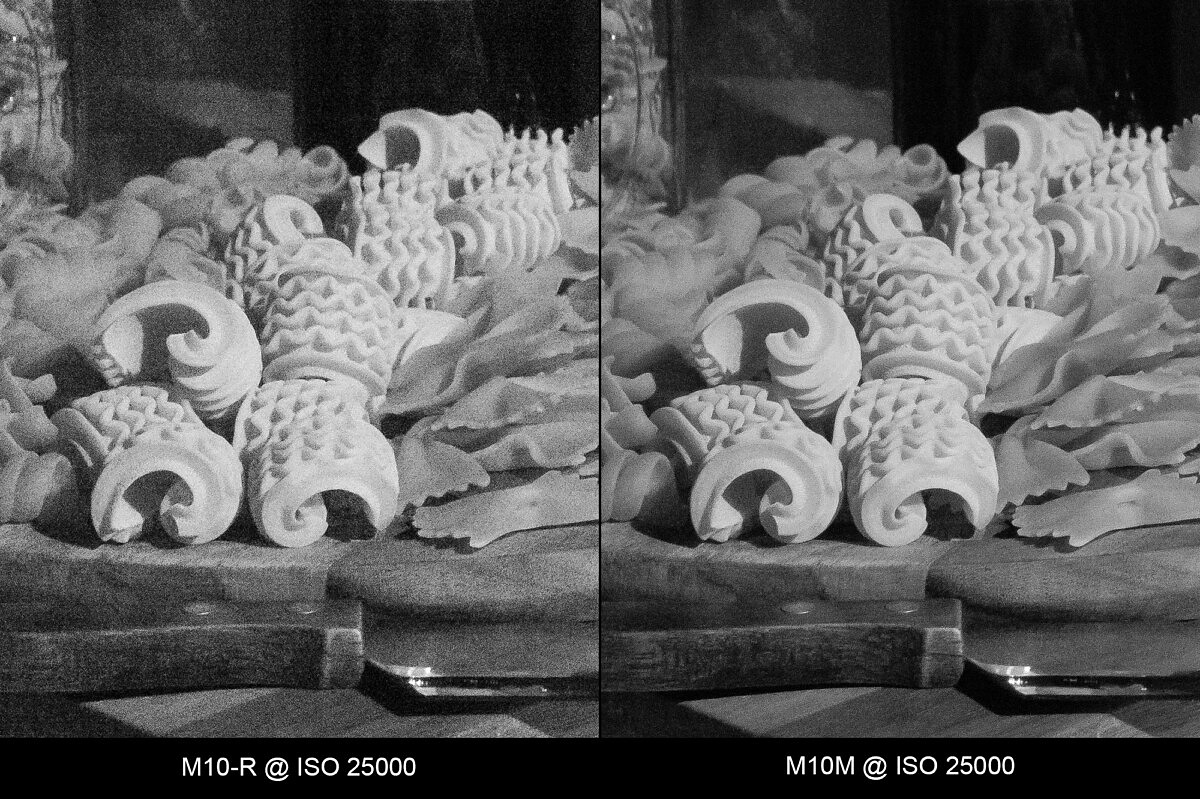
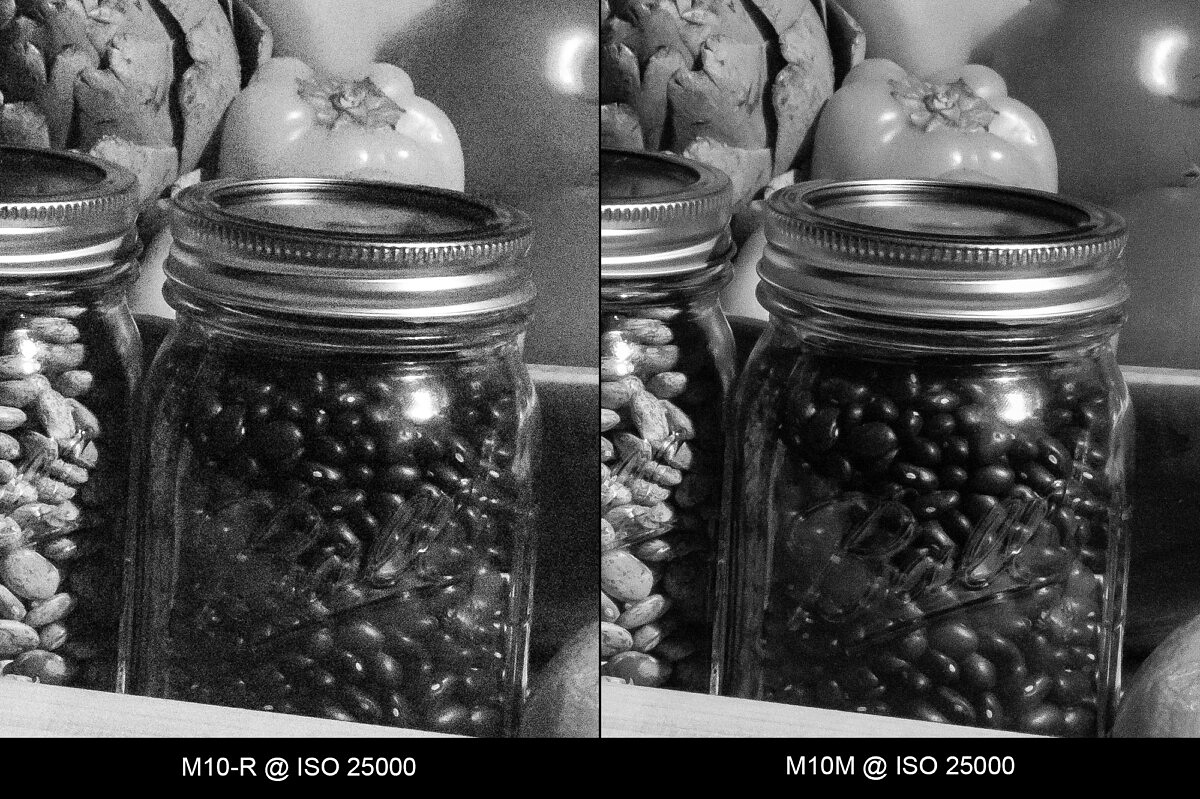
ISO 50000
The M10M is definitely usable at ISO 50000, but shows a noticeable jump in noise from ISO 25000. The M10-R, at its maximum ISO value, isn't great here. Lots of noise, some banding in darker areas, and general loss of contrast and detail.
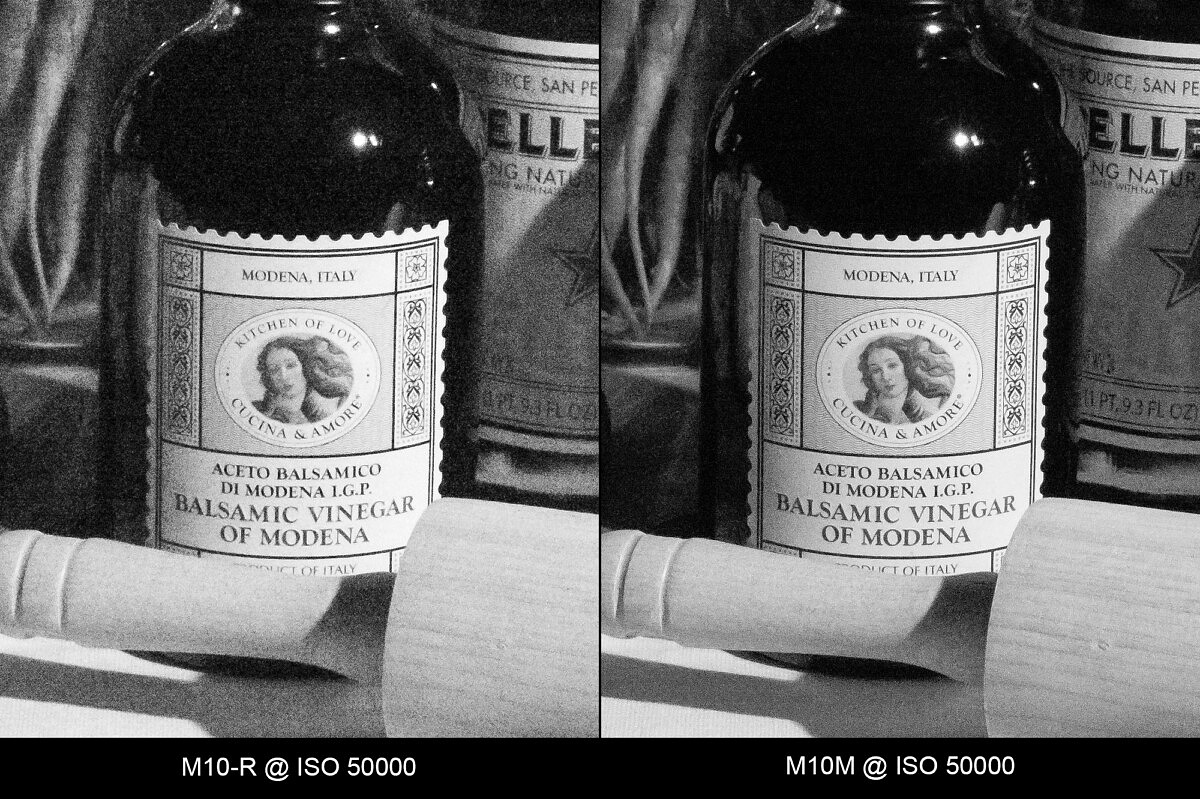
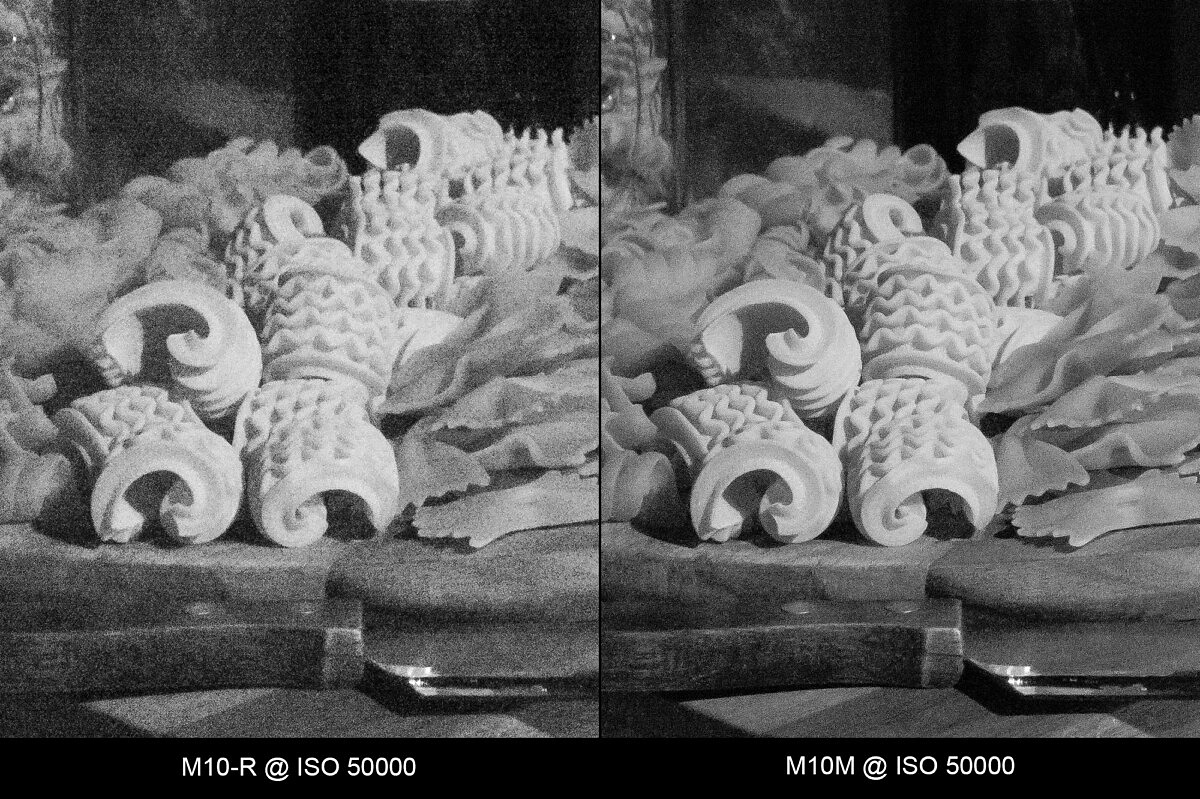
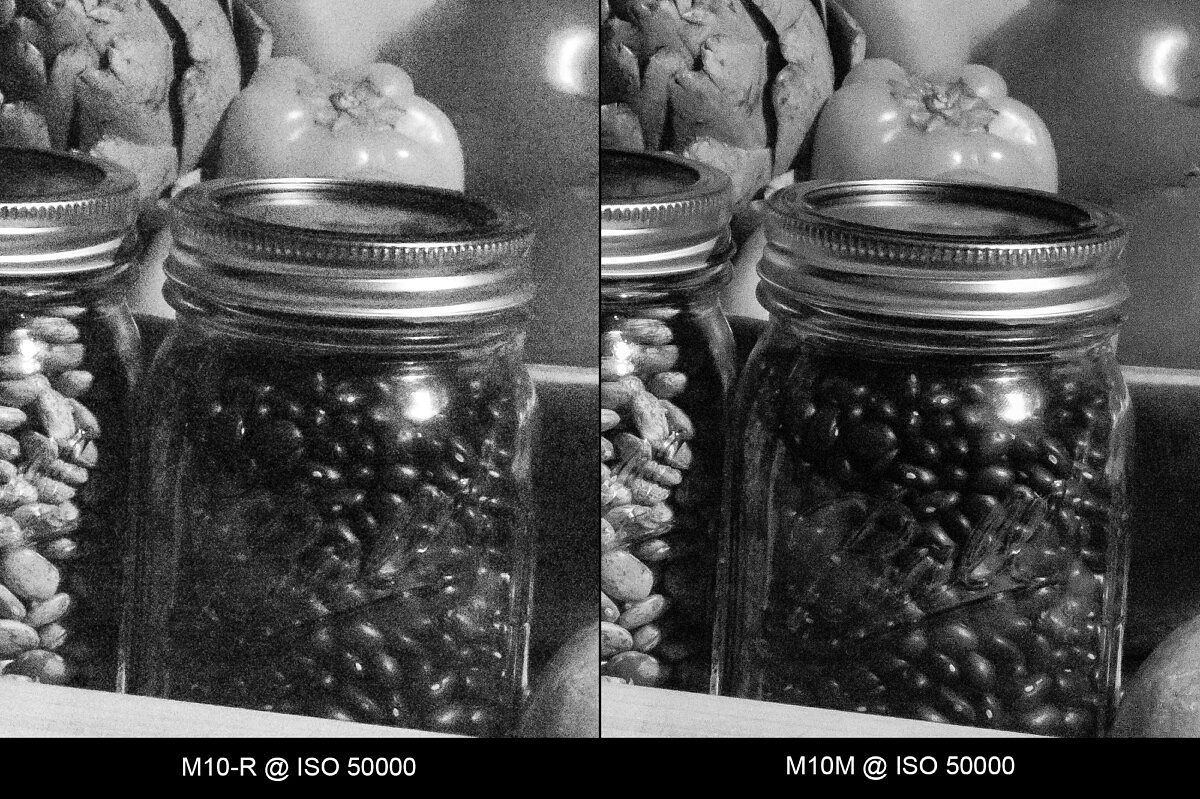
ISO 100000
Just as with the Q2 and Q2M comparisons above, since the M10M extends its ISO range past the M10-R to ISO 100000, I'm showing the respective maximum ISO values here. Unlike the Q2 matchup, I think that the M10 Monochrom at ISO 100000 is merely on par with the M10-R at ISO 50000, not superior. Honestly, neither is fantastic and I'd avoid maxing out either of these cameras.
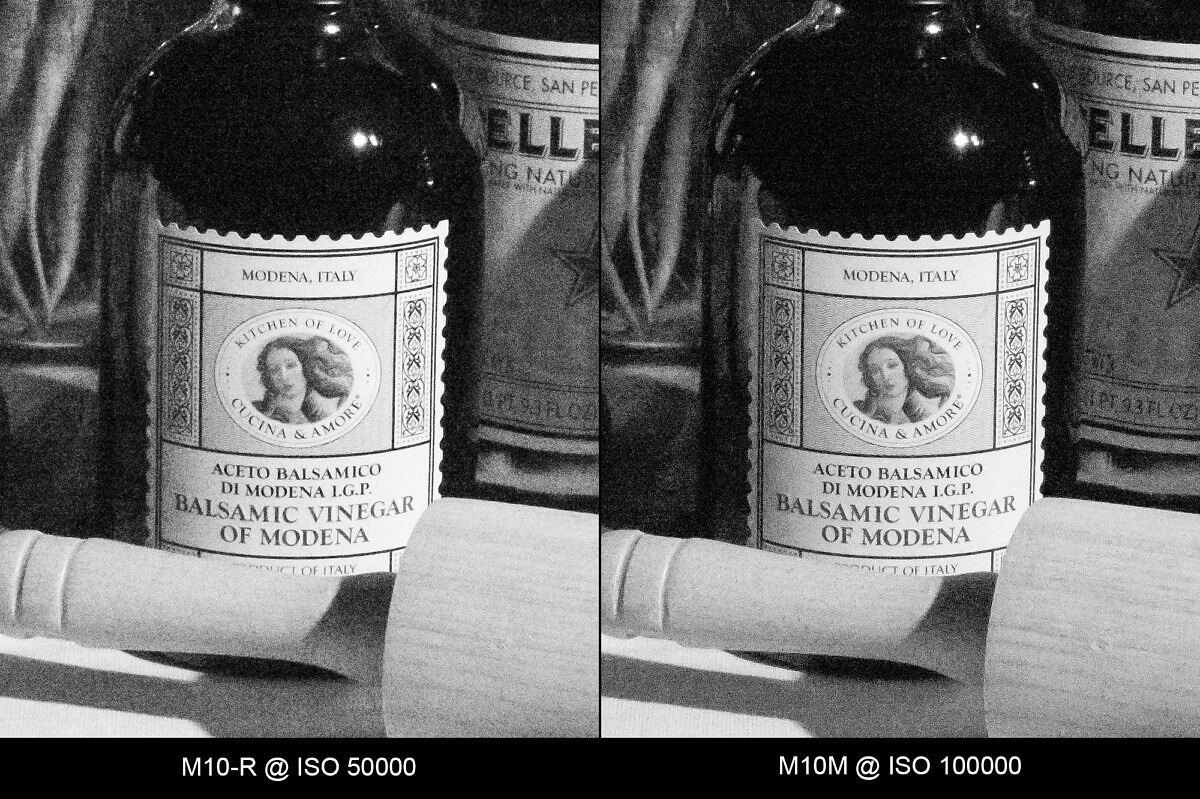
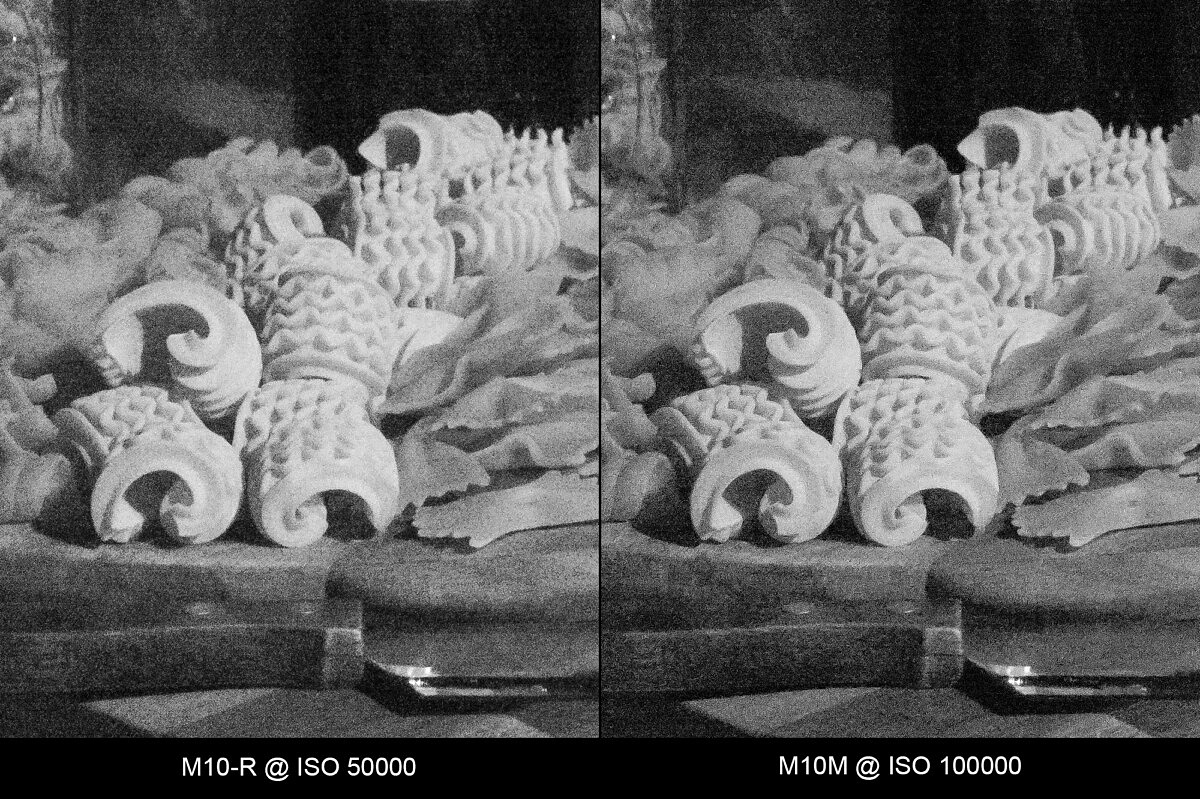
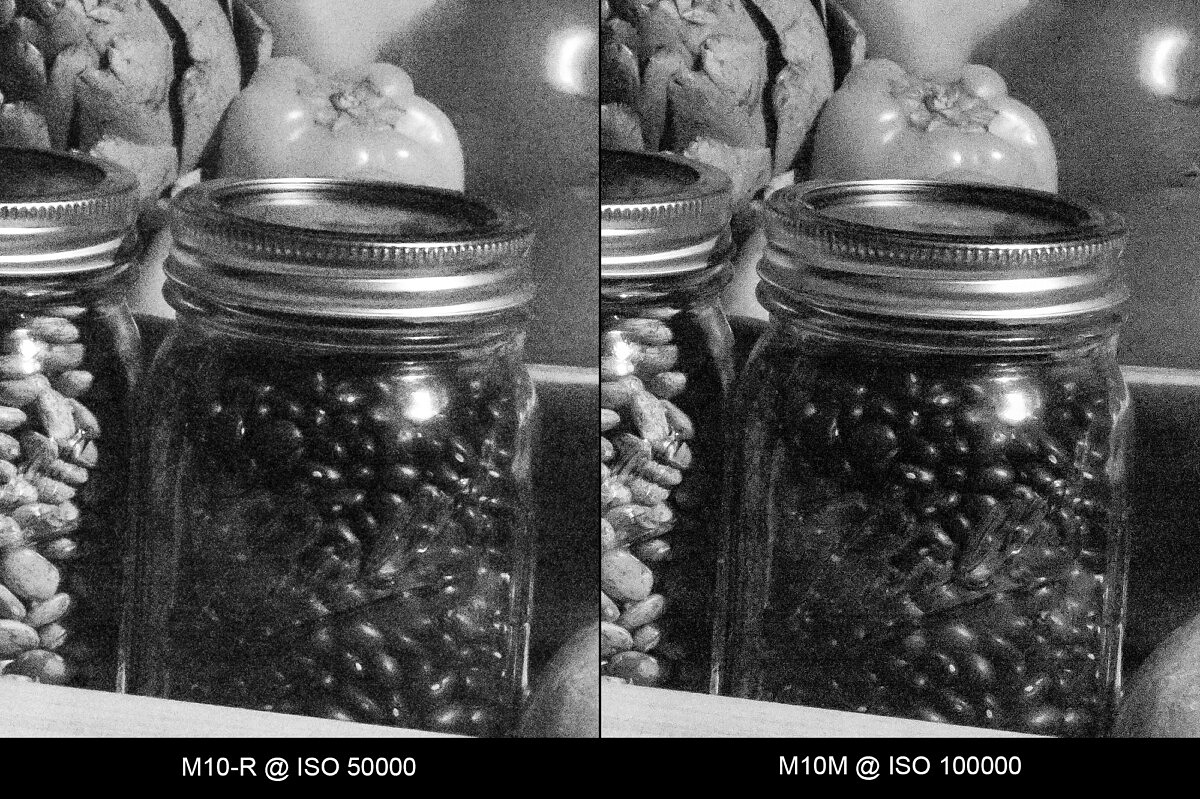
Ideal Maximums
For the ideal maximum ISO matchup on the M10M and M10-R I used the full range of ISO values, not just whole stops. Both cameras allow for 1/3-stop increments in ISO which is good since noise performance doesn't always change linearly. Here, the ideal maximum of the M10M was indeed at one of these settings. Below you can see that the M10 Monochrom at ISO 32000 matches up nicely with the M10-R at ISO 12500, resulting in a 1 and 1/3-stop improvement in low light ability in favor of the B&W camera. This difference is significant but isn't as sizeable as the 2-stops between the Q2M and Q2.
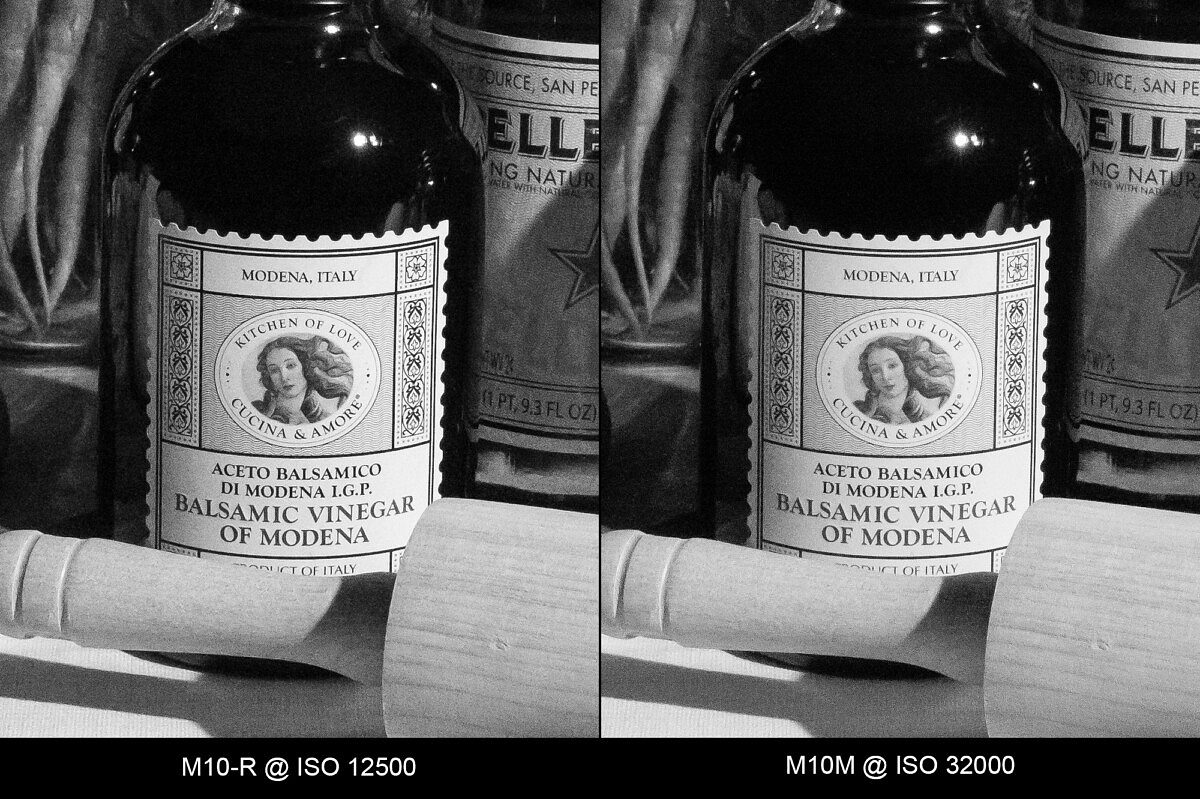
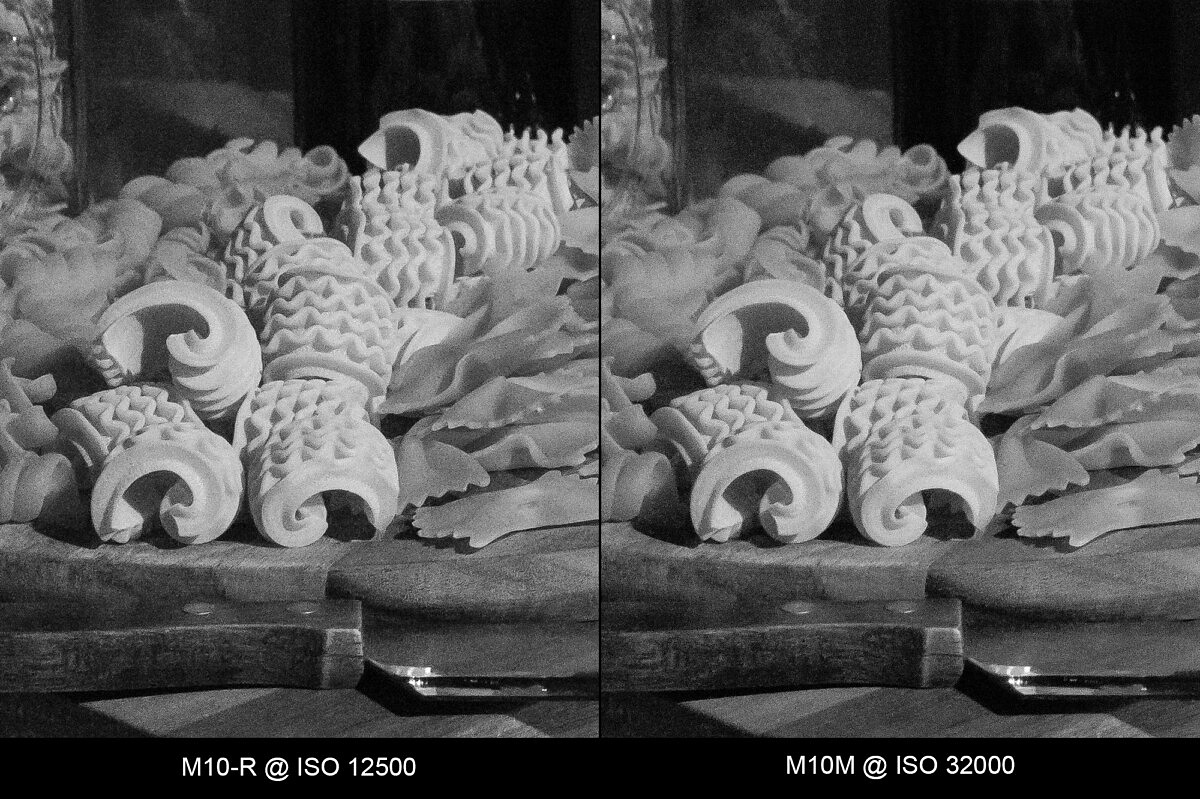
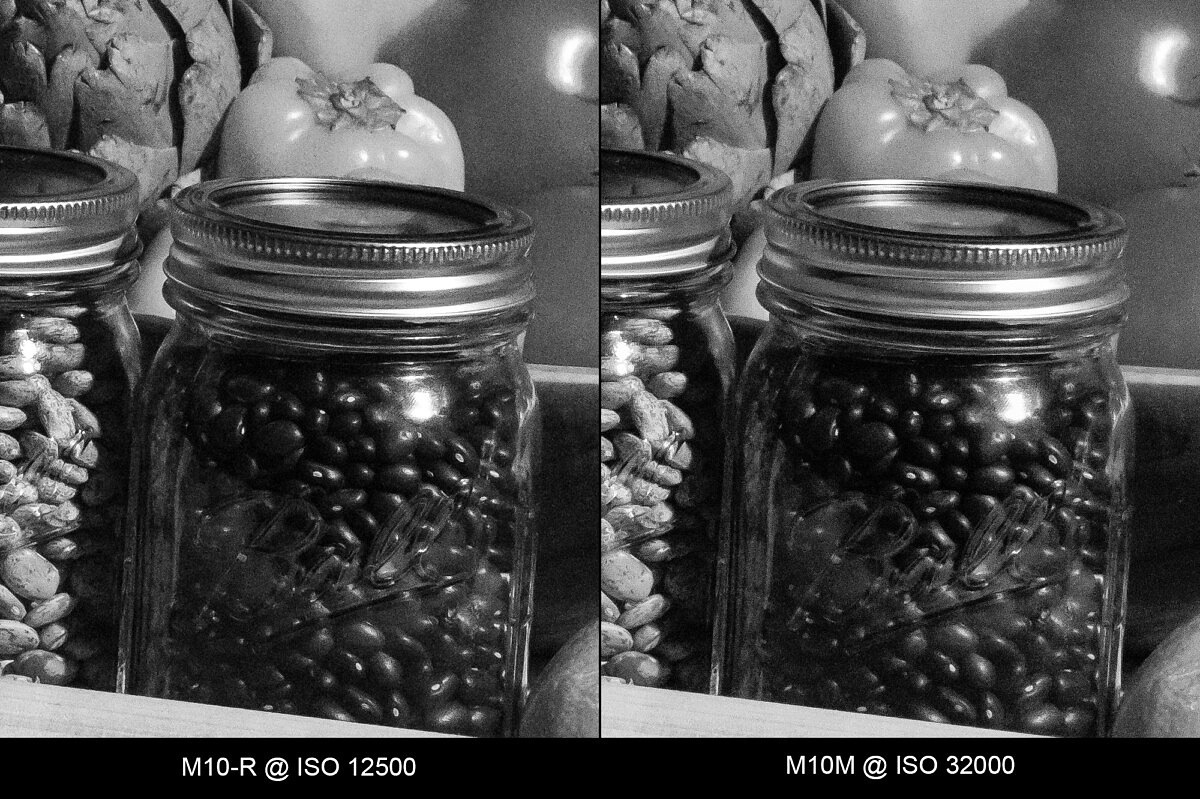
Q2 Monochrom vs M10 Monochrom
Now that we've seen how each Monochrom version matches up to its color counterpart, it's time to put both B&W heavyweights into the ring for a final face off. Will the M10 Monochrom retain its title as low light champ, or does the new Q2 Monochrom have what it takes to take the crown? Okay, if you've gotten this far, you already know the max performance values for each, but we have to keep the Battle Royal theme going here.
ISO 100 / 160
Obviously, both Monochrom cameras turn out insane image quality at low ISO. For the uninitiated, I've often equated low ISO Monochrom images to those from a large format negative. Except here, on both, this quality level continues all the way up to ISO 6400.
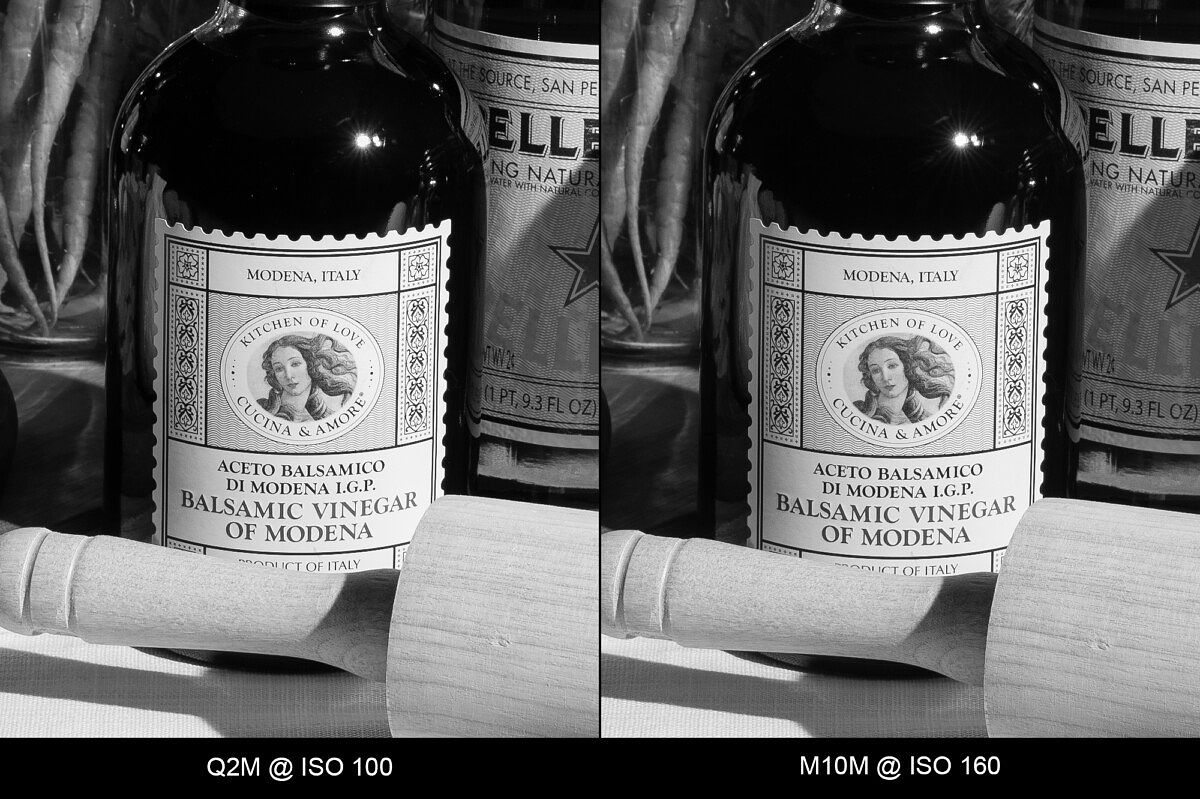
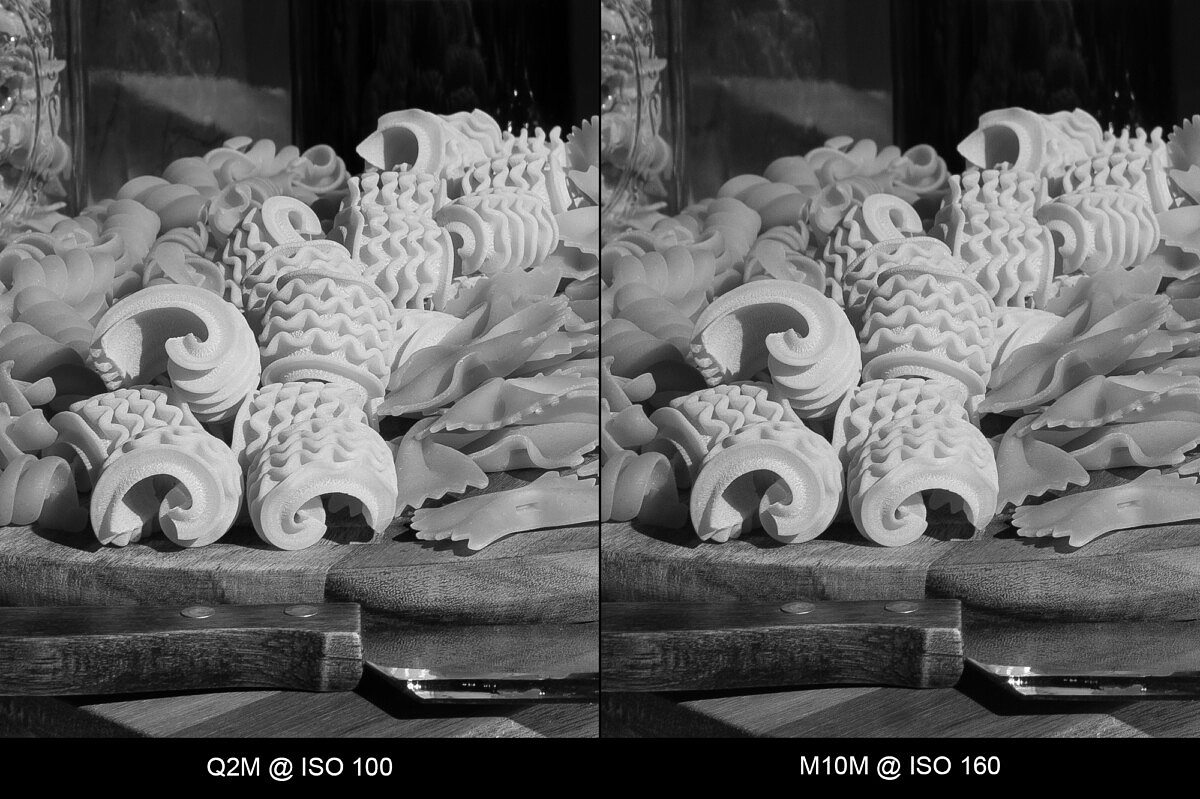
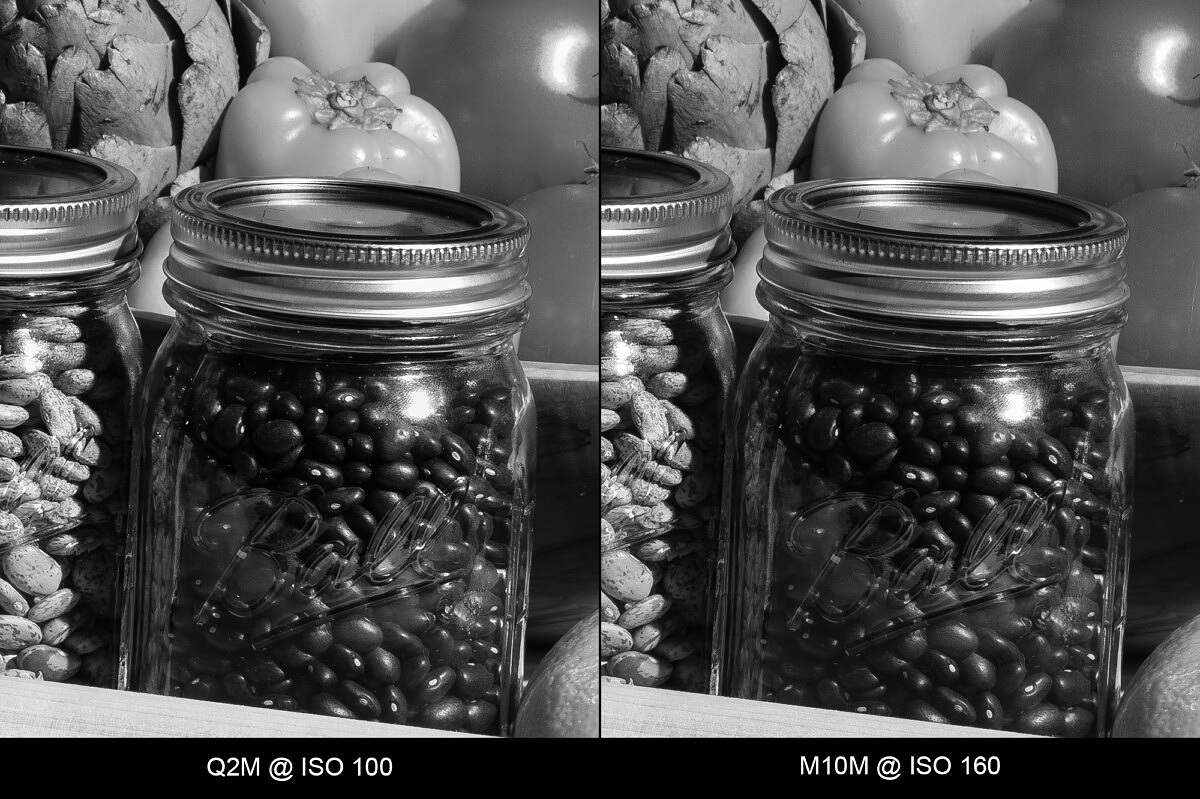
ISO 200
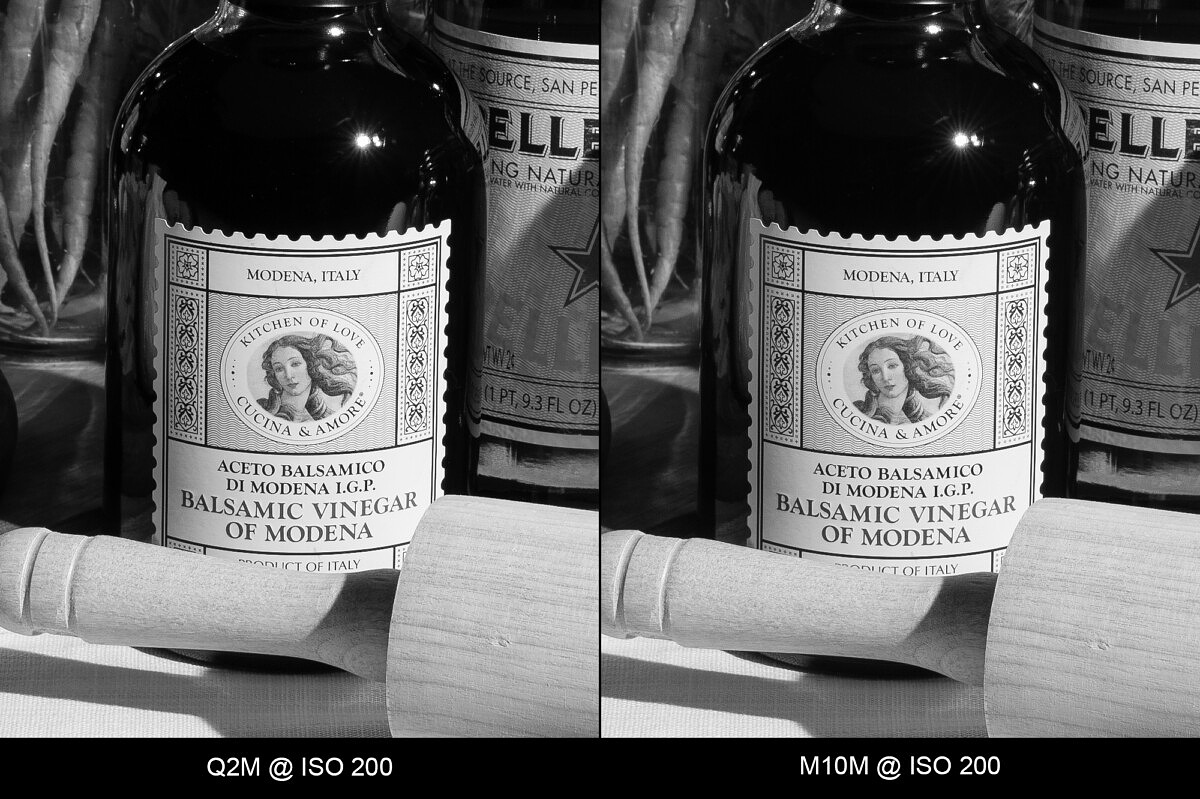
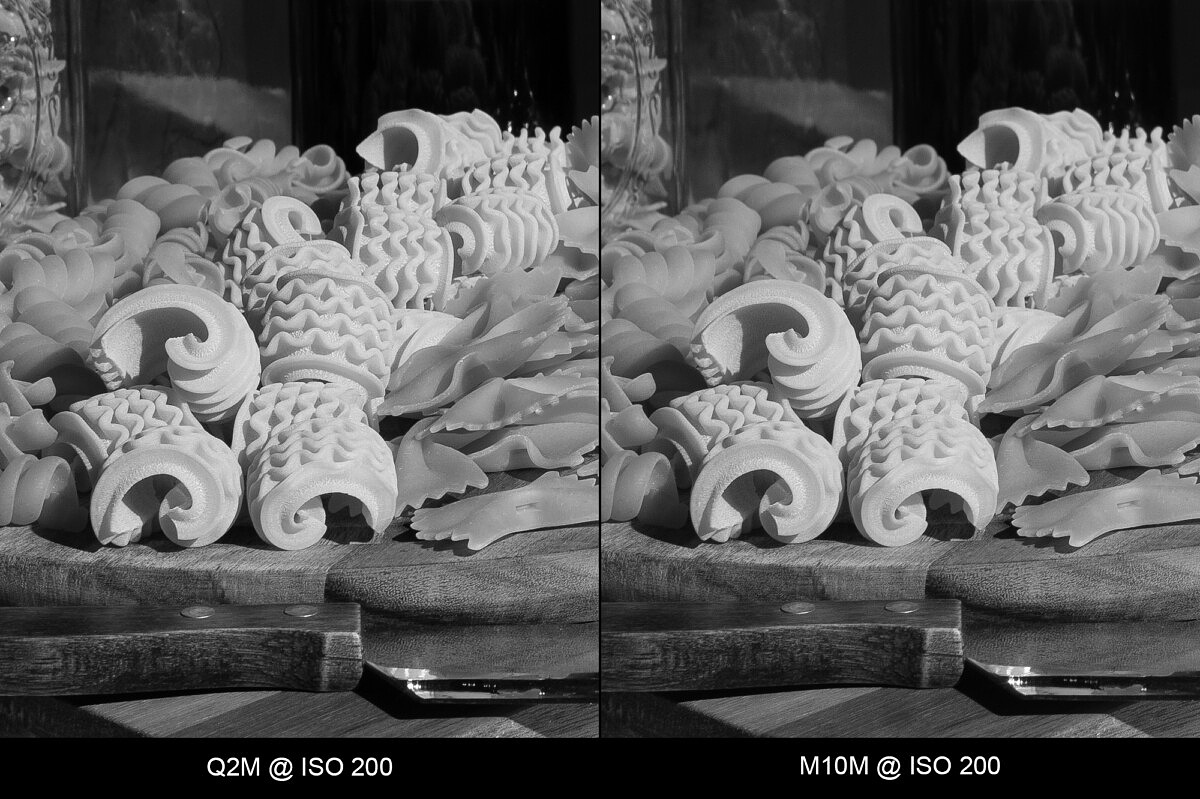
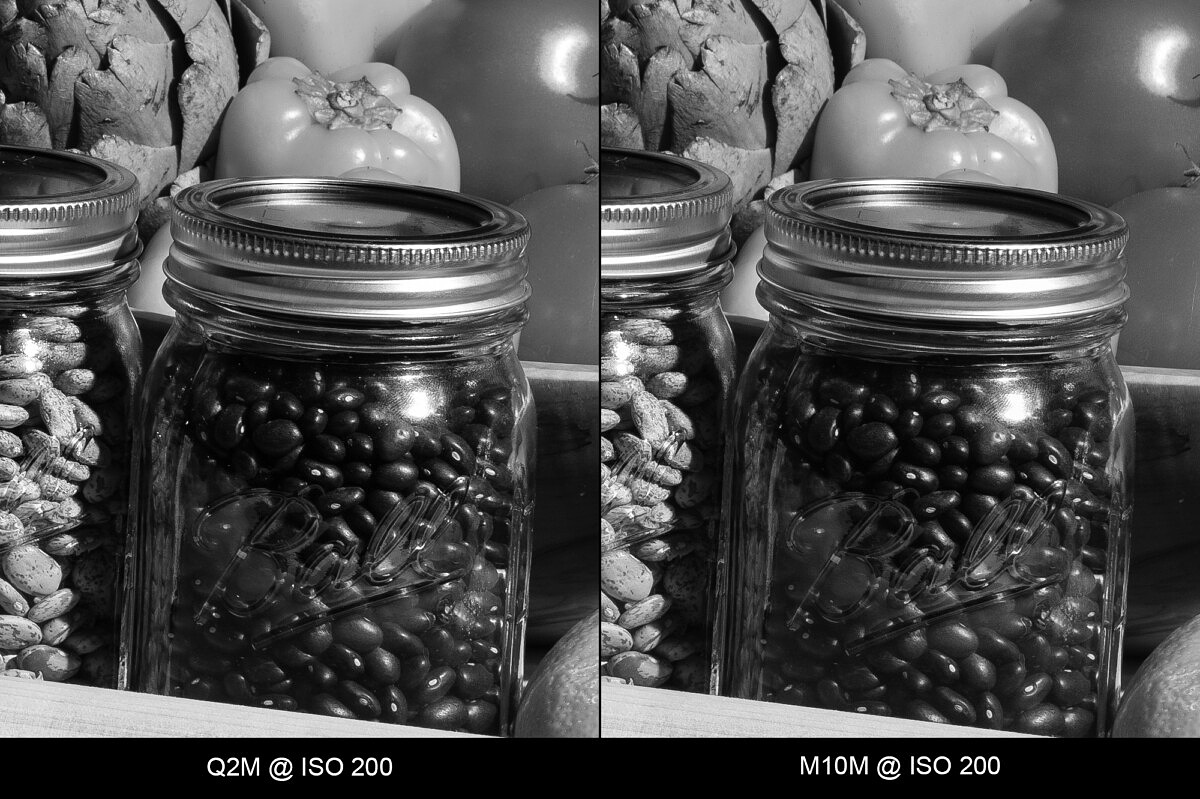
ISO 400
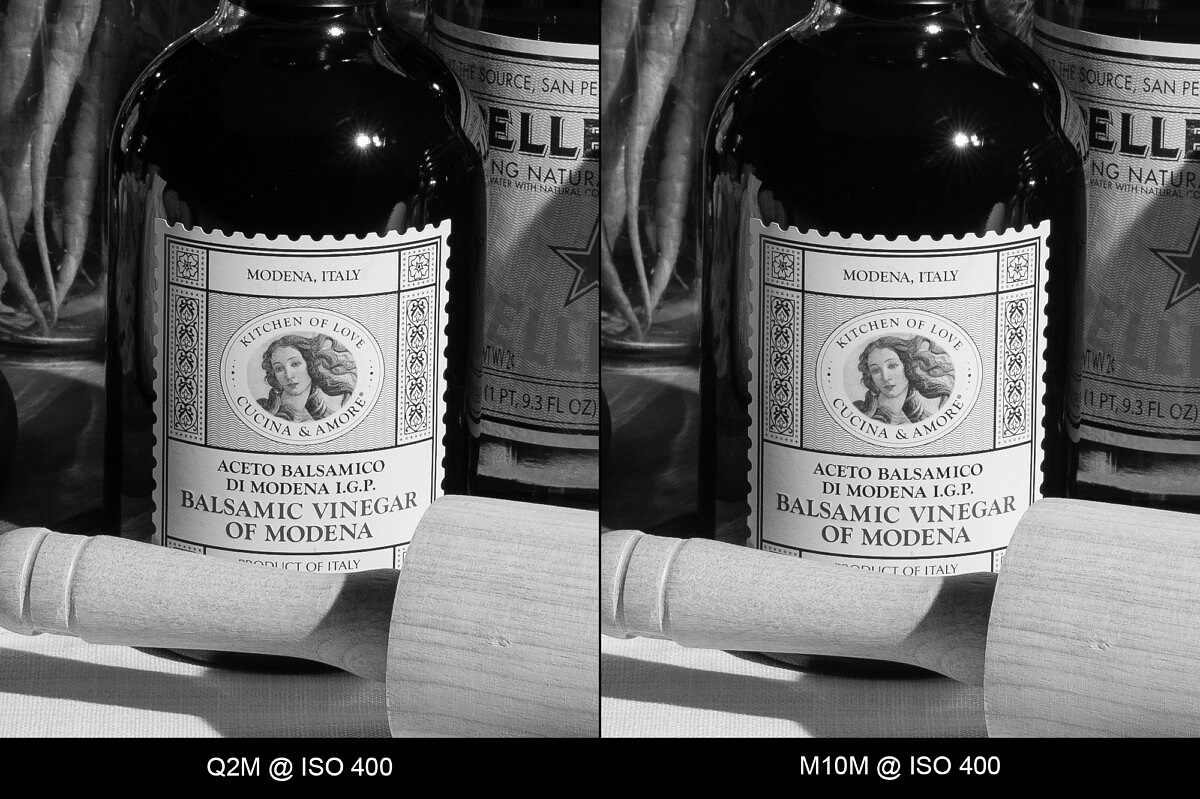
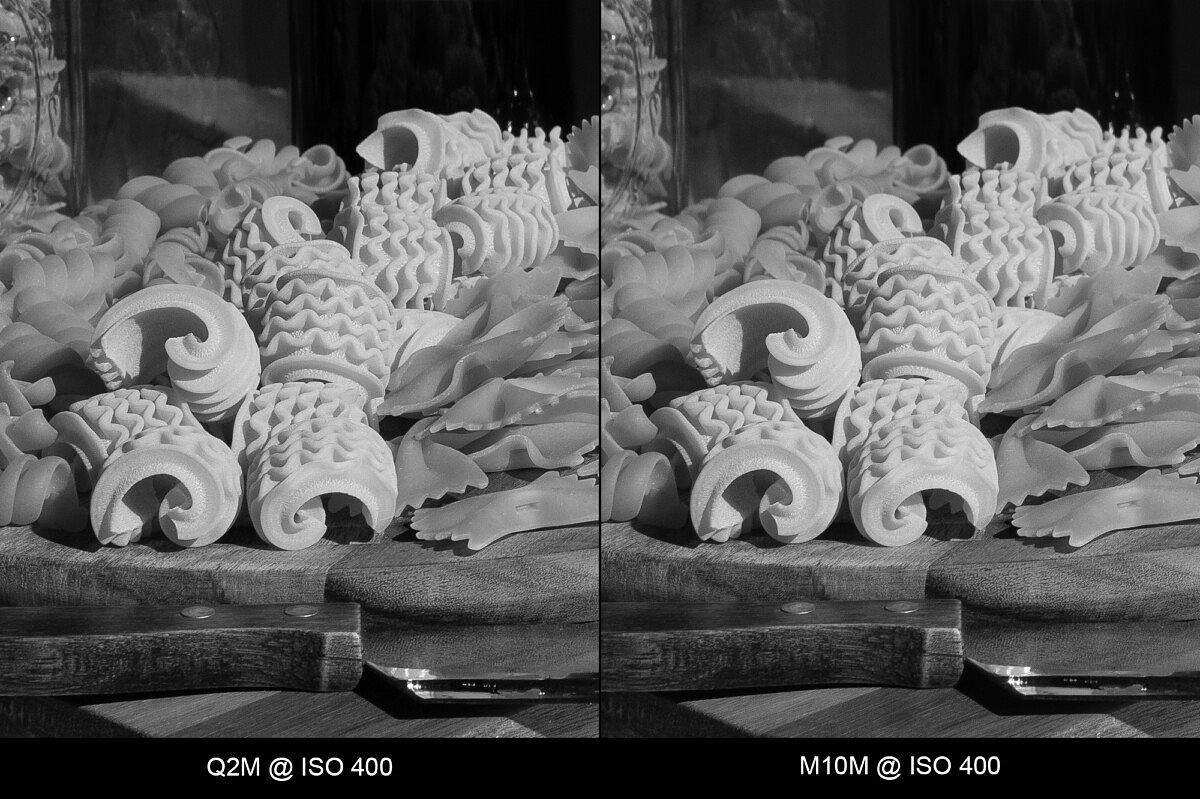
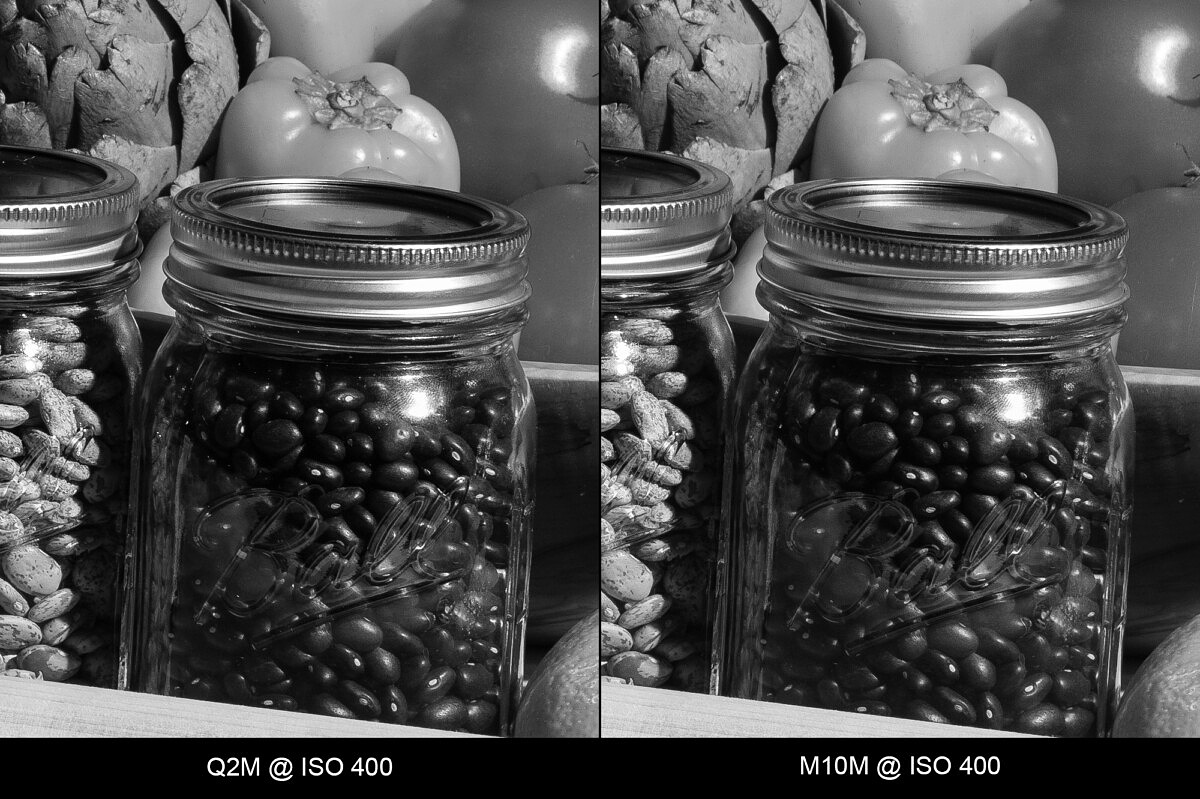
ISO 800
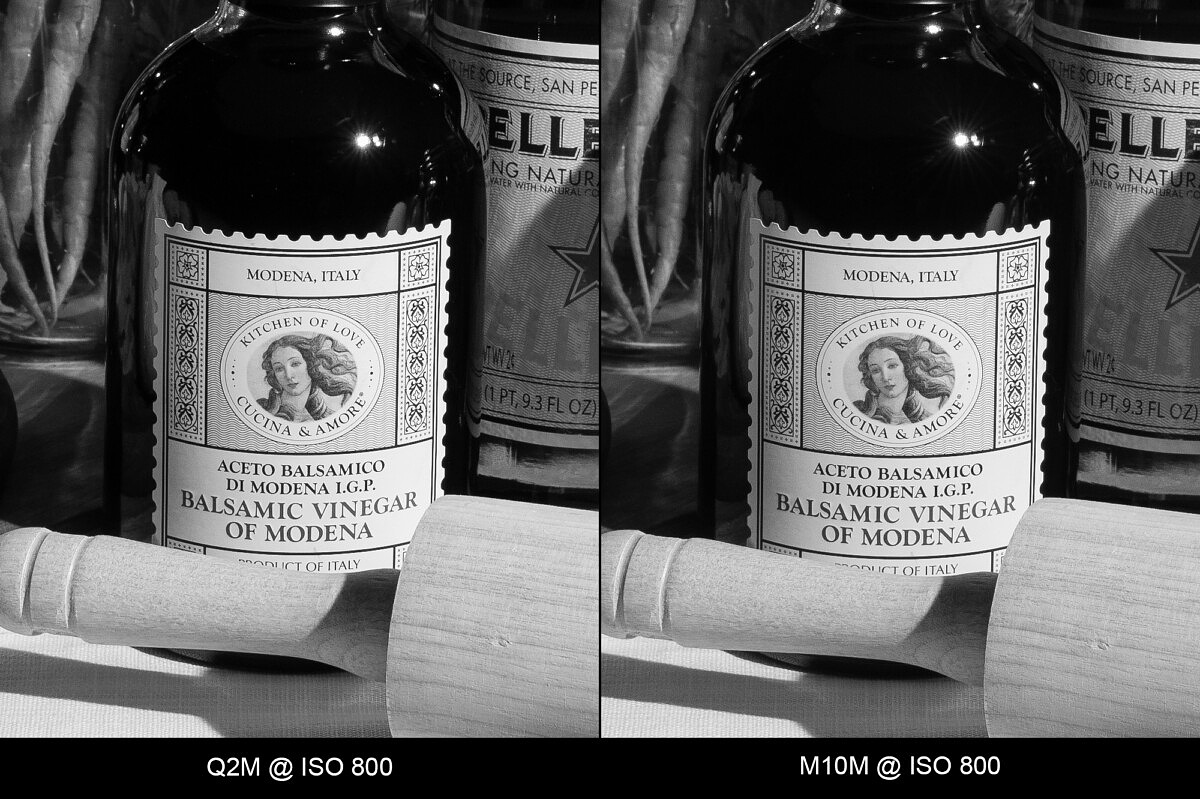
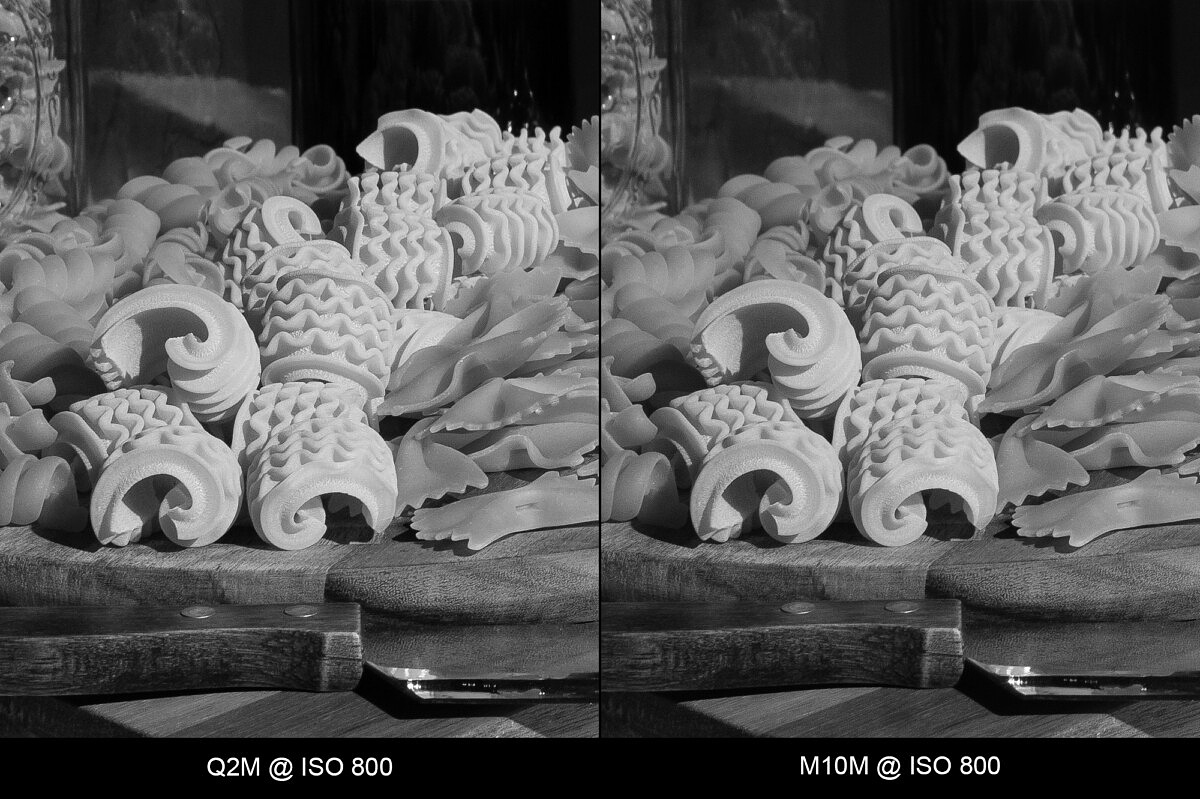
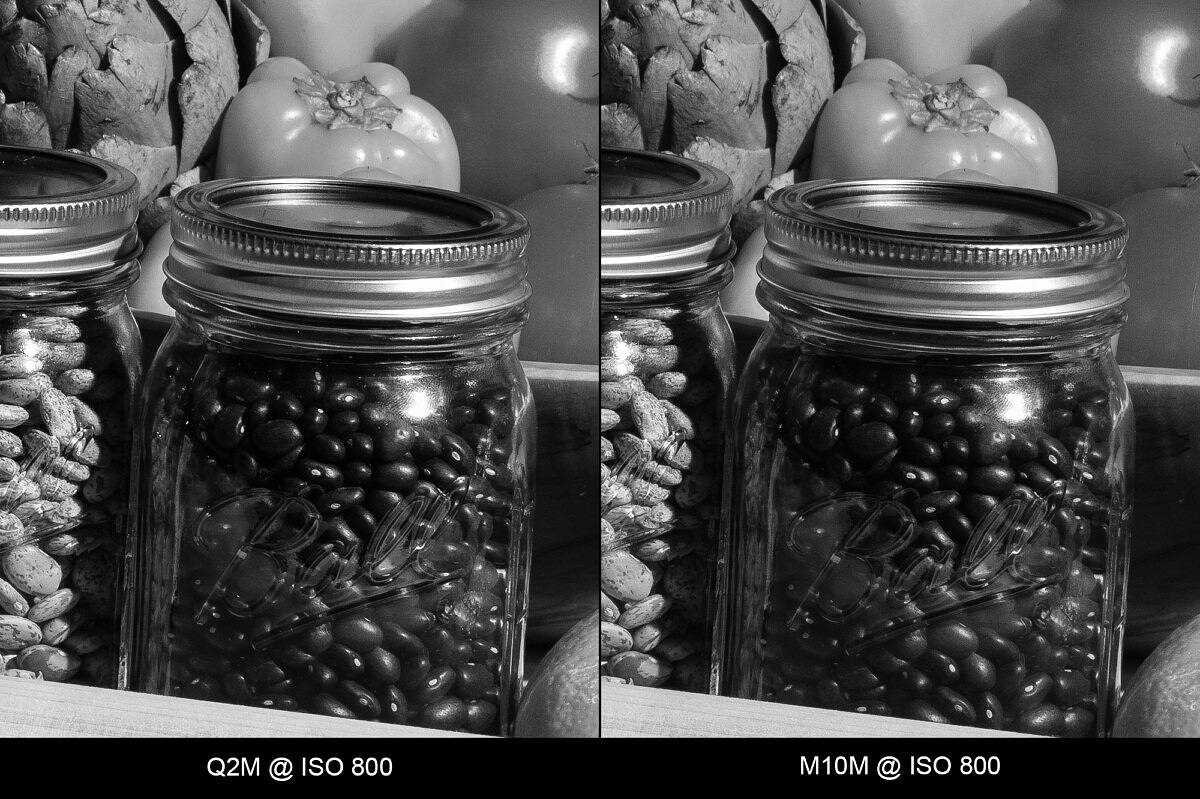
ISO 1600
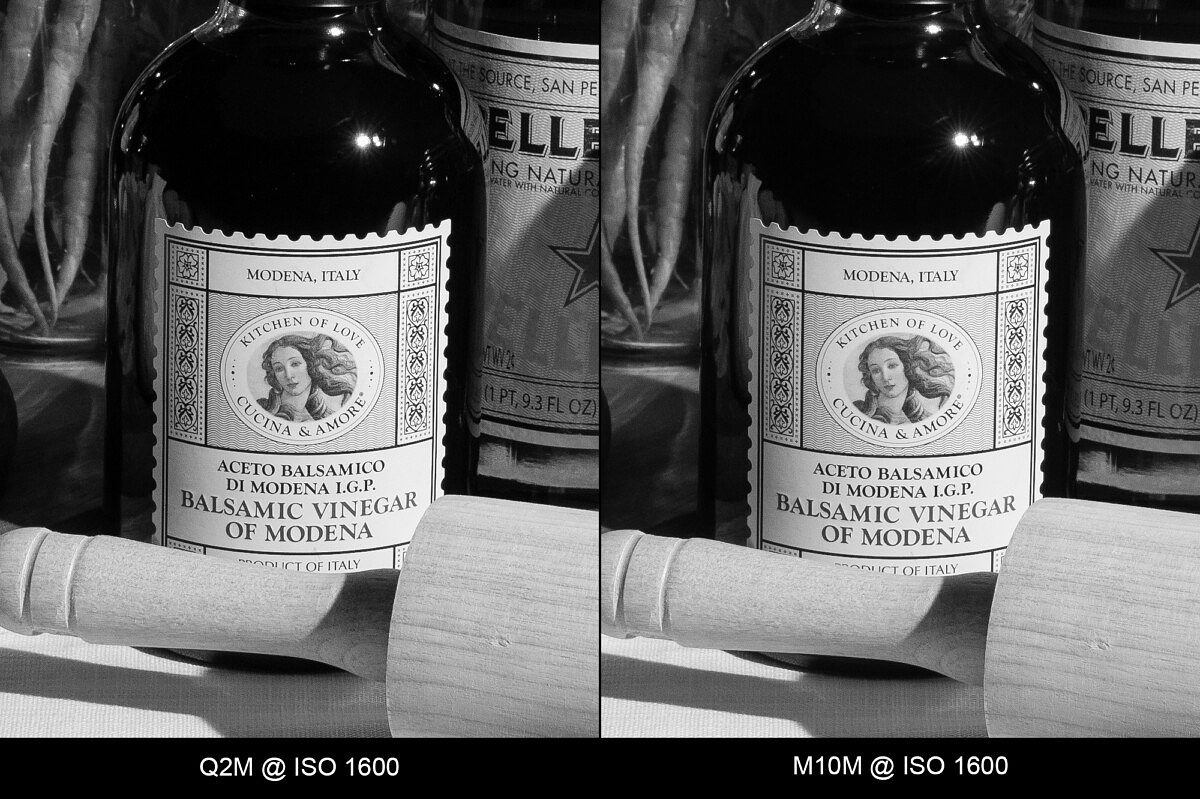
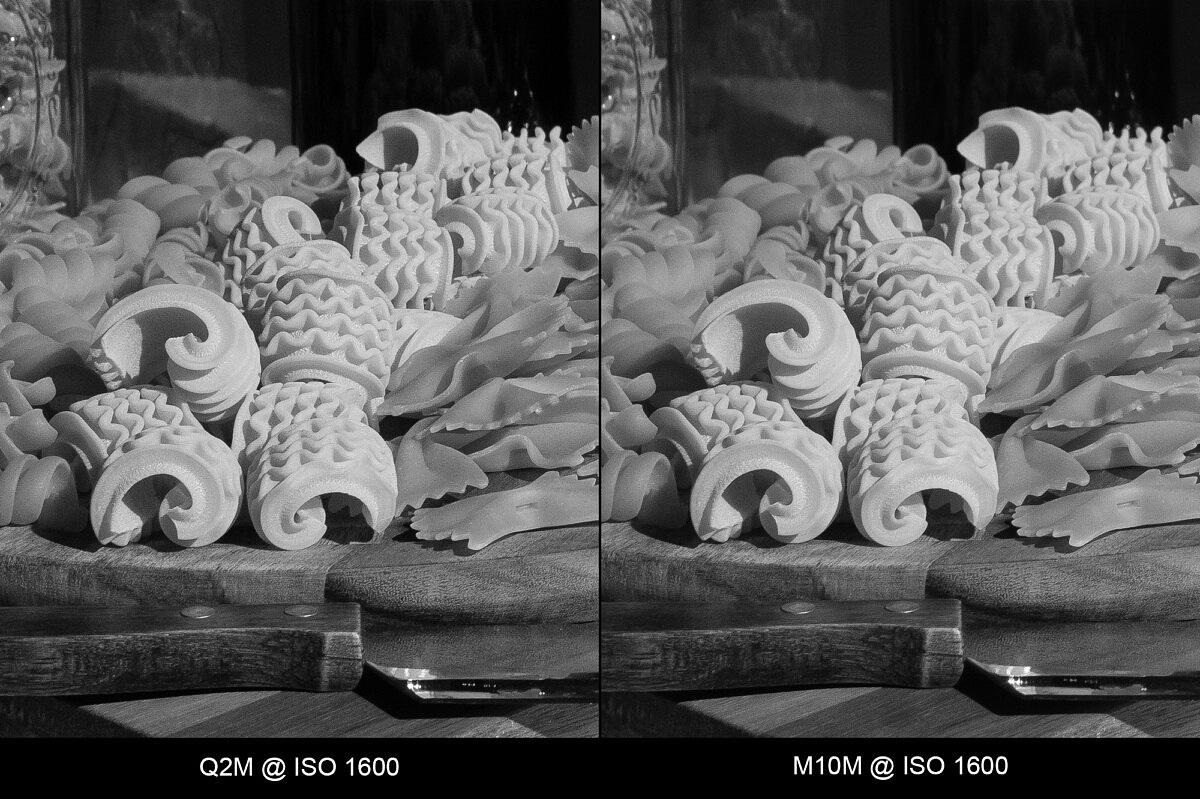
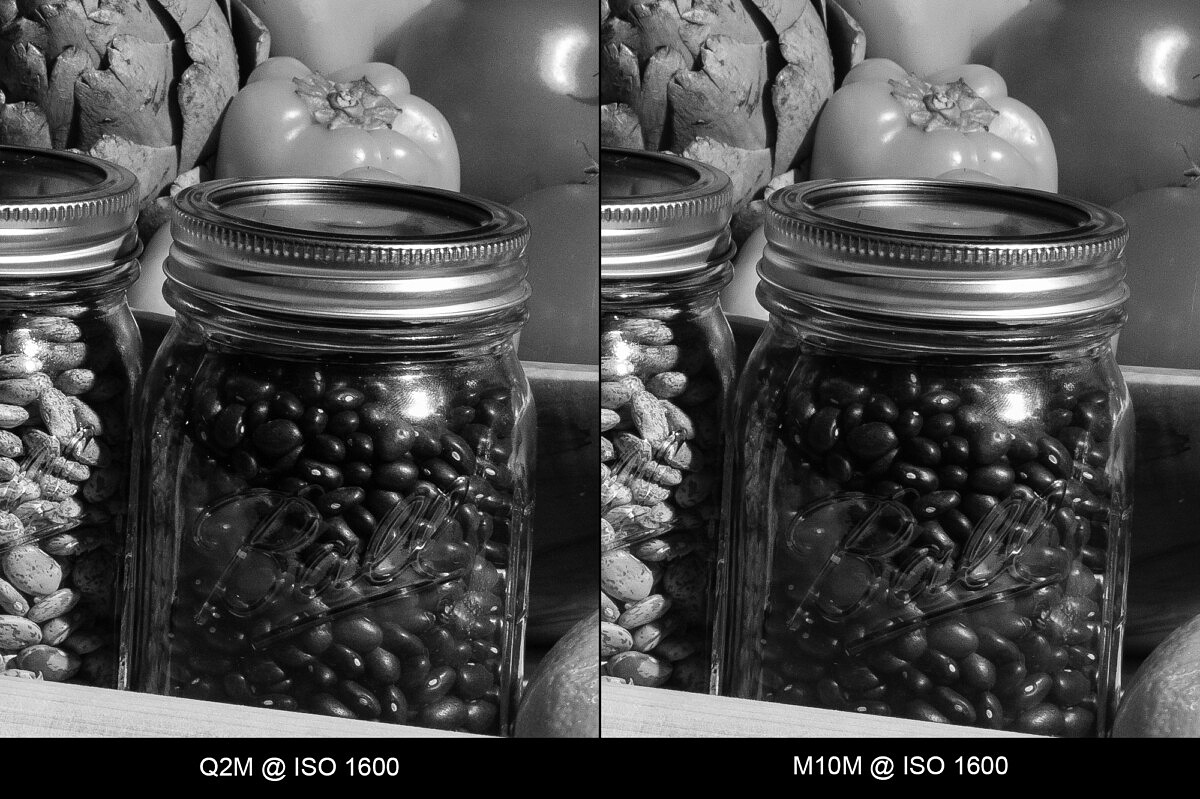
ISO 3200
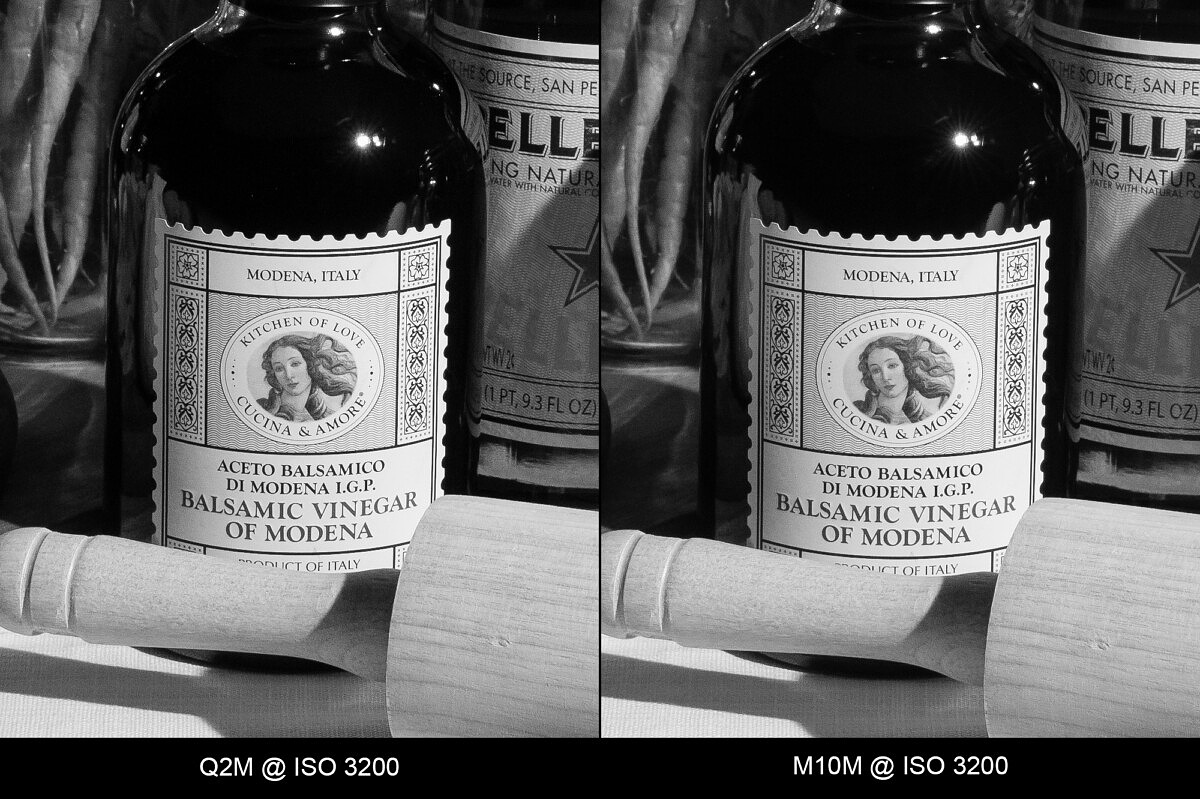
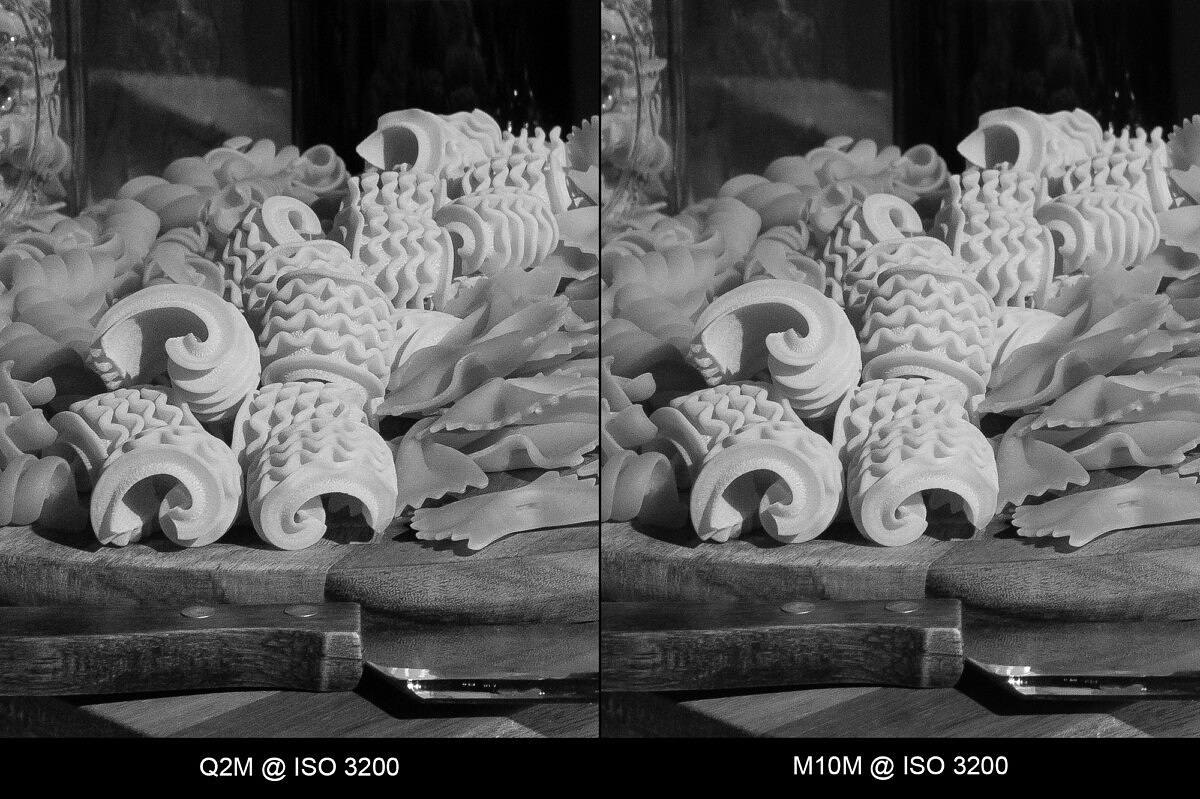
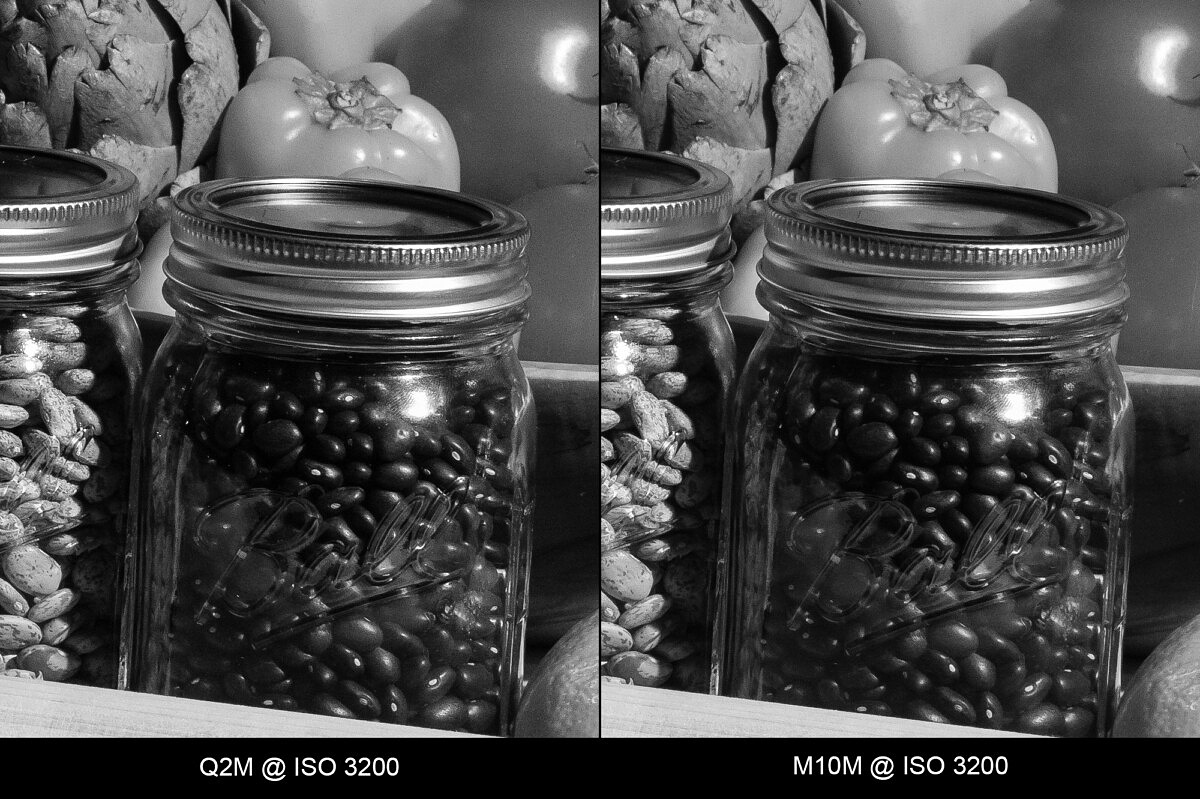
ISO 6400
Finally, at ISO 6400 we're seeing a smidgen of noise in both the Q2M and M10M, but nothing significant. Both are turning out incredible image quality here.
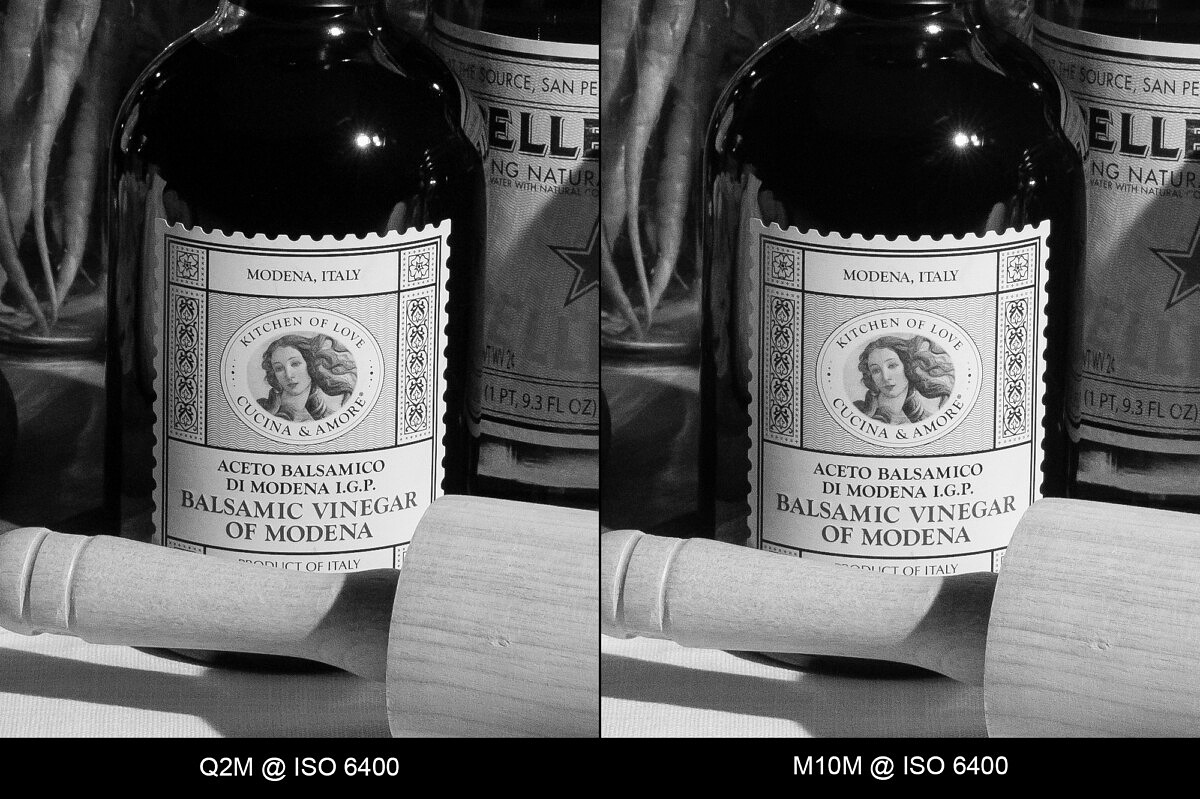
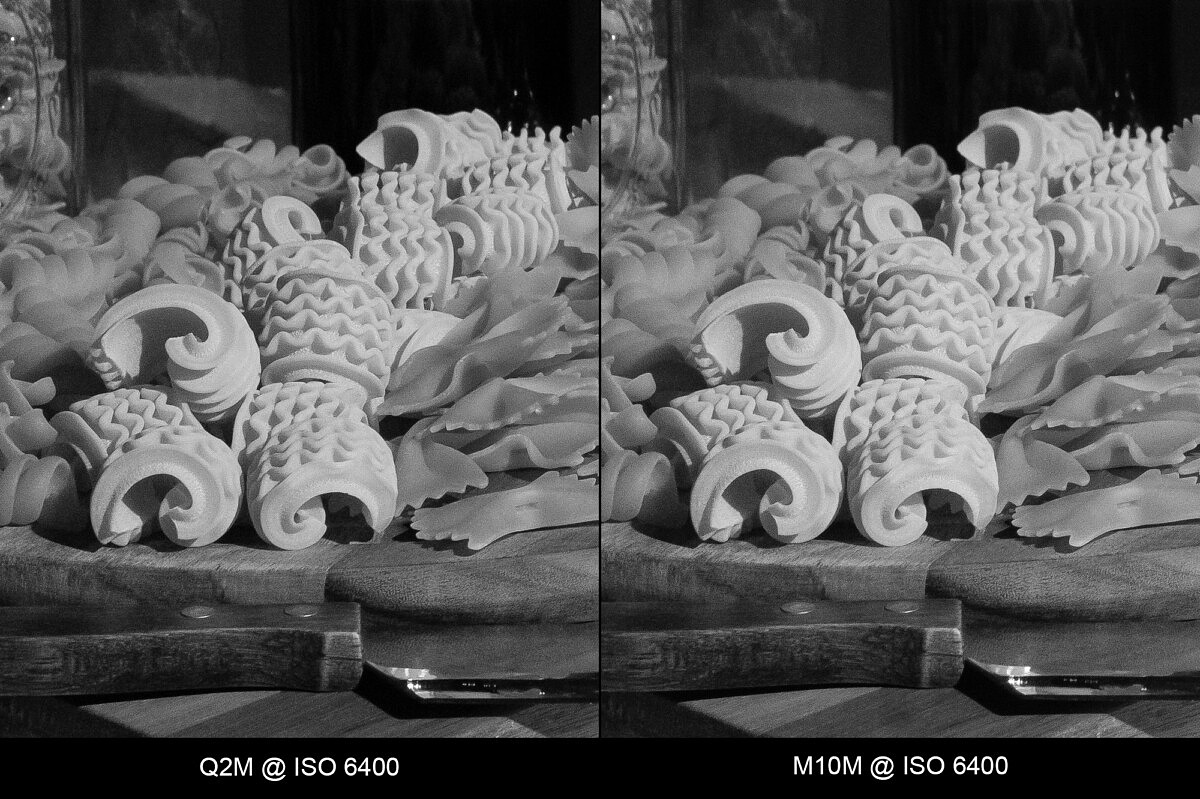
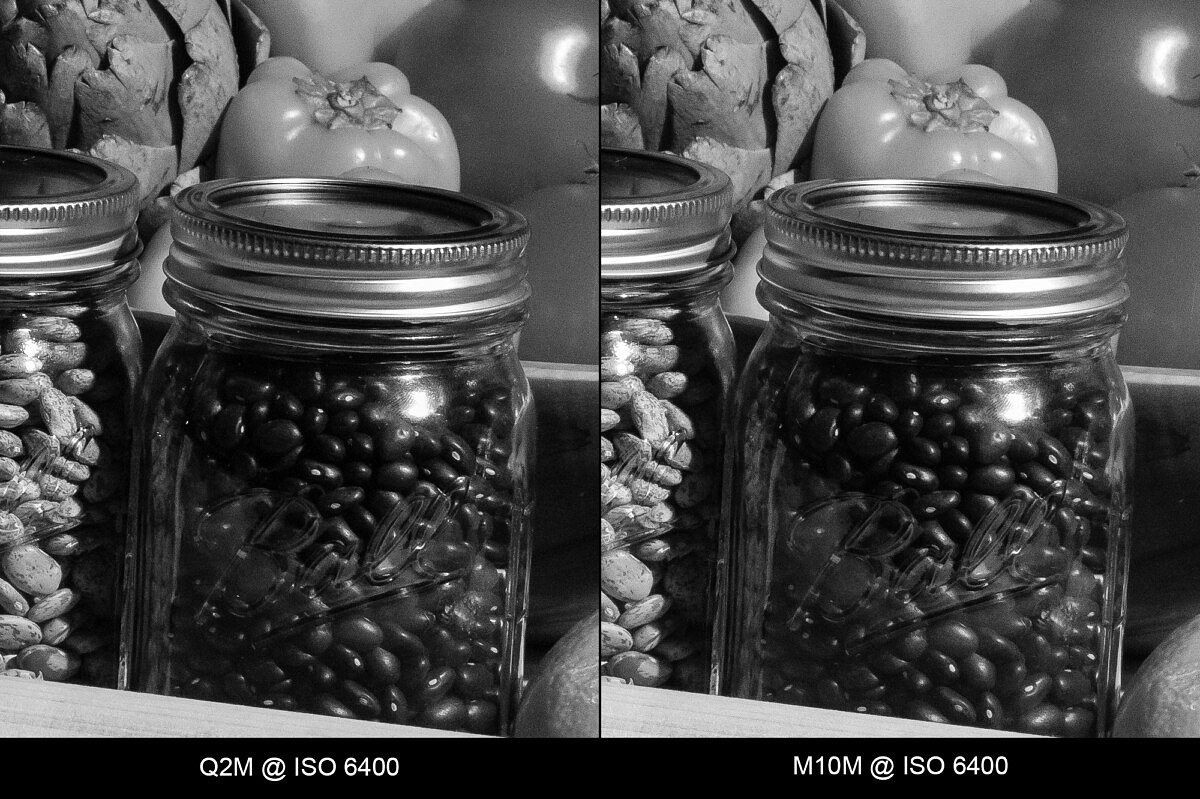
ISO 12500
Both Monochrom cameras continue to trade blows here at ISO 12500. Noise increases slightly for both the Q2M and M10M, but there is no clear winner. Again, great results all around and both are besting the previous generation Monochrom cameras.
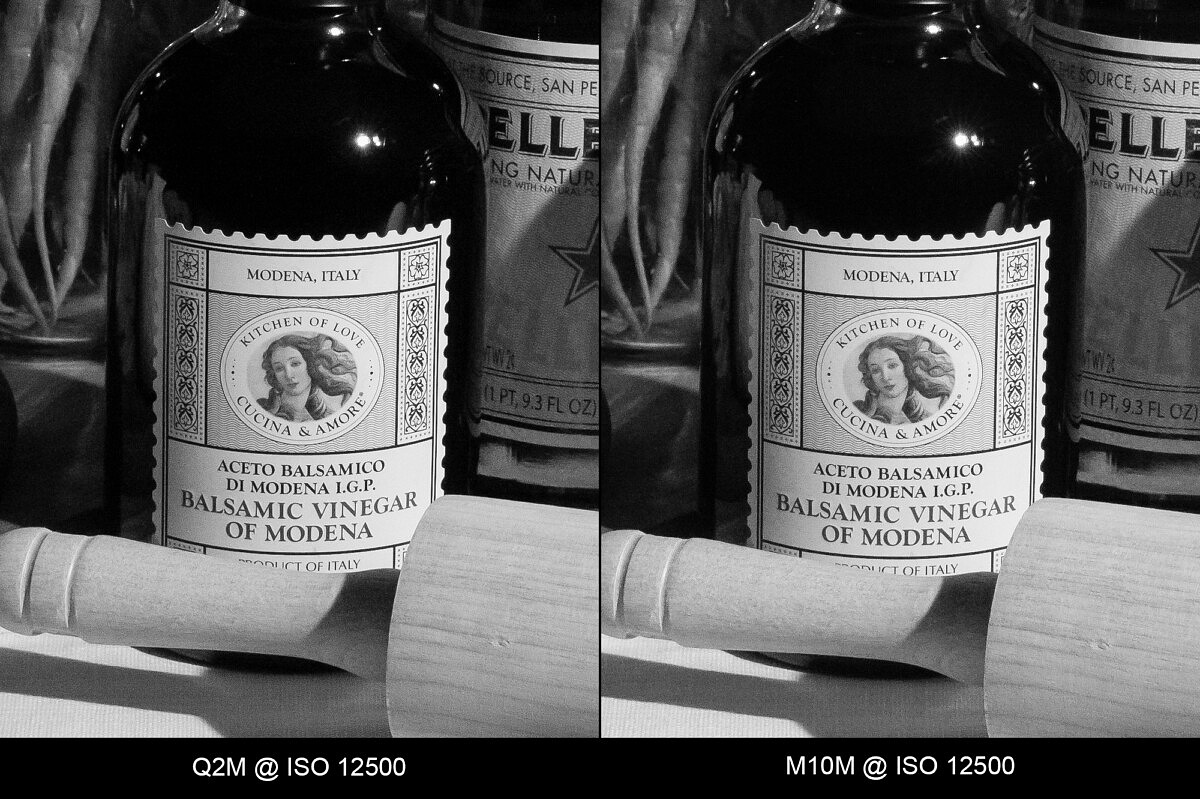
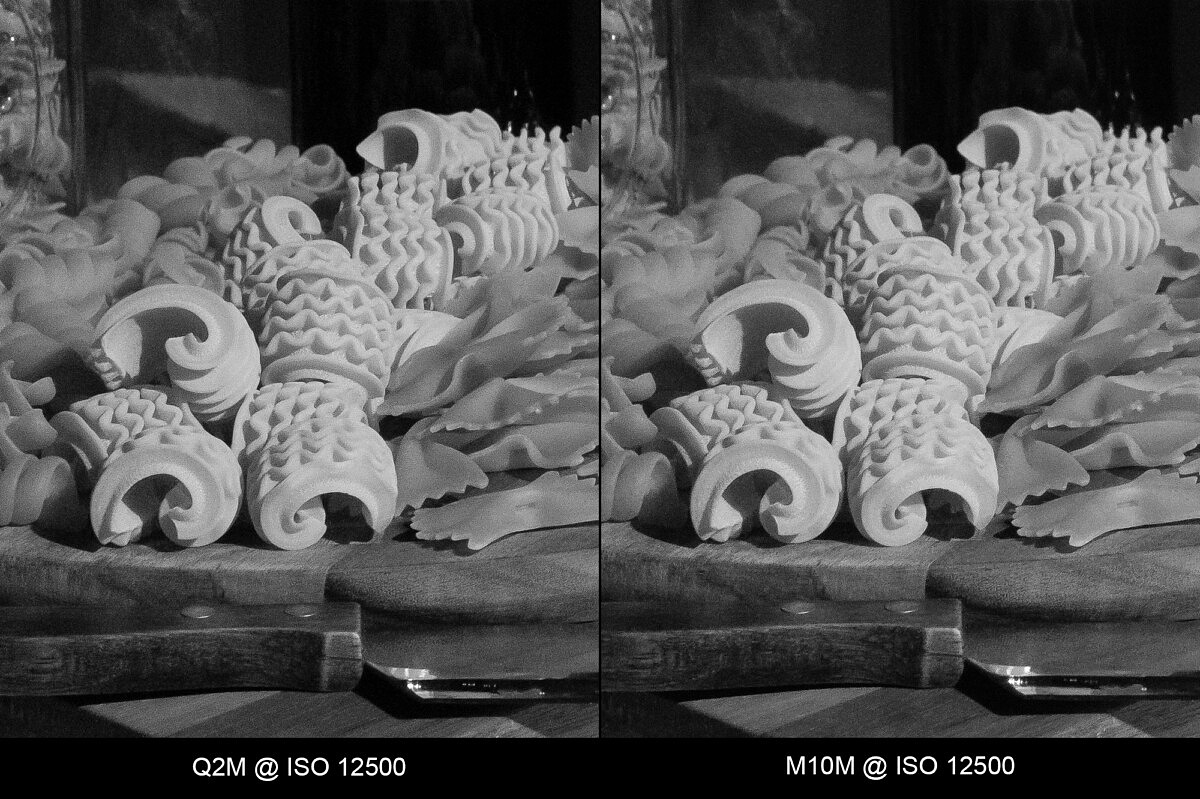
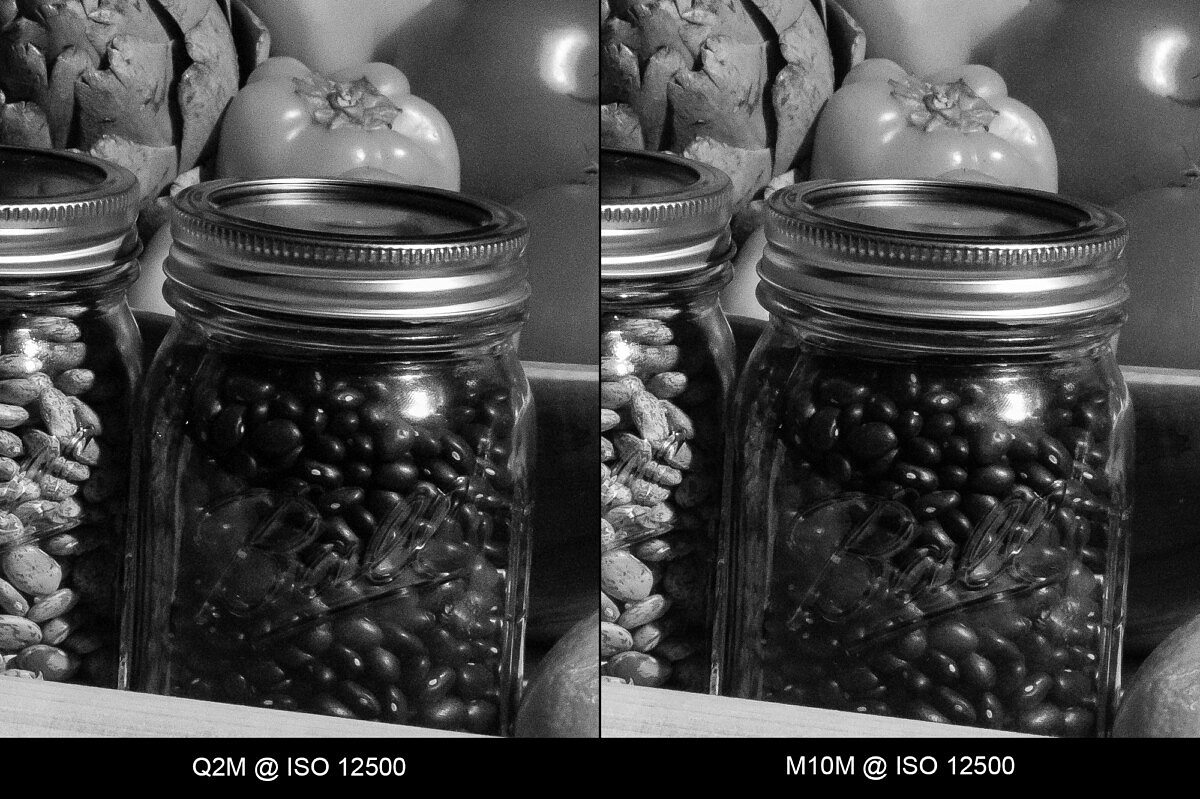
ISO 25000
We're seeing a similar story at ISO 25000, but the M10M seems to be starting to pull ahead of the Q2M. Just barely though. The results are so close.
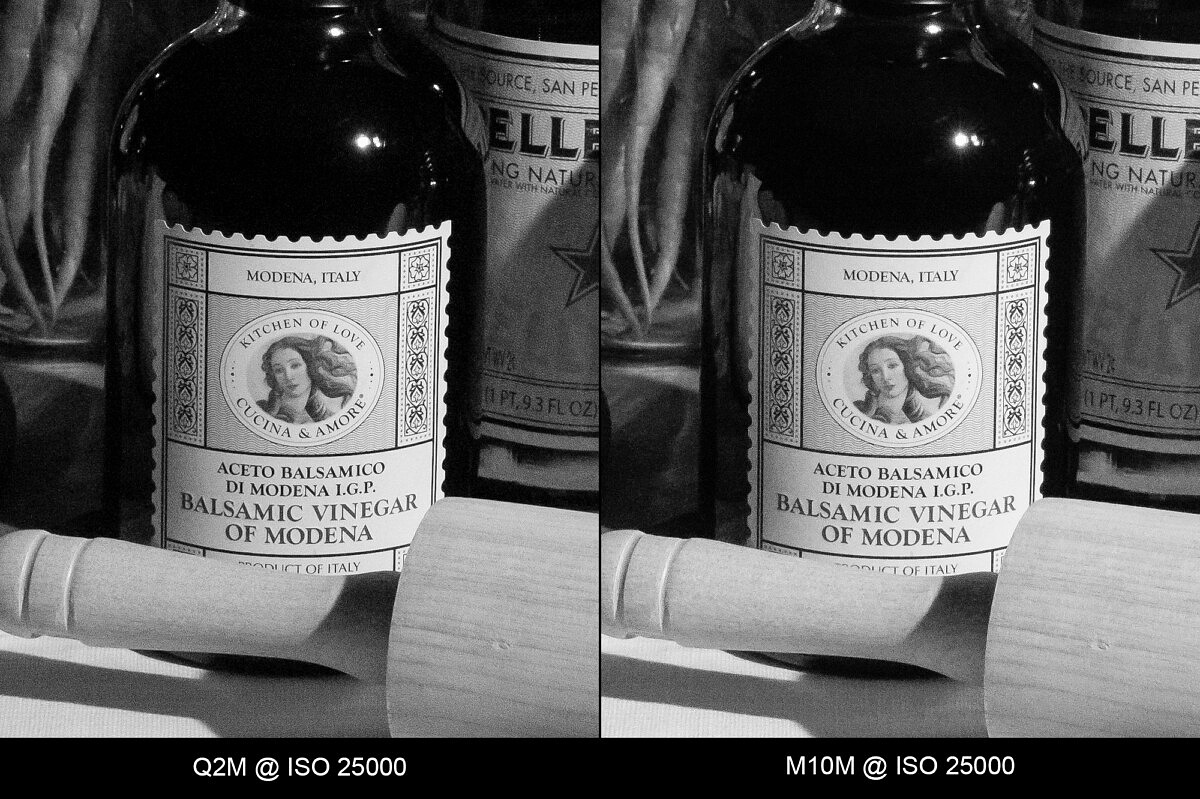
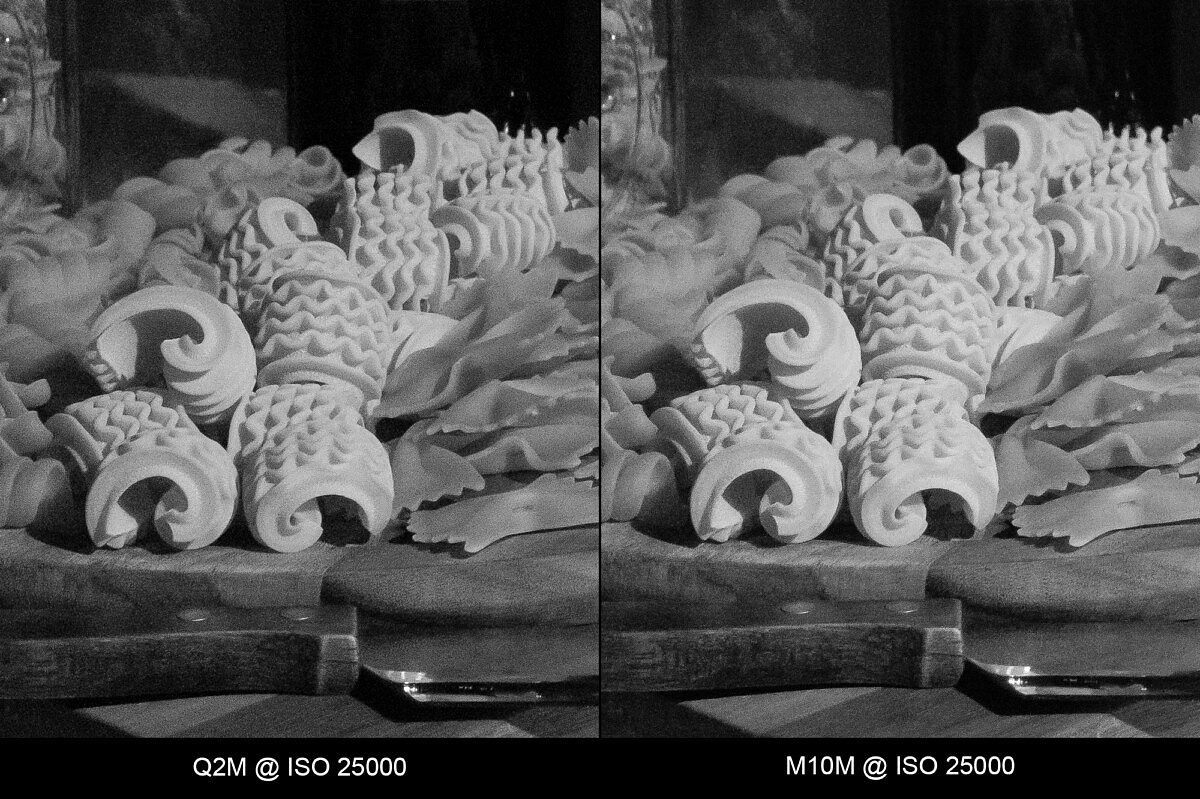
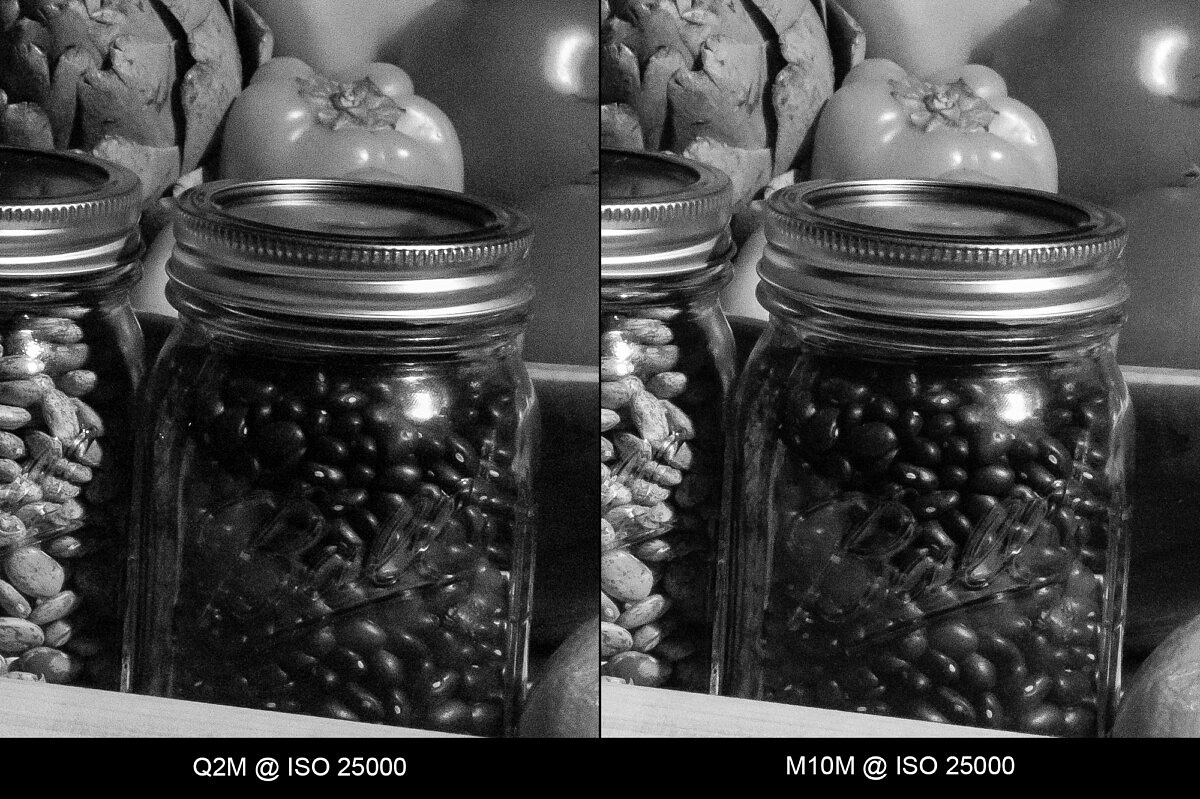
ISO 50000
The grudge match continues at ISO 50000, as the Q2 Monochrom now inches out the M10M. Again, just barely. But this is really getting interesting.
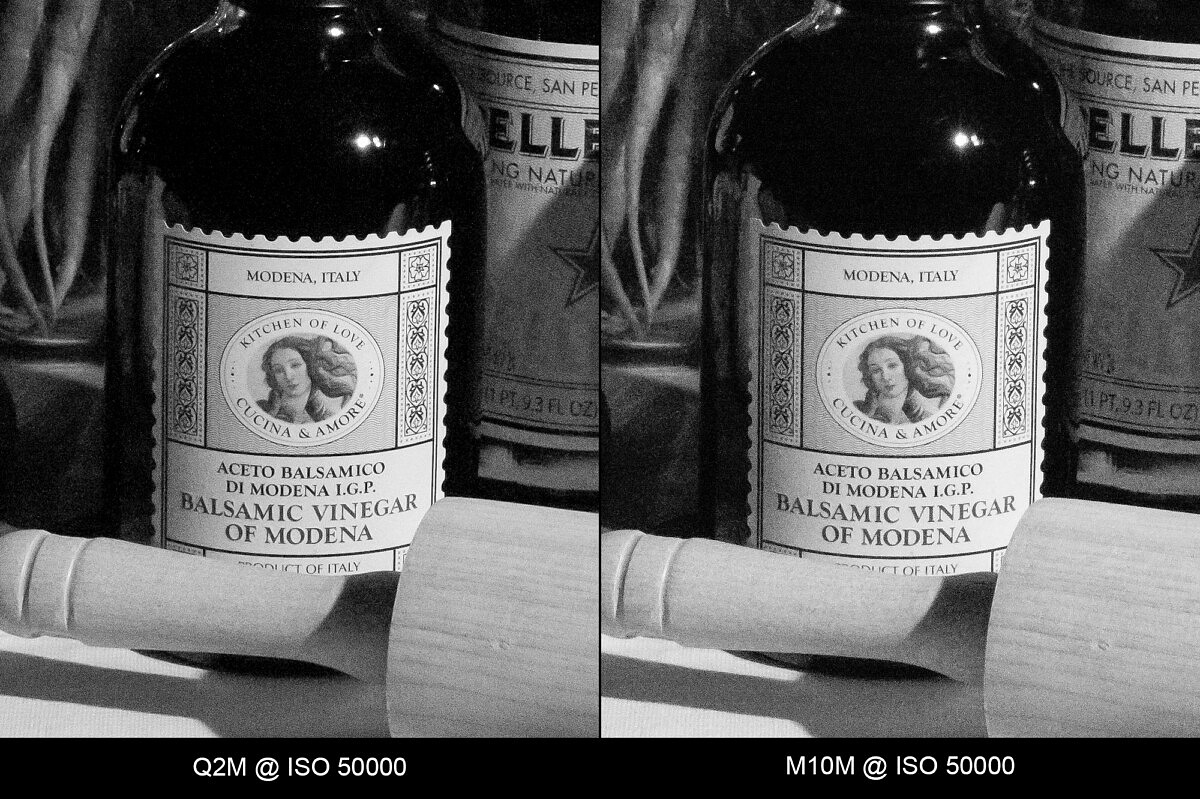
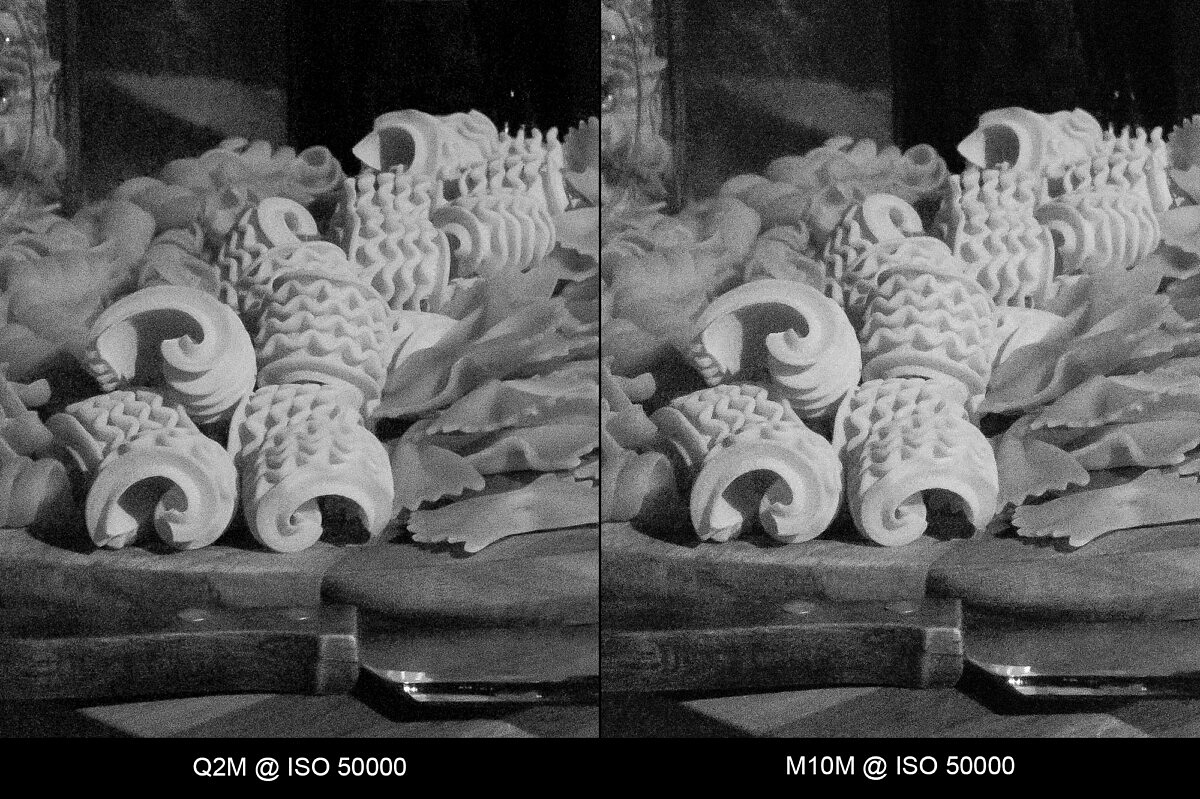
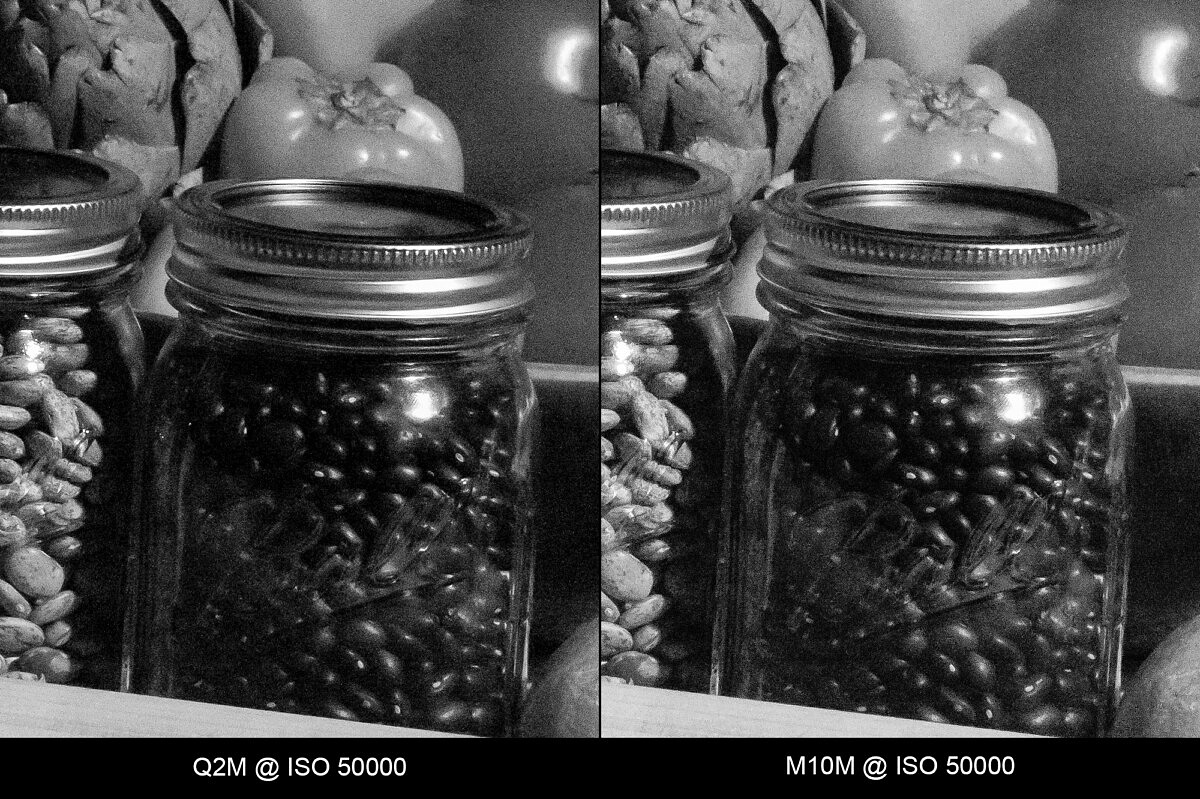
ISO 100000
Pushing the same maximum ISO of 100000, neither camera is showing off its best here. But, I think the M10 Monochrom managed to come back from behind to edge out the Q2M at its highest setting.
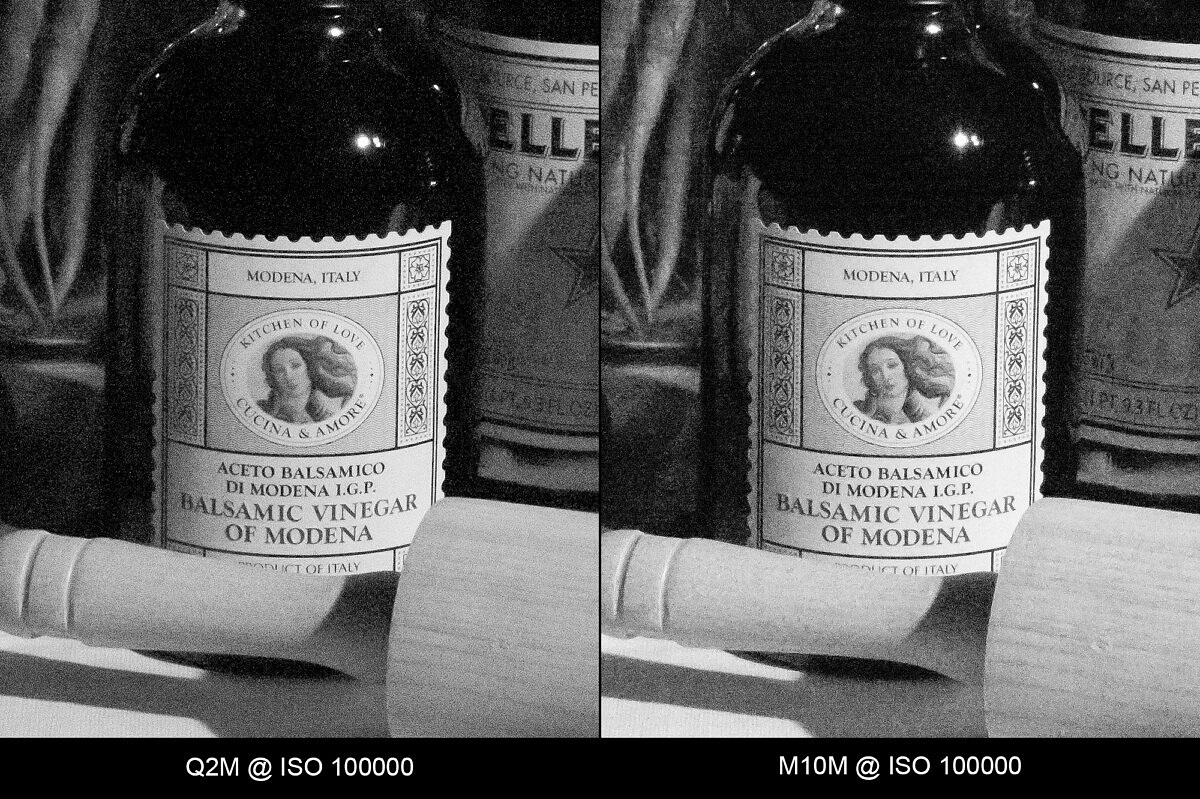
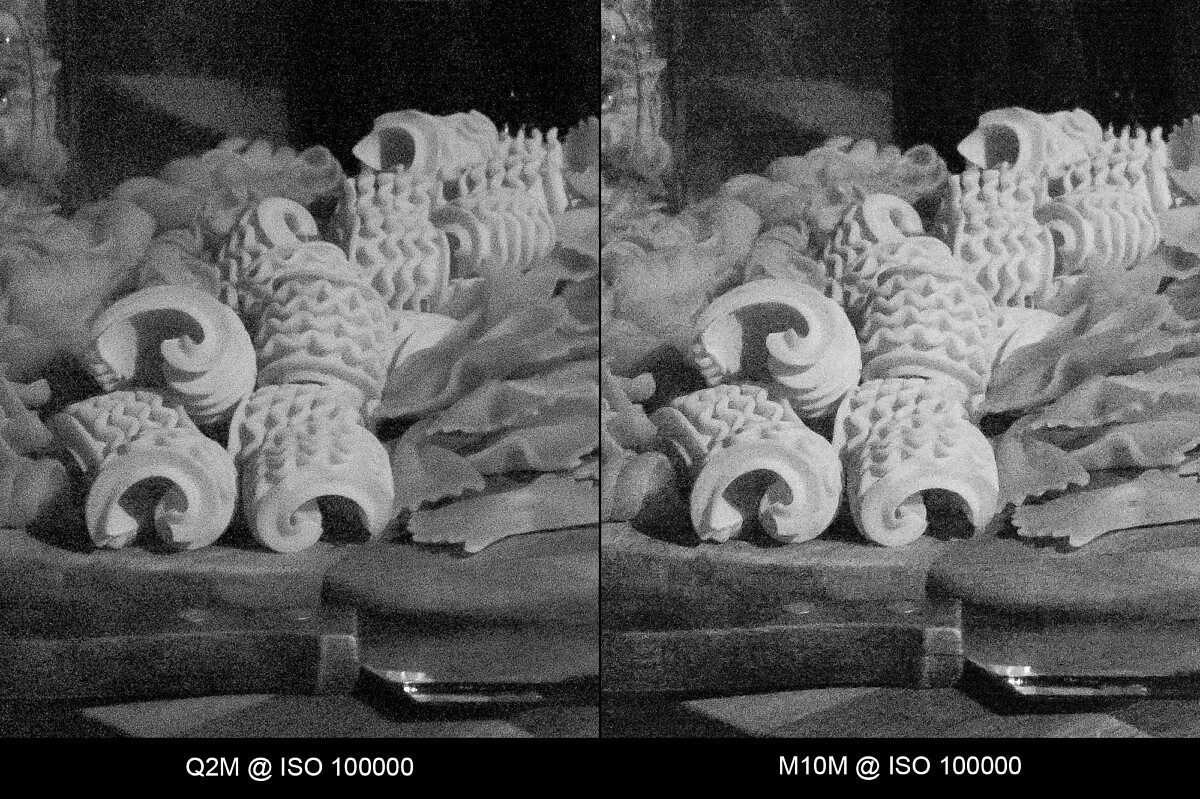
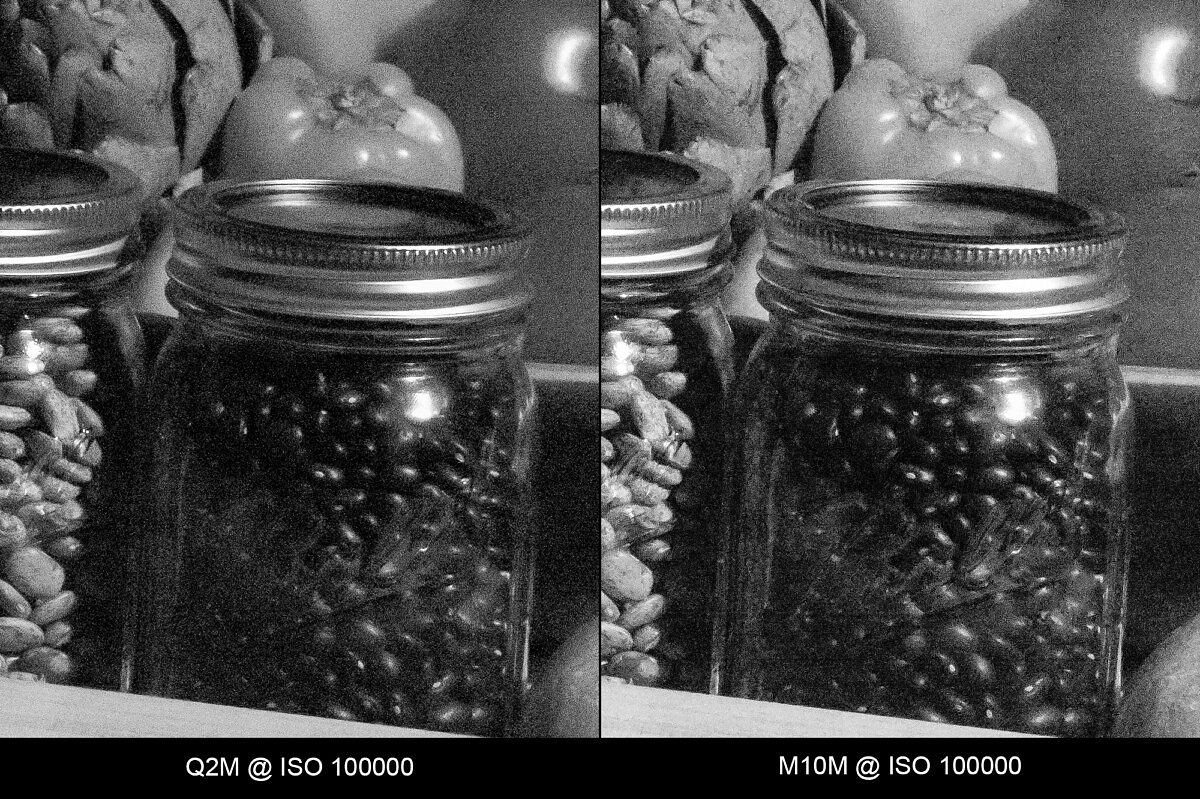
Ideal Maximums
Here is where things get even more interesting. From their respective peer comparisons, we already know each Monochrom's ideal maximums. And because the M10M allows for 1/3-stop ISO increments, we're able to squeeze just a little more juice out of it, besting the Q2M by a mere 1/3-stop. Setting that aside, with ideal maxes of ISO 25000 and ISO 32000, both the Q2M and M10M are simply insanely capable low light performers.
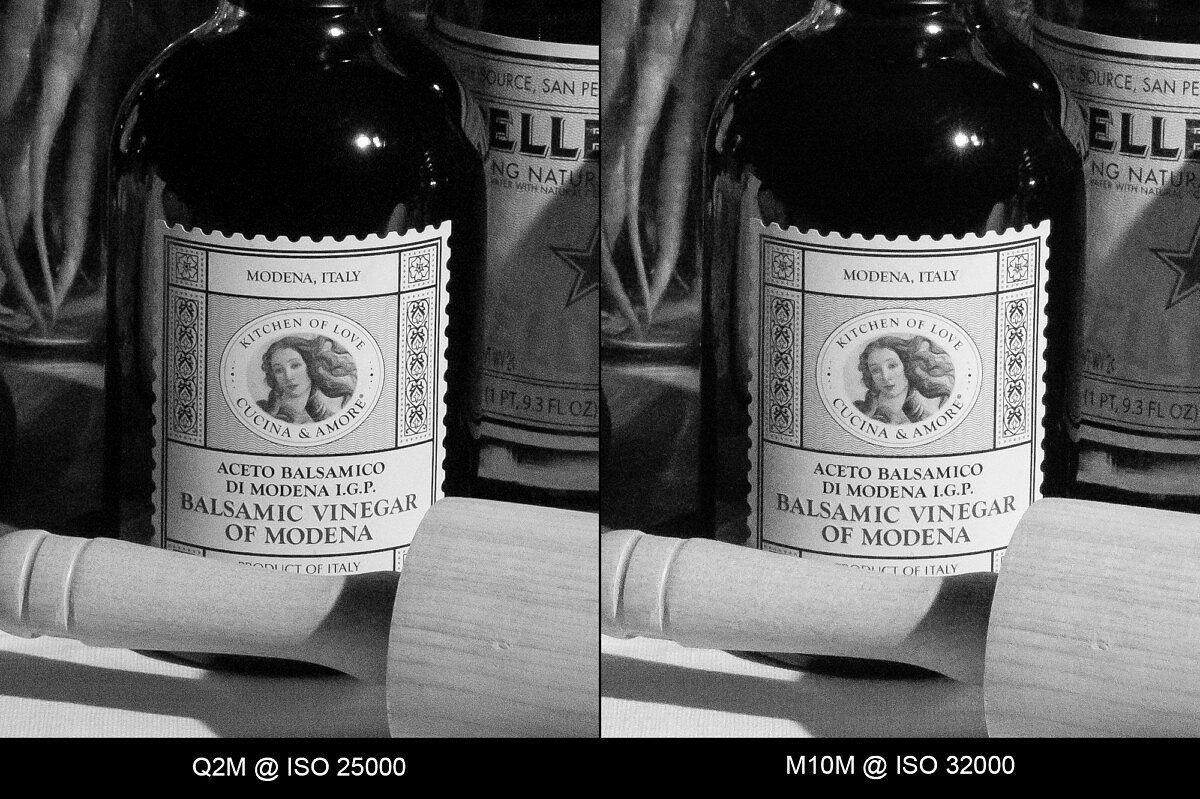
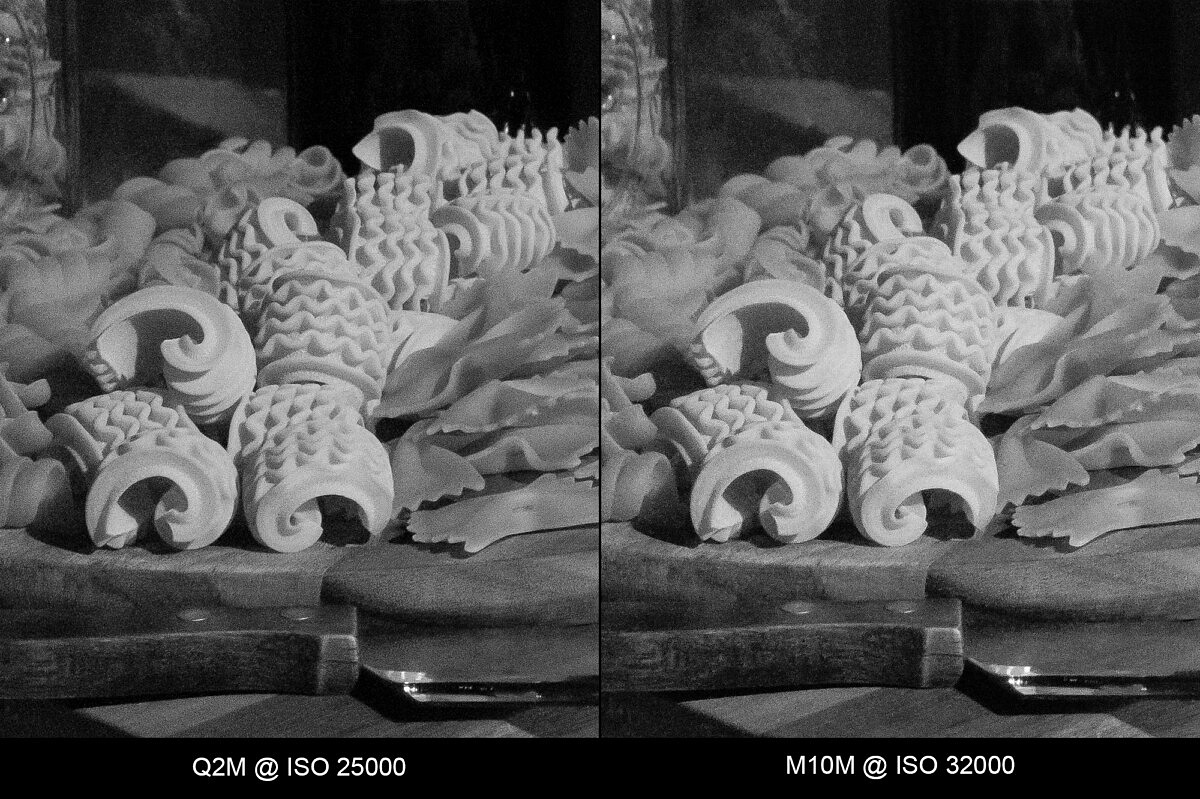
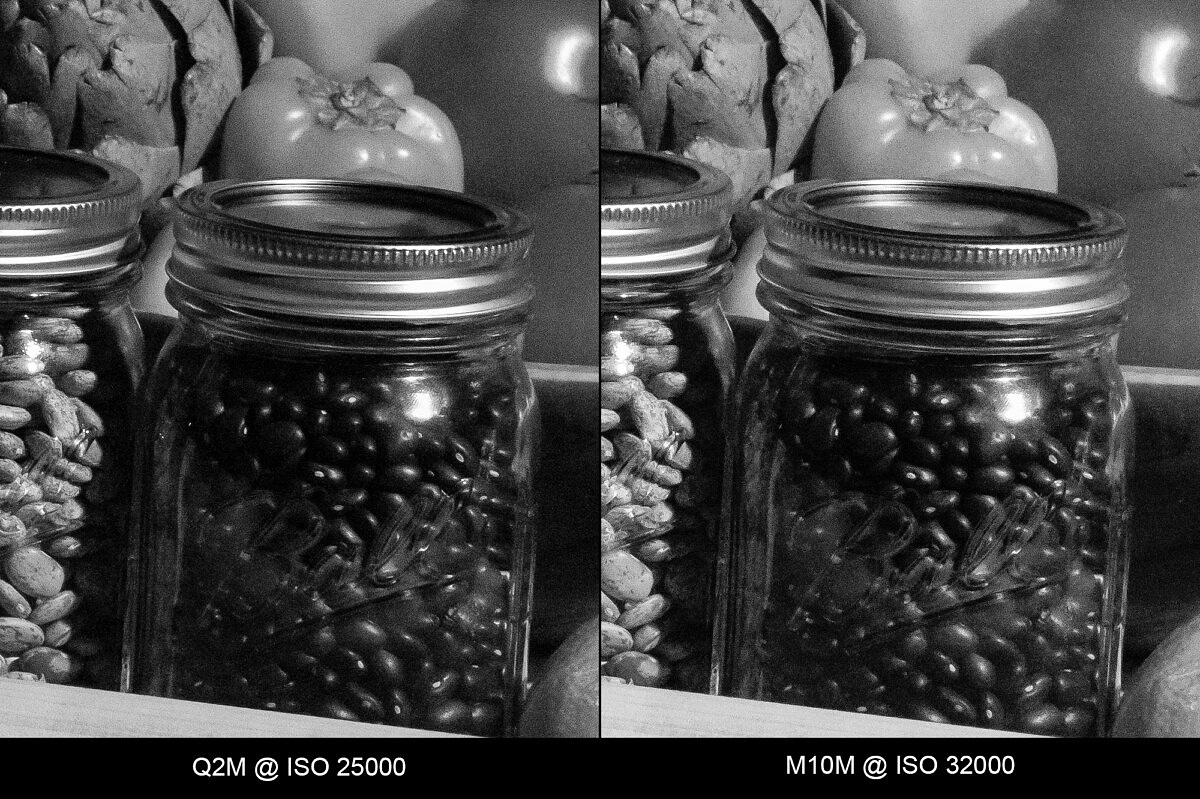
Final Thoughts
So, after all that exhaustive testing, what have we discovered? First, Leica has really pushed the performance envelope of its latest generation of cameras. Secondly, there continues to be no doubt that removing the color filter array from the sensor results in a very real and tangible advantage for high ISO shooting. The purpose-built Monochrom isn't just a gimmick. For black and white shooting, a Monochrom is demonstrably superior once you start venturing into the higher ISO ranges.
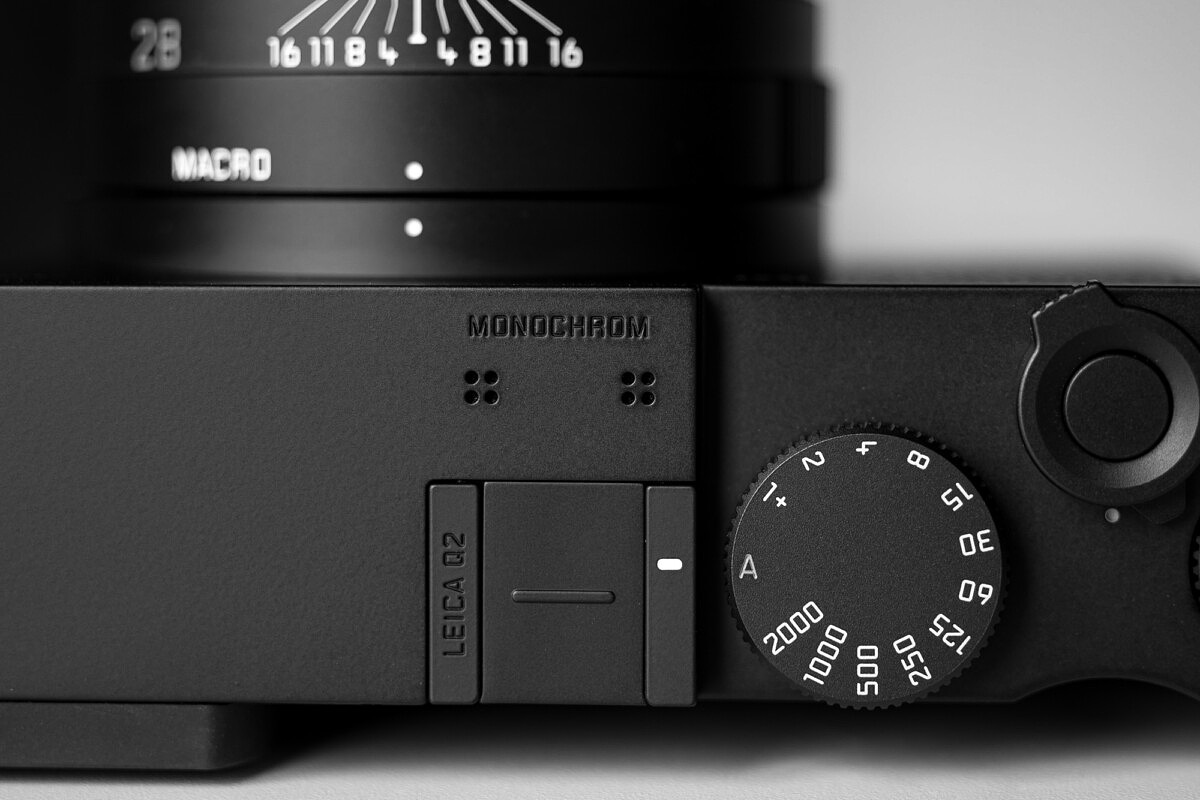
What surprised me most was just how well the Q2 Monochrom matched up against the M10 Monochrom. Both cameras produced exceptionally clean results up to ISO 6400 with ease. And they continued to trade blows back and forth all the way through ISO 100000. The Q2 Monochrom is priced at $5,995 and includes an exceptional 28mm Summilux lens. Compared to the M10 Monochrom at $8,195 with no lens, and $15,490 with the 28mm Summilux-M ASPH we used for testing, the Q2M is relative bargain. Of course, there are other factors to consider. The Q2M will always be a 28mm focal length camera, where the M10M offers greater flexibility with interchangeable lenses. And of course, while sharing a very similar design aesthetic and unified control interface, at the end of the day, the Q2M is an autofocus EVF camera and the M10M is a manual focus rangefinder.
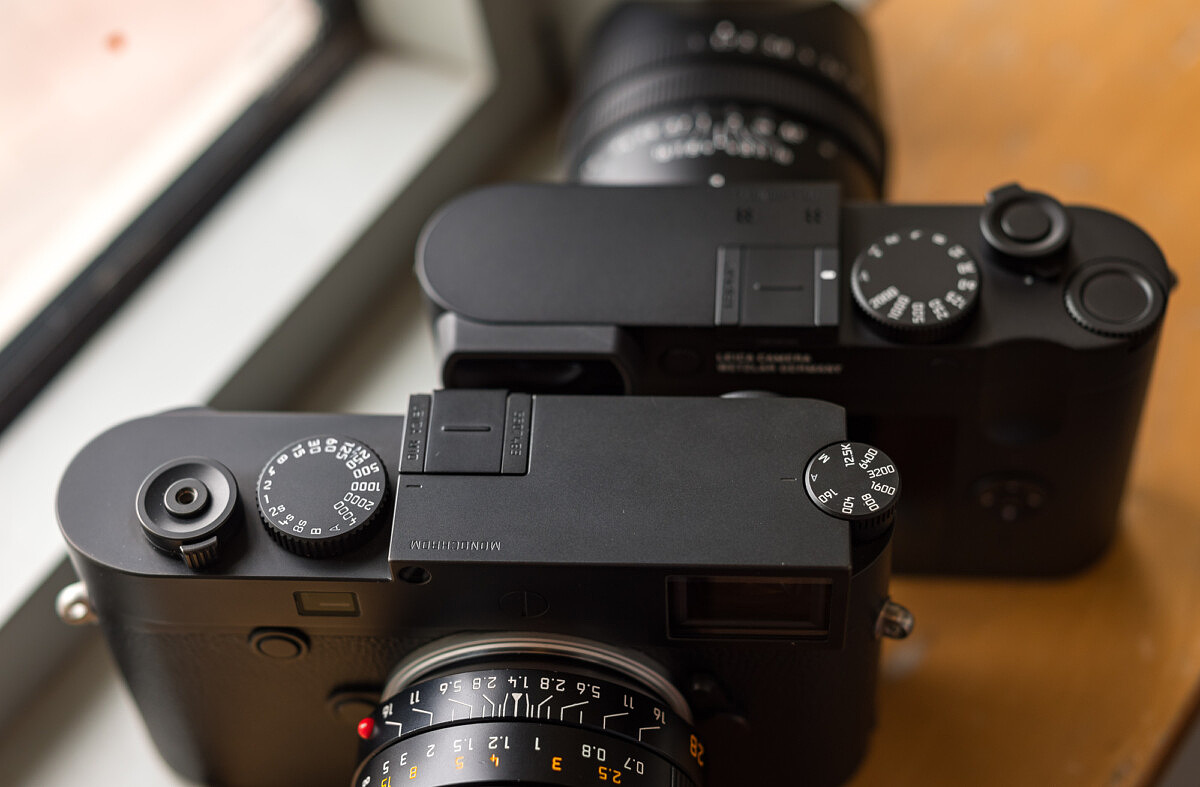
I think either Monochrom camera makes an ideal addition to a Leica kit. For SL2 shooters, the Q2M might make sore sense as no other lenses are required to get going and the cost of entry is much less. For those who already have an M setup, the M10M can leverage an existing lens collection. Or, a Q2M could offer a very different shooting experience, for about the same cost as an average M lens.
As for the color cameras, both turned out admirable results. If you don't need to venture beyond ISO 6400, either will serve you well. The M10-R has about a 1-stop low light advantage over the Q2, and at least equals the ISO performance of the lower resolution M10-P. Again, the choice of Q2 or M10-R comes back to autofocus EVF all-in-one versus a manual focus interchangeable lens rangefinder. These are very different cameras in use yet offer similar performance when put head-to-head.
Ultimately, my takeaway is that the tools available to us as photographers continues to improve. And with the latest generation of cameras, Leica has provided some truly impressive low light capabilities. The Q2 Monochrom and M10 Monochrom can lay equal claim the title of black and white high ISO champion. Now, just decide which serves your needs better and go shoot.

David, you really out did yourself on this interesting and exhaustive study. Congrats
Great test David. Thank you for doing such an exhaustive study!
Thanks, David. Great job as usual!
Bonjour,
Excellents tests, bravo.
Cependant, je regrette qu’on aborde pas les résultats quand on cropp! Merci
Thank you David for another terrific monochrom test. While I am still likely to purchase the M10-M to pair with my M10-P, the Q2 Monochrom is very compelling too!
Excellent job as usual. Your reviews are exhaustive and check all the boxes. Thank you for providing these tests.
David,
Your attention to detail and meticulous implementation meaningful testing is incredibly helpful to all that view this. You cover all bases for those wishing to understand all the strengths and weaknesses of the competing systems which allows the potential consumer to make the most informed decision as related to their individual need.
I applaud your dedication and willingness to share your depth of knowledge with the Leica family. Thank you so much for what you have done here. It is because of this sort of in depth and impartial information that has made me an exclusive Leica Miami customer since I have discovered you. The world of retail could all learn a thing or two from your outstanding business model.
David,
For jpeg images without post production, how much better is Q2M image right from camera at normal iso as compared to Q2 jpeg image using in camera monochrome mode?
Trying to chose between the two, and seeing if worth to give up color.
Thanks for this interesting report. Q2M is purchased. It exceeds my expectations in all areas. No comparison to the first generation Leica Monochrom. A great addition to my GFX100.
excelente .. David,, mis felicitaciones.. desde aqui en argentina donde no existe la posibilidad de alquilar las camaras para compararlas.. con este articulo…. ya quedas convencido cual camara comprar ..
Nicely done, very comprehensive review. I have an M10 and a slew of M lenses as well as some older Leicas (IIIf , M3, M6) and a Fujifilm system. I continue to have a soft spot for B&W images as that’s how I started 50+ years ago. Although I shoot Tri-X occasionally, I’m seriously considering picking up a used M10M or Q2M – this article and associated side-by-side analysis will be very helpful as I try to decide.
Thank you!
I greatly appreciate these showdowns, and extensive testing, however what I have found that in real life shooting dynamic range trumps low light performance. It seems that gradience affects image quality more than a stop or two of ISO performance. Another thing I would like to point out is that the sharper the lens, the more noise will appear in the photo, due to finder and crisper noise. I have B&W photos from an M8 at ISO 640 that could easily be mistaken from the output of an M10.
For photographers comparing high ISO performance and black & white image quality, the “Delta Executor” offers an insightful analysis, juxtaposing the Leica Q2 Monochrom, M10 Monochrom, Q2, and M10-R, providing a comprehensive understanding of each camera’s capabilities in low light conditions.
For photographers comparing high ISO performance and black & white image quality, the offers an insightful analysis, juxtaposing the Leica Q2 Monochrom, M10 Monochrom, Q2, and M10-R, providing a comprehensive understanding of each camera’s capabilities in low light conditions.